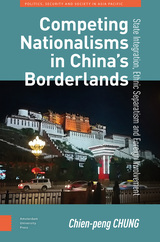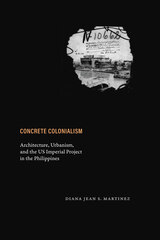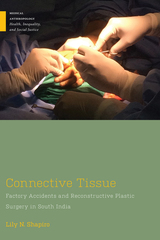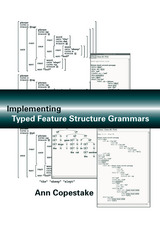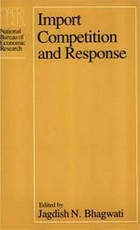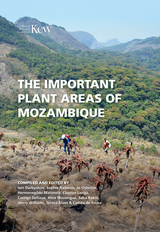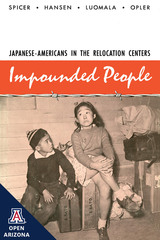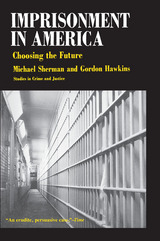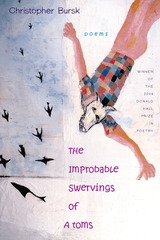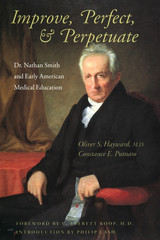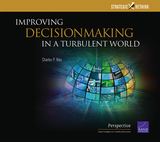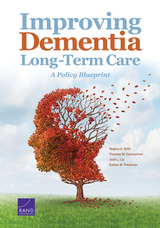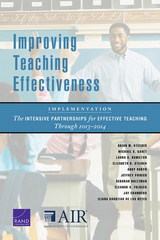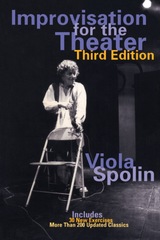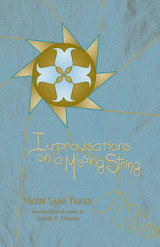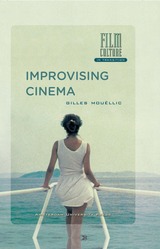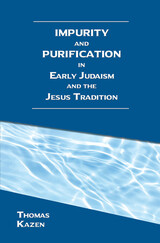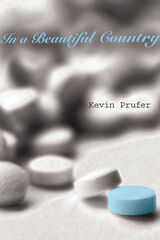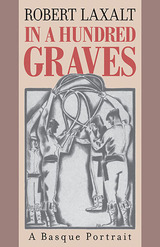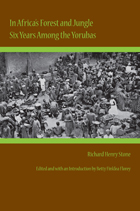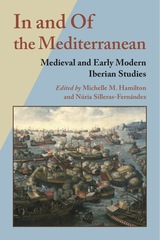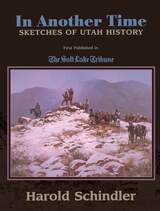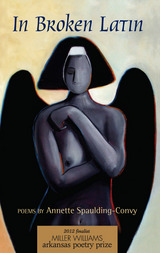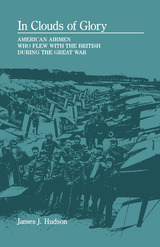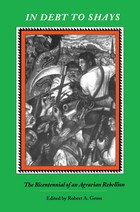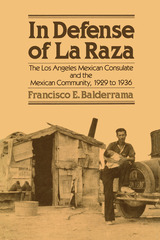 Imperialism in the Twentieth Century
A.P. Thornton
University of Minnesota Press, 1980
Imperialism in the Twentieth Century was first published in 1978. Minnesota Archive Editions uses digital technology to make long-unavailable books once again accessible, and are published unaltered from the original University of Minnesota Press editions.
"Nothing is filed under the heading 'imperialism' in the archives of any nation-state that owned an empire. Foreign affairs, or external relations, are catalogued there, and a place is found for imperial administration and colonial trade; but 'imperialism' is always a listing in someone else's index, never one's own. It is not the name a government uses to classify the policies it sets in motion. It is the name given them by those who adopt a particular attitude... In our time the attitude toward this control is hostile."
With these words A.P. Thornton takes on a complex and elusive term, imperialism,and pursues its meaning and implications in the years of imperial decline. The disappearance of territorial empire, according to Thornton, did not bring imperial impulses to an end, nor did it destroy the power relationships set up in the heyday of empire. Casting a cool eye on the claims of both imperialism and nationalism—the principal countervailing force—Thornton brings imagination, wide learning, and clarifying wit to bear upon a subject that remains significant in the last quarter of the twentieth century.
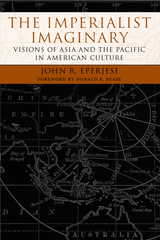 The Imperialist Imaginary: Visions of Asia and the Pacific in American Culture
John Eperjesi
Dartmouth College Press, 2014 In a groundbreaking work of “New Americanist” studies, John R. Eperjesi explores the cultural and economic formation of the Unites States relationship to China and the Pacific Rim in the nineteenth and twentieth centuries. Eperjesi examines a variety of texts to explore the emergence of what Rob Wilson has termed the “American Pacific.” Eperjesi shows how works ranging from Frank Norris’ The Octopus to the Journal of the American Asiatic Association, from the Socialist newspaper Appeal to Reason to the travel writings of Jack and Charmain London, and from Maxine Hong Kingston’s China Men to Ang Lee’s Crouching Tiger, Hidden Dragon—and the cultural dynamics that produced them—helped construct the myth of the American Pacific. By construing the Pacific Rim as a unified region binding together the territorial United States with the areas of Asia and the Pacific, he also demonstrates that the logic of the imperialist imaginary suggested it was not only proper but even incumbent upon the United States to exercise both political and economic influence in the region. As Donald E. Pease notes in his foreword, “by reading foreign policy and economic policy as literature, and by reconceptualizing works of American literature as extenuations of foreign policy and economic theory,” Eperjesi makes a significant contribution to studies of American imperialism.
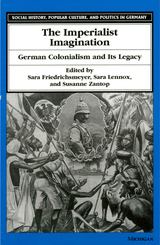 Imperialist Imagination: German Colonialism and Its Legacy
Sara Friedrichsmeyer, Sara Lennox, and Susanne Zantop, Editors
University of Michigan Press, 1998 "Race relations" are a controversial topic in today's Germany. Have Germans learned from the past? How far back must one go to understand the tensions, prejudices, and strategies that have marked race relations in the recently unified nation? The Imperialist Imagination explores the German preoccupation with racial and ethnic differences throughout the past two centuries, in a colonial and "postcolonial" context. Germany's belated national unification in 1870, its short colonial period (1884-1918), and the loss of its colonies as a consequence of World War I, rather than through wars of liberation, generated very different colonial and postcolonial conditions from those in Britain and France. This volume's sixteen essays investigate how, as a consequence of these conditions, Germans imagined their relationship to racial and ethnic others: how they supported and contested colonization during the colonial period, how their colonial fantasies fed into the Nazis' racial and expansionary policies after the loss of German colonies, and how they represent their relationship to German minorities and "foreigners" within and outside Germany today. The contributors include scholars in literature, history, art history, political science, philosophy, ethnography, film, popular culture, photography, and theater. The anthology will appeal not only to Germanists but to all those interested in postcolonial and cultural studies. Sara Friedrichsmeyer is Professor of German, University of Cincinnati. Sara Lennox is Professor of German, University of Massachusetts. Susanne Zantop is Professor of German and Comparative Literature, Dartmouth College.
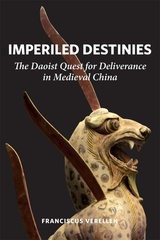 Imperiled Destinies: The Daoist Quest for Deliverance in Medieval China
Franciscus Verellen
Harvard University Press, 2019 Imperiled Destinies examines the evolution of Daoist beliefs about human liability and redemption over eight centuries and outlines ritual procedures for rescuing an ill‐starred destiny. From the second through the tenth century CE, Daoism emerged as a liturgical organization that engaged vigorously with Buddhism and transformed Chinese thinking about suffering, the nature of evil, and the aims of liberation. In the fifth century, elements of classical Daoism combined with Indian yogic practices to interiorize the quest for deliverance.
The medieval record portrays a world engulfed by evil, where human existence was mortgaged from birth and burdened by increasing debts and obligations in this world and the next. Against this gloomy outlook, Daoism offered ritual and sacramental instruments capable of acting on the unseen world, providing therapeutic relief and ecstatic release from apprehensions of death, disease, war, spoilt harvests, and loss. Drawing on prayer texts, liturgical sermons, and experiential narratives, Franciscus Verellen focuses on the Daoist vocabulary of bondage and redemption, the changing meanings of sacrifice, and metaphoric conceptualizations bridging the visible and invisible realms. The language of medieval supplicants envisaged the redemption of an imperiled destiny as debt forgiveness, and deliverance as healing, purification, release, or emergence from darkness into light.
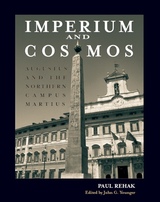 Imperium and Cosmos: Augustus and the Northern Campus Martius
Paul Rehak; Edited by John G. Younger
University of Wisconsin Press, 2006 Caesar Augustus promoted a modest image of himself as the first among equals (princeps), a characterization that was as popular with the ancient Romans as it is with many scholars today. Paul Rehak argues against this impression of humility and suggests that, like the monarchs of the Hellenistic age, Augustus sought immortality—an eternal glory gained through deliberate planning for his niche in history while flexing his existing power. Imperium and Cosmos focuses on Augustus’s Mausoleum and Ustrinum (site of his cremation), the Horologium-Solarium (a colossal sundial), and the Ara Pacis (Altar to Augustan Peace), all of which transformed the northern Campus Martius into a tribute to his major achievements in life and a vast memorial for his deification after death.
Rehak closely examines the artistic imagery on these monuments, providing numerous illustrations, tables, and charts. In an analysis firmly contextualized by a thorough discussion of the earlier models and motifs that inspired these Augustan monuments, Rehak shows how the princeps used these on such an unprecedented scale as to truly elevate himself above the common citizen.
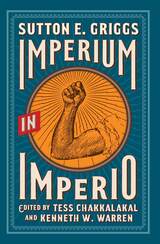 Imperium in Imperio
Sutton E. Griggs
West Virginia University Press, 2022 A new critical edition of Sutton Griggs’s turn-of-the-twentieth-century novel, which continues to shed light on understandings of Black politics.
Sutton E. Griggs’s first novel, originally published in 1899, paints a searing picture of the violent enforcement of disfranchisement and Jim Crow racial segregation. Based on events of the time, including US imperial policies, revolutionary movements, and racial protests, Imperium in Imperio introduces the fictional Belton Piedmont and Bernard Belgrave as “future leaders of their race” and uses these characters to make sense of the violence that marked the dawn of the twentieth century. Taking on contemporary battles over separatism and integration, Griggs’s novel continues to play a crucial role in understandings of Black politics.
Edited and introduced by Tess Chakkalakal and Kenneth W. Warren, this new critical edition offers not only an incisive biographical and historical introduction to the novel and its author but also a wealth of references that make the events and characters of Griggs’s Imperium in Imperio, and its aftermath, accessible to readers today.
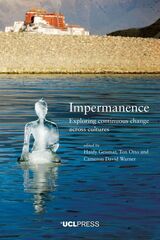 Impermanence: Exploring Continuous Change across Cultures
Edited by Haidy Geismar, Ton Otto, and Cameron David Warner
University College London, 2022 An exploration of the emergent social theory of flux and transformation through dialogue with non-Western traditions of thought.
Nothing lasts forever. This common experience can be the source of much anxiety, but also of hope. The concept of impermanence or continuous change opens up a range of timely questions and discussions that speak to globally shared experiences of transformation and concerns for the future. Impermanence engages with an emergent body of social theory that emphasizes flux and transformation and brings it into a dialogue with other traditions of thought and practice, such as Buddhism, that have sustained a long-lasting and sophisticated meditation on impermanence.
In cases drawn from all over the world, this volume investigates the significance of impermanence in such diverse contexts as social death, atheism, alcoholism, migration, ritual, fashion, oncology, museums, cultural heritage, and art. The authors draw on a wide range of disciplines, including anthropology, archaeology, art history, Buddhist studies, cultural geography, and museology. This volume also includes numerous photographs, artworks, and poems that evocatively communicate notions and experiences of impermanence.
 Impermanence: Life and Loss on Superior's South Shore
leaf
University of Minnesota Press, 2024 A personal journey through the ever-changing natural and cultural history of Lake Superior’s South Shore Lake Superior’s South Shore is as malleable as it is enduring, its red sandstone cliffs, clay bluffs, and golden sand beaches reshaped by winds and water from season to season—and sometimes from one hour to the next. Generations of people have inhabited the South Shore, harvesting the forests and fish, mining copper, altering the land for pleasure and profit, for better or worse. In Impermanence, author Sue Leaf explores the natural and human histories that make the South Shore what it is, from the gritty port city of Superior, Wisconsin, to the shipping locks at Sault Ste. Marie, Michigan. For Leaf, what began as a bicycling adventure on the coast of Lake Superior in 1977 turned into a lifelong connection with the area, and her experience, not least as owner of a rustic cabin on a rapidly eroding lakeside cliff, imbues these essays with a passionate sense of place and an abiding curiosity about its past and precarious future. As waves slowly consume the shoreline where her family has spent countless summers, Leaf is forced to confront the complexity of loving a place that all too quickly is being reclaimed by the great lake. Impermanence is a journey through the South Shore’s story, from the early days of the Anishinaabe and fur traders through the heyday of commercial fishing, lumber camps, and copper mining on the Keweenaw Peninsula to the awakening of the Northland to the perils and consequences of plundering its natural splendor. Noting the geological, ecological, and cultural features of each stop on her tour along the South Shore, Leaf writes about the restoration of the heavily touristed Apostle Islands National Lakeshore to its pristine conditions, even as Lake Superior maintains its allure for ice fishers, kayakers, and long-distance swimmers. She describes efforts to protect the endangered piping plover and to preserve the diverse sand dunes on the Michigan coast, and she observes the slough that supports rare intact wild rice beds central to Anishinaabe culture. Part memoir, part travelogue, part natural and cultural history, Leaf’s love letter to Lake Superior’s South Shore is an invitation to see this liminal world in all its seasons and guises, to appreciate its ageless, ever-changing wonders and intimate charms.
 Impermissible Punishments: How Prison Became a Problem for Democracy
Judith Resnik
University of Chicago Press, 2025 An original transatlantic history of the invention of the corrections profession and of ensuing debates about punishment’s purposes and prisoners’ rights. Impermissible Punishments explores the history of punishment inside prisons and how governments grappled with obligations to justify the punishments they impose. Legal scholar Judith Resnik charts the creation of the corrections profession and weaves together the stories of people who made rules for prisons and the stories of those living under the resulting regimes. Resnik maps three centuries of shifting ideas, norms, and legal standards aiming to draw lines between permissible and impermissible punishments. Her account documents the impact of World War II, the United Nations, the US Civil Rights movement, and the pioneering prisoners who insisted that law should protect their individual dignity. Taking us to the present, Resnik analyzes the expansion of imprisonment, the inability of public and private prisons to provide safe housing, and the impact of abolition politics. Exploring the interdependency of people in and out of prisons, Impermissible Punishments examines what governments committed to equality owe to the people they detain and argues that many contemporary forms of punishment need to end.
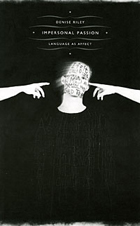 Impersonal Passion: Language as Affect
Denise Riley
Duke University Press, 2005 Denise Riley is renowned as a feminist theorist and a poet and for her remarkable refiguring of familiar but intransigent problems of identity, expression, language, and politics. In Impersonal Passion, she turns to everyday complex emotional and philosophical problems of speaking and listening. Her provocative meditations suggest that while the emotional power of language is impersonal, this impersonality paradoxically constitutes the personal. In nine linked essays, Riley deftly unravels the rhetoric of life’s absurdities and urgencies, its comforts and embarrassments, to insist on the forcible affect of language itself. She teases out the emotional complexities of such quotidian matters as what she ironically terms the right to be lonely in the face of the imperative to be social or the guilt associated with feeling as if you’re lying when you aren’t. Impersonal Passion reinvents questions from linguistics, the philosophy of language, and cultural theory in an illuminating new idiom: the compelling emotion of the language of the everyday.
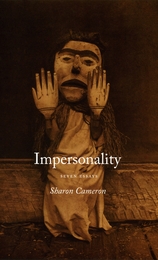 Impersonality: Seven Essays
Sharon Cameron
University of Chicago Press, 2007 Philosophers have long debated the subjects of person and personhood. Sharon Cameron ushers this debate into the literary realm by considering impersonality in the works of major American writers and figures of international modernism—writers for whom personal identity is inconsequential and even imaginary. In essays on William Empson, Jonathan Edwards, Ralph Waldo Emerson, Herman Melville, T. S. Eliot, and Simone Weil, Cameron examines the impulse to hollow out the core of human distinctiveness, to construct a voice that is no one’s voice, to fashion a character without meaningful attributes, a being that is virtually anonymous. “To consent to being anonymous,” Weil wrote, “is to bear witness to the truth. But how is this compatible with social life and its labels?” Throughout these essays Cameron examines the friction, even violence, set in motion from such incompatibility—from a “truth” that has no social foundation. Impersonality investigates the uncompromising nature of writing that suspends, eclipses, and even destroys the person as a social, political, or individual entity, of writing that engages with personal identity at the moment when its usual markers vanish or dissolve.
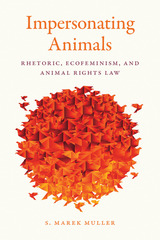 Impersonating Animals: Rhetoric, Ecofeminism, and Animal Rights Law
S. Marek Muller
Michigan State University Press, 2020 In 2011, in one sign of a burgeoning interest in the morality of human interactions with nonhuman animals, a panel hosted by the American Association for the Advancement of Science declared that dolphins and orcas should be legally regarded as persons. Multiple law schools now offer classes in animal law and have animal law clinics, placing their students with a growing range of animal rights and animal welfare advocacy organizations. But is legal personhood the best means to achieving total interspecies liberation? To answer that question, Impersonating Animals evaluates the rhetoric of animal rights activists Steven Wise and Gary Francione, as well as the Earth jurisprudence paradigm. Deploying a critical ecofeminist stance sensitive to the interweaving of ideas about race, gender, class, sexuality, ability, and species, author S. Marek Muller places animal rights rhetoric in the context of discourses in which some humans have been deemed more animal than others and some animals have been deemed more human than others. In bringing rhetoric and animal studies together, she shows that how we communicate about nonhuman beings necessarily affects relationships across species boundaries and among people. This book also highlights how animal studies scholars and activists can and should use ideological rhetorical criticism to investigate the implications of their tactics and strategies, emphasizing a critical vegan rhetoric as the best means of achieving liberation for human and nonhuman animals alike.
Implantation of the Ovum
Koji Yoshinaga
Harvard University Press, 1976 The exact process by which the fertilized mammalian ovum becomes implanted upon the uterine surface remains something of a mystery, and yet successful reproduction depends upon it. Two methods of contraception—the intrauterine device and the “morning-after pill”—are thought to be effective because they disrupt or prevent the process of implantation, but the biological basis of their effect is still imperfectly understood.
This book brings together authoritative accounts by leaders in the field of reproductive biology, researchers who have closely investigated implantation. The subject is approached from several angles: biochemical, endocrinological, pharmacological, anatomic, and immunological. A review of recent studies on implantation serves to put the individual reports in context. This book provides a needed perspective on an important area of reproduction research.
Implementation of Self-tuning Controllers
K. Warwick
The Institution of Engineering and Technology, 1988 This text is an extremely useful guide for those wishing to investigate the application of self-tuning control systems. The contents have been chosen in order to restrict the amount of theoretical detail to that necessary for explanation purposes, whilst application examples and programming suggestions are highlighted. The overall text is suitable for those wishing to gain the flavour of adaptive control, although those already familiar with selftuning techniques will find the problem solutions discussed to be most attractive. Parameter estimation, numerical solutions and software aspects are all considered at length, while simplified procedures and predictive self-tuning schemes are shown in terms of fundamental concepts.
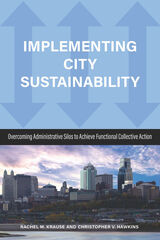 Implementing City Sustainability: Overcoming Administrative Silos to Achieve Functional Collective Action
Rachel M. Krause and Christopher V. Hawkins
Temple University Press, 2021 Implementing City Sustainability examines the structures and processes that city governments employ to pursue environmental, social, and economic well-being within their communities. As American cities adopt sustainability objectives, they are faced with the need to overcome fuzzy-boundary, coordination, and collective action challenges to achieve successful implementation. Sustainability goals often do not fit neatly into traditional city government structures, which tend to be organized around specific functional responsibilities, such as planning, public works, parks and recreation, and community development. The authors advance a theory of Functional Collective Action and apply it to local sustainability to explain how cities can—and in some cases do—organize to successfully administer changes to achieve complex objectives that transcend these organizational separations. Implementing City Sustainability uses a mixed-method research design and original data to provide a national overview of cities’ sustainability arrangements, as well as eight city case studies highlighting different means of organizing to achieve functional collective action. By focusing not just on what cities are doing to further sustainability, but also on how they are doing it, the authors show how administrative structure enables—or inhibits—cities to overcome functional divides and achieve successful outcomes.
 Implementing Collaborative Writing Tasks in Multilingual Classrooms
Mimi Li and Neomy Storch
University of Michigan Press, 2025 In recent decades, interest in implementing collaborative writing—having two or more writers work on a joint composition—has been propelled by rapid developments in social software and moves toward online teaching. Mimi Li and Neomy Storch have drawn from their extensive research and teaching expertise on collaborative writing to re-evaluate the pedagogical practices of collaborative writing and inform readers about how diverse ways of implementing collaborative writing (across modes, genres, tasks, learning contexts) can facilitate multilingual students’ language learning and writing development in the digital age. With clear visuals and concrete examples of different types of collaborative writing tasks—including multimodal writing and collaborative reading for writing tasks—the book invites readers to consider the kind of decisions that need to be taken when implementing collaborative writing (e.g., group size, how to allocate students) and when assessing collaborative writing. In connecting frontier pedagogical knowledge to practice, Implementing Collaborative Writing Tasks in Multilingual Classrooms will help educators to implement collaborative writing activities in their various contexts. Throughout the book, readers will find: - Research-informed, pedagogy-oriented lessons on why and how to implement and assess collaborative writing in multilingual classrooms.
- Cutting-edge pedagogical knowledge that distinguishes the different modes of implementing collaborative writing (e.g., face-to-face, via computer-mediated communication, and a hybrid approach).
- Key practical suggestions for teachers.
- Tips on how to incorporate artificial intelligence in collaborative writing activities.
- Recommendations for further research that can be helpful for practitioners, teacher educators, or graduate students.
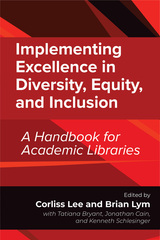 Implementing Excellence in Diversity, Equity, and Inclusion: A Handbook for Academic Libraries
Corliss Lee
American Library Association, 2022 “[T]he diversity of perspectives presented within this publication will build on the reader’s existing knowledge to bring nuances and alternative approaches to these enduring, seemingly intractable challenges within the LIS profession and within society.” — from the Foreword by Mark A. Puente Academic library workers often make use of systemic, bureaucratic, political, collegial, and symbolic dimensions of organizational behavior to achieve their diversity, equity, and inclusion goals, but many are also doing the crucial work of pushing back at the structures surrounding them in ways small and large. Implementing Excellence in Diversity, Equity, and Inclusion captures emerging practices that academic libraries and librarians can use to create more equitable and representative institutions. 19 chapters are divided into 6 sections: - Recruitment, Retention and Promotion
- Professional Development
- Leveraging Collegial Networks
- Reinforcing the Message
- Organizational Change
- Assessment
Chapters cover topics including active diversity recruitment strategies; inclusive hiring; gendered ageism; librarians with disabilities; diversity and inclusion with student workers; residencies and retention; creating and implementing a diversity strategic plan; cultural competency training; libraries’ responses to Canadian Truth and Reconciliation Commission Calls to Action; and accountability and assessment. Authors provide practical guiding principles, effective practices, and sample programs and training. Implementing Excellence in Diversity, Equity, and Inclusion explores how academic libraries have leveraged and deployed their institutions’ resources to effect DEI improvements while working toward implementing systemic solutions. It provides means and inspiration for continuing to try to hire, retain, and promote the change we want to see in the world regardless of existing structures and systems, and ways to improve those structures and systems for the future.
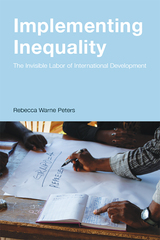 Implementing Inequality: The Invisible Labor of International Development
Rebecca Warne Peters
Rutgers University Press, 2020 Implementing Inequality argues that the international development industry’s internal dynamics—between international and national staff, and among policy makers, administrators, and implementers—shape interventions and their outcomes as much as do the external dynamics of global political economy. Through an ethnographic study in postwar Angola, the book demonstrates how the industry’s internal social pressures guide development’s methods and goals, introducing the innovative concept of the development implementariat: those in-country workers, largely but not exclusively “local” staff members, charged with carrying out development’s policy prescriptions. The implementariat is central to the development endeavor but remains overlooked and under-supported as most of its work is deeply social, interactive, and relational, the kind of work that receives less recognition and support than it deserves at every echelon of the industry. If international development is to meet its larger purpose, it must first address its internal inequalities of work and professional class.
 Implementing Innovation: Fostering Enduring Change in Environmental and Natural Resource Governance
Toddi A. Steelman
Georgetown University Press, 2010 Over the past three decades, governments at the local, state, and federal levels have undertaken a wide range of bold innovations, often in partnership with nongovernmental organizations and communities, to try to address their environmental and natural resource management tasks. Many of these efforts have failed. Innovations, by definition, are transitory. How, then, can we establish new practices that endure? Toddi A. Steelman argues that the key to successful and long-lasting innovation must be a realistic understanding of the challenges that face it. She examines three case studies—land management in Colorado, watershed management in West Virginia, and timber management in New Mexico—and reveals specific patterns of implementation success and failure. Steelman challenges conventional wisdom about the role of individual entrepreneurs in innovative practice. She highlights the institutional obstacles that impede innovation and its longer term implementation, while offering practical insight in how enduring change might be achieved.
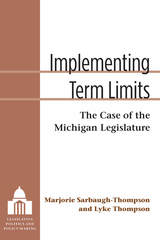 Implementing Term Limits: The Case of the Michigan Legislature
Marjorie Sarbaugh-Thompson and Lyke Thompson
University of Michigan Press, 2017 Today, 70 percent of the American public supports reforms that would limit the number of terms a state legislator may serve, and the advocacy group U.S. Term Limits promotes this reform at all levels of government. But are advocates correct that term limits ensure citizens dedicated to the common good—rather than self-serving career politicians—run government? Or does the enforced high rate of turnover undermine the legislature’s ability to function?
In Implementing Term Limits, Marjorie Sarbaugh-Thompson and Lyke Thompson bring thirteen years of intensive research and 460 interviews to assess changes since Michigan’s implementation of term limits in 1993 and explore their implications. Paying special attention to term limits’ institutional effects, they also consider legislative representation, political accountability, and the role of the bureaucracy and interest groups in state legislatures.
Their thorough study suggests that legislators are less accessible to officials and that there is a larger gap between legislators and their voters. Moreover, legislators become much more politically ambitious after term limits and spend more time on political activities. The selection of top chamber leaders is complicated by newcomers’ lack of knowledge about and experience working with the leaders they elect before being sworn in. As a result, term limits in Michigan fail to deliver on many of the “good government” promises that appeal to citizens.
Implementing Term Limits makes a unique and valuable contribution to the debate over the best means by which to obtain truly democratic institutions.
 Implementing the Constitution
Richard H. Fallon, Jr.
Harvard University Press, 2001 This book argues that the Supreme Court performs two functions. The first is to identify the Constitution's idealized "meaning." The second is to develop tests and doctrines to realize that meaning in practice. Bridging the gap between the two--implementing the Constitution--requires moral vision, but also practical wisdom and common sense, ingenuity, and occasionally a willingness to make compromises.
In emphasizing the Court's responsibility to make practical judgments, Implementing the Constitution takes issue with the two positions that have dominated recent debates about the Court's proper role. Constitutional "originalists" maintain that the Court's essential function is to identify the "original understanding" of constitutional language and then apply it deductively to current problems. This position is both unwise and unworkable, the book argues. It also critiques well-known accounts according to which the Court is concerned almost exclusively with matters of moral and constitutional principle.
Implementing the Constitution bridges the worlds of constitutional theory, political theory, and constitutional practice. It illuminates the Supreme Court's decision of actual cases and its development of well-known doctrines. It is a doctrinal study that yields jurisprudential insights and a contribution to constitutional theory that is closely tied to actual judicial practice.
 Implementing the Endangered Species Act on the Platte Basin Water Commons
David M. Freeman
University Press of Colorado, 2010 Water users of the Platte River Basin have long struggled to share this scarce commodity in the arid high plains, ultimately organizing collectively owned and managed water systems, allocating water along extensive stream systems, and integrating newer groundwater with existing surface-water uses. In 1973, the Endangered Species Act brought a new challenge: incorporating the habitat needs of four species-the whooping crane, piping plover, least tern, and pallid sturgeon-into its water-management agenda.
Implementing the Endangered Species Act on the Platte Basin Water Commons tells of the negotiations among the U.S. Department of the Interior, the environmental community, and the states of Wyoming, Colorado, and Nebraska that took place from the mid-1970s to 2006. Ambitious talks among rival water users, environmentalists, state authorities, and the Department of the Interior finally resulted in the Platte River Habitat Recovery Program.
Documenting how organizational interests found remedies within the conditions set by the Endangered Species Act, describing how these interests addressed habitat restoration, and advancing sociological propositions under which water providers transcended self-interest and produced an agreement benefiting the environment, this book details the messy process that took place over more than thirty years. Presenting important implications for the future of water management in arid and semi-arid environments, this book will be of interest to anyone involved in water management, as well as academics interested in the social organization of common property.
Implementing Typed Feature Structure Grammars
Ann Copestake
CSLI, 2001 Much of the work in modern formal linguistics is concerned with creating mathematically precise accounts of human languages—accounts that are particularly useful in research involving language processing with computers. Implementing Typed Feature Structure Grammars provides a student-level introduction to the most popular approach to this issue, and includes software that allows users to experiment with modeling different aspects of language.
Implications of Integrating Women into the Marine Corps Infantry
Agnes Gereben Schaefer
RAND Corporation, 2015 This study for the U.S. Marine Corps presents a historical overview of the integration of women into the U.S. military and explores the importance of cohesion and what influences it. The gender integration experiences of foreign militaries, as well as the gender integration efforts of domestic police and fire departments, are analyzed for insights into effective policies. The potential costs of integration are analyzed as well.
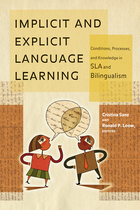 Implicit and Explicit Language Learning: Conditions, Processes, and Knowledge in SLA and Bilingualism
Cristina Sanz and Ronald P. Leow, Editors
Georgetown University Press, 2015 Over the last several decades, neuroscientists, cognitive psychologists, and psycholinguists have investigated the implicit and explicit continuum in language development and use from theoretical, empirical, and methodological perspectives. This book addresses these perspectives in an effort to build connections among them and to draw pedagogical implications when possible. The volume includes an examination of the psychological and neurological processes of implicit and explicit learning, what aspects of language learning can be affected by explicit learning, and the effects of bilingualism on the mental processing of language. Rigorous empirical research investigations probe specific aspects of acquiring morphosyntax and phonology, including early input, production, feedback, age, and study abroad. A final section explores the rich insights provided into language processing by bilingualism, including such major areas as aging, third language acquisition, and language separation.
Implicit/Explicit
Stephanie Gioia
A2RU Intervals, 2018 A2RU research, aligned with previous scholarship, notes the need to render explicit the unspoken expectations, assumptions, and definitions involved in the reappointment, tenure, and promotion process. The Implicit/Explicit card deck is a hands-on tool to assist teams who are charged with tenure and promotion policy to accomplish this very task. Developed for and tested in our Tenure and Promotion Workshops, the deck also helps reveal latent biases that may affect equity and inclusion efforts. Play reveals which elements of an institution’s reappointment, tenure, and promotion practices are explicitly addressed in policy and which remain tacit, and helps players recognize the cultural biases present in institutional norms, processes, and policies when they are not made explicit. Additionally, the color-coded cards helps participants identify the roles and processes that are most relevant to them.
The Implosion of Capitalism
Samir Amin
Pluto Press, 2014 In The Implosion of Capitalism world-renowned political economist Samir Amin connects the key events of our times – financial crisis, Eurozone implosion, the emerging BRIC nations and the rise of political Islam – identifying them as symptoms of a profound systemic crisis.
In light of these major crises and tensions, Amin updates and modifies the classical definitions of social classes, political parties, social movements and ideology. In doing so he exposes the reality of monopoly capitalism in its contemporary global form.
In a bravura conclusion, Amin argues that the current capitalist system is not viable and that implosion is unavoidable. The Implosion of Capitalism makes clear the stark choices facing humanity – and the urgent need for a more humane global order.
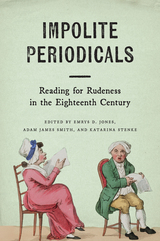 Impolite Periodicals: Reading for Rudeness in the Eighteenth Century
Emrys D. Jones
Bucknell University Press, 2026 Studies of the eighteenth-century periodical have long tended to understand the form according to the period’s own insistence on adhering to and promoting politeness. In contrast, this collection reads for impoliteness, revealing a more nuanced, granular, and dynamic view of eighteenth-century periodicals such as Addison and Steele’s popular The Spectator, and a fuller sense of their value within the societies that produced and consumed them. By inverting the traditional focus, this volume promotes a new history of the periodical characterized not as highbrow gatekeeper of literary taste, but as incongruent, idiosyncratic, and impolite. Impolite Periodicals thus brings together a range of perspectives on eighteenth-century periodical publication, not simply to argue that periodicals could be impolite, but to explore how readings of their potential impoliteness might affect our understanding of their literary and social significance. This collection relishes and lingers on signs of rudeness, inconsistency, impurity, and failure.
With an afterword by Manushag N. Powell.
Published by Bucknell University Press. Distributed worldwide by Rutgers University Press.
Import Competition and Response
Edited by Jagdish Bhagwati
University of Chicago Press, 1982 These papers, by a number of leading international-trade theorists, present the first significant theoretical work to be done on a topic of considerable interest, import competition. Nine theoretical papers, on topics ranging from protectionist lobbying to adjustment costs, are synthesized in the editor's Introduction, which also contrasts these contributions with the traditional classroom analysis of import competition. Three major empirical studies close the volume. It will prove indispensable for anyone who wishes to think clearly about import competition and about how economies do—and should—respond to it.
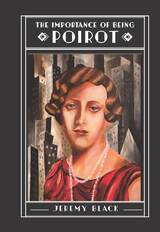 The Importance of Being Poirot
Jeremy Black
St. Augustine's Press, 2021 Written by the renowned British historian who has been described as both utterly thorough and humanely delicate, Jeremy Black offers a guided tour through the mind of Agatha Christie and life during the Great World Wars. His incomparable treatment of literary craft developing alongside global military engagement nearly overshadows the natural draw of the crime drama that is the subject of his book. Indeed, the “prurience and sensationalism” of crime is not as exciting as Black’s aptitude for drawing the reality from the fiction (and periphery sources), giving Christie a much louder voice than she might ever have dreamed. If Christie is also moralist and mirror to her times, Black here plays his part as the detective and reveals layers of previously unmined truths in her stories.
Hercule Poirot as a character is masterfully imagined, but Black shows us how he is inseparable from Christie’s turbulent and changing world. He also illuminates significant social commentary in Christie’s fiction, and in so doing Black often uses his authority to vindicate Christie’s work from hastily, at times stupidly, applied labels and interpretations. He is especially magnificent in his chapters, “Xenophobia” and “The Sixties.” Black nevertheless gives due recognition to Christie’s critics when they have something relevant and reasonable to say, and hence the reader finds yet another service in Black’s comprehensive review of the reviewers over the expanse of Christie’s writing career.
For all this, Black proves himself to be a worthy history-teller because he can aptly ‘detect’ the meaning of stories that seeks to answer the past and guide the present. His erudition runs much deeper than his ability to navigate the stores of resources available on the subject, and the reader gets a glimpse of this early on when in the introduction he proffers his own defense for writing about the importance of a Hercule Poirot. Black writes, “the notion of crime had a moral component from the outset, and notably so in terms of the struggle between Good and Evil, and in the detection of the latter. Indeed, it is this detection that is the basis of the most powerful strand of detection story, because Evil disguises its purposes. It has to do so in a world and humanity made fundamentally benign and moral by God.” The Golden Age of detective novels represents much more than a triumph of a literary genre. It is in its own right a story of how the challenge to address the problem of evil was accepted. Its convergence with the plot-rich narrative of the twentieth century in the modern age renders Black’s account a thrilling masterpiece, seducing historians to read fiction and crime junkies to read more history.
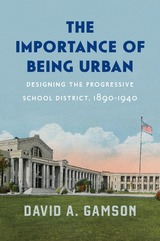 The Importance of Being Urban: Designing the Progressive School District, 1890-1940
David A. Gamson
University of Chicago Press, 2019 From the 1890s through World War II, the greatest hopes of American progressive reformers lay not in the government, the markets, or other seats of power but in urban school districts and classrooms. The Importance of Being Urban focuses on four western school systems—in Denver, Oakland, Portland, and Seattle—and their efforts to reconfigure public education in the face of rapid industrialization and the perceived perils [GDA1] of the modern city. In an era of accelerated immigration, shifting economic foundations, and widespread municipal shake-ups, reformers argued that the urban school district could provide the broad blend of social, cultural, and educational services needed to prepare students for twentieth-century life. These school districts were a crucial force not only in orchestrating educational change, but in delivering on the promise of democracy. David A. Gamson’s book provides eye-opening views of the histories of American education, urban politics, and the Progressive Era.
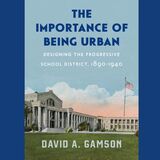 The Importance of Being Urban: Designing the Progressive School District, 1890-1940
David A. Gamson
University of Chicago Press, 2019 This is an auto-narrated audiobook version of this book.
From the 1890s through World War II, the greatest hopes of American progressive reformers lay not in the government, the markets, or other seats of power but in urban school districts and classrooms. The Importance of Being Urban focuses on four western school systems—in Denver, Oakland, Portland, and Seattle—and their efforts to reconfigure public education in the face of rapid industrialization and the perceived perils of the modern city. In an era of accelerated immigration, shifting economic foundations, and widespread municipal shake-ups, reformers argued that the urban school district could provide the broad blend of social, cultural, and educational services needed to prepare students for twentieth-century life. These school districts were a crucial force not only in orchestrating educational change, but in delivering on the promise of democracy. David A. Gamson’s book provides eye-opening views of the histories of American education, urban politics, and the Progressive Era.
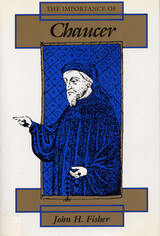 The Importance of Chaucer
John H. Fisher
Southern Illinois University Press, 1992
In this fresh and innovative approach, John H. Fisher eloquently explains Chaucer’s importance to Western culture.
English literature begins with Chaucer. The first writer to demonstrate that English was as effective a medium for literature as Latin or French, Chaucer introduced realism, satire, and humor into English writing. In examining Chaucer’s cultural importance, however, Fisher ventures beyond literary excellence, basing his cultural interpretation on inferences about Chaucer’s domestic life, about his possible experience in the inns of chancery and inns of court, and about the possibility that Henry V and the Lancastrian government sought deliberately to promote Chaucer’s poems as models of what could be accomplished in the vernacular.
Fisher’s willingness to boldly infer from the scant evidence available allows him to place Chaucer in the poet’s, and our, culture in a way he has not been placed before. By attributing to Chaucer innovations to which other writers have only alluded, and by reaching conclusions which others have been hesitant to approach, Fisher presents an interpretation at once controversial, engaging, and informative.
The Importance of Elsewhere: The Globalist Humanist Tourist
Randy Malamud
Intellect Books, 2018 Why do we travel? What are we doing—and what do we imagine we are doing—when we leave the house, get on a plane, and thereby step into globalism? The Importance of Elsewhere is a collection of essays, rooted in Randy Malamud’s own lifetime of travel, that addresses those questions and more. Setting today’s tourism in the context of eighteenth- and nineteenth-century experiences of travel and travel writing, he uncovers motives and appreciations of movement, difference, and novelty that are deeply woven into the imperial enterprise—and that remain key drivers of our interest in and enjoyment of travel today. Marrying concrete case studies and lively personal anecdotes, The Importance of Elsewhere will be of interest to any global traveler who has ever stopped to wonder what it is that draws her to faraway places.
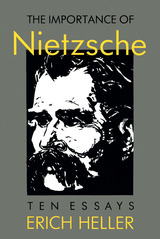 The Importance of Nietzsche
Erich Heller
University of Chicago Press, 1988 In this book, one of the most distinguished scholars of German culture collects his essays on a figure who has long been one of his chief preoccupations. Erich Heller's lifelong study of modern European literature necessarily returns again and again to Friedrich Nietzsche.
Nietzsche prided himself on having broken with all traditional ways of thinking and feeling, and once even claimed that he would someday be recognized for having ushered in a new millennium. While acknowledging Nietzsche's radicalism, Heller also insists on the continuity of the story in which he does indeed occupy a central place. By considering Nietzsche in relation to Goethe, Rilke, Wittgenstein, Yeats, and others, Heller shows the philosopher's ambivalence toward the tradition he inherited as well as his profound effect on the thought and sensibility of those who followed him. It is hardly an exaggeration to say, as Heller does in his first essay, that Nietzsche is to many modern writers and thinkers—including Mann, Musil, Kafka, Freud, Heidegger, Jaspers, Gide, and Sartre—what St. Thomas Aquinas was to Dante: the categorical interpreter of a world, which they contemplate imaginatively and theoretically without ever much upsetting its Nietzschean structure.
Thus it is Nietzsche's thought, so pervasively present in the themes of modernity, that gives coherence and unity to Heller's essays. What emerges from them is that, despite his iconoclastic declarations and unorthodox philosophical practices, Nietzsche deals with the human spirit's persistent concerns. His questions remain urgent, and even the answers, in all their contradictoriness, possess the commanding force of his inquiry. An example is the incompatibility of the famous extremes, the teaching of the Übermensch and the Eternal Recurrence of All Things. These cancel each other out and yet grow from the same intellectual and spiritual roots, as is shown lucidly and cogently by one of Heller's most forceful essays, "Nietzsche's Terrors: Time and the Inarticulate." In fathoming the depth of this contradiction, Heller at the same time reveals the importance of Nietzsche for those who seek to understand the wellsprings of the epoch's disquiet, turmoil, and creativity.
The Important Plant Areas of Mozambique
Edited by Iain Darbyshire, Sophie Richards, and Jo Osborne
Royal Botanic Gardens, Kew, 2023 An assessment of fifty critical sites for plant conservation.
The Important Plant Areas of Mozambique is based on the Mozambique TIPAs project run in collaboration between Royal Botanic Gardens, Kew, Mozambique’s Agricultural Research Institute (Instituto de Investigação Agrária de Moçambique – IIAM), and the University Eduardo Mondlane. Drawing on information from the TIPAs database, The Important Plant Areas of Mozambique includes color maps and photographs, site descriptions, and tables to present information on the botanical significance, habitat, and geology of the region. The book will also address conservation issues and ecosystem services to promote Mozambique’s critical plant sites and inform conservation leaders in government, NGOs, universities, and local communities about Mozambique’s threatened habitats.
 Importing Care, Faithful Service: Filipino and Indian American Nurses at a Veterans Hospital
Stephen M. Cherry
Rutgers University Press, 2022 Every year thousands of foreign-born Filipino and Indian nurses immigrate to the United States. Despite being well trained and desperately needed, they enter the country at a time, not unlike the past, when the American social and political climate is once again increasingly unwelcoming to them as immigrants. Drawing on rich ethnographic and survey data, collected over a four-year period, this study explores the role Catholicism plays in shaping the professional and community lives of foreign-born Filipino and Indian American nurses in the face of these challenges, while working at a Veterans hospital. Their stories provide unique insights into the often-unseen roles race, religion and gender play in the daily lives of new immigrants employed in American healthcare. In many ways, these nurses find themselves foreign in more ways than just their nativity. Seeing nursing as a religious calling, they care for their patients, both at the hospital and in the wider community, with a sense of divine purpose but must also confront the cultural tensions and disconnects between how they were raised and trained in another country and the legal separation of church and state. How they cope with and engage these tensions and disconnects plays an important role in not only shaping how they see themselves as Catholic nurses but their place in the new American story.
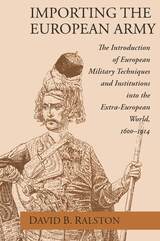 Importing the European Army: The Introduction of European Military Techniques and Institutions in the Extra-European World, 1600-1914
David B. Ralston
University of Chicago Press, 1996 In a study that extends well beyond military history, David B. Ralston documents the ways in which five different countries—Russia, the Ottoman Empire, Egypt, China, and Japan—refashioned their armed forces along European lines during the three centuries after 1600. The appropriation of Western military institutions in countries outside of Europe was, Ralston argues, the major force driving these countries to adopt European administrative, economic, and cultural modes.
Following the same format in his discussion of each country, Ralston makes this central theme in world history easily accessible to students while offering scholars a sophisticated understanding of the exact nature of the changes brought about by Europeanizing military reforms.
David B. Ralston, associate professor of history at the Massachusetts Institute of Technology, is the author of The Army of the Republic.
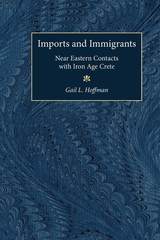 Imports and Immigrants: Near Eastern Contacts with Iron Age Crete
Gail L. Hoffman
University of Michigan Press, 1998 While scholars have long acknowledged the importance of artistic relationships between ancient Greece and the Near East, recent discourse on multi-culturalism and diversity has ignited new debate over these issues both among scholars and in the broader public. Charges and countercharges of historical revisionism and systematic undervaluation of the debt owed by ancient Greece to the Near East and Africa have polarized the debate and obscured the actual evidence. In Imports and Immigrants, Gail L. Hoffman explores the primary archaeological basis for such discussions, namely the preserved physical remains, providing a foundation for constructive discussion of the relations and exchanges between ancient Greece and the Near East.
Drawing together all the evidence and arguments for Near Eastern immigrants in Crete, Hoffman demonstrates there are basic problems with the accepted interpretations. Evidence of continued technical expertise casts doubt on the necessity of reintroduction, while careful scrutiny of the evidence supporting immigrant craftsmen reveals many inadequacies in the currently accepted analyses.
Imports and Immigrants identifies the need for reassessing all dimensions of the question of artistic relationships between ancient Greece and other regions of the Aegean basin and suggests new avenues of inquiry in this important debate. The volume also reassesses arguments made for the presence of Near Eastern immigrants in Crete. This book includes a catalogue indispensable for future work on these issues and illustrations of most of the known imports to Crete.
Gail L. Hoffman is Associate Professor of Greek Art and Archaeology, Department of Classics, Yale University.
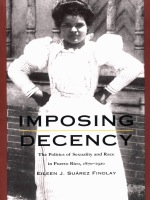 Imposing Decency: The Politics of Sexuality and Race in Puerto Rico, 1870–1920
Eileen J. Suárez Findlay
Duke University Press, 2000 Feminists, socialists, Afro-Puerto Rican activists, and elite politicians join laundresses, prostitutes, and dissatisfied wives in populating the pages of Imposing Decency. Through her analyses of Puerto Rican anti-prostitution campaigns, attempts at reforming marriage, and working-class ideas about free love, Eileen J. Suárez Findlay exposes the race-related double standards of sexual norms and practices in Puerto Rico between 1870 and 1920, the period that witnessed Puerto Rico’s shift from Spanish to U.S. colonialism.
In showing how political projects and alliances in Puerto Rico were affected by racially contingent definitions of “decency” and “disreputability,” Findlay argues that attempts at moral reform and the state’s repression of “sexually dangerous” women were weapons used in batttles between elite and popular, American and Puerto Rican, and black and white. Based on a thorough analysis of popular and elite discourses found in both literature and official archives, Findlay contends that racialized sexual norms and practices were consistently a central component in the construction of social and political orders. The campaigns she analyzes include an attempt at moral reform by elite male liberals and a movement designed to enhance the family and cleanse urban space that ultimately translated into repression against symbollically darkened prostitutes. Findlay also explores how U.S. officials strove to construct a new colonial order by legalizing divorce and how feminist, labor, and Afro-Puerto Rican political demands escalated after World War I, often focusing on the rehabilitation and defense of prostitutes.
Imposing Decency forces us to rethink previous interpretations of political chronologies as well as reigning conceptualizations of both liberalism and the early working-class in Puerto Rico. Her work will appeal to scholars with an interest in Puerto Rican or Latin American studies, sexuality and national identity, women in Latin America, and general women’s studies.
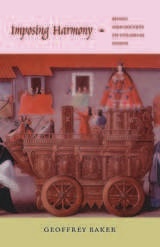 Imposing Harmony: Music and Society in Colonial Cuzco
Geoffrey Baker
Duke University Press, 2008 Imposing Harmony is a groundbreaking analysis of the role of music and musicians in the social and political life of colonial Cuzco. Challenging musicology’s cathedral-centered approach to the history of music in colonial Latin America, Geoffrey Baker demonstrates that rather than being dominated by the cathedral, Cuzco’s musical culture was remarkably decentralized. He shows that institutions such as parish churches and monasteries employed indigenous professional musicians, rivaling Cuzco Cathedral in the scale and frequency of the musical performances they staged. Building on recent scholarship by social historians and urban musicologists and drawing on extensive archival research, Baker highlights European music as a significant vehicle for reproducing and contesting power relations in Cuzco. He examines how Andean communities embraced European music, creating an extraordinary cultural florescence, at the same time that Spanish missionaries used the music as a mechanism of colonialization and control. Uncovering a musical life of considerable and unexpected richness throughout the diocese of Cuzco, Baker describes a musical culture sustained by both Hispanic institutional patrons and the upper strata of indigenous society. Mastery of European music enabled elite Andeans to consolidate their position within the colonial social hierarchy. Indigenous professional musicians distinguished themselves by fulfilling important functions in colonial society, acting as educators, religious leaders, and mediators between the Catholic Church and indigenous communities.
 Imposing Order without Law: American Expansion to the Eastern Sierra, 1850–1865
Michael J. Makley
University of Nevada Press, 2022 In the 1850s, early Euro-American settlers established two remote outposts on the slopes of the eastern Sierra Nevada, both important way stations on the central emigrant trail. The Carson Valley settlement was located on the western edge of the Utah Territory, while the Honey Lake Valley hamlet, 120 miles north, fell within California’s boundaries but was separated from the rest of the state by the formidable mountain range. Although these were some of the first white communities established in the region, both areas had long been inhabited by Indigenous Americans. Carson Valley had been part of Washoe Indian territory, and Honey Lake Valley was a section of Northern Paiute land.
Michael Makley explores the complexities of this turbulent era, when the pioneers’ actions set the stage for both valleys to become part of national incorporation. With deft writing and meticulously researched portrayals of the individuals involved, including the Washoe and Northern Paiute peoples, Imposing Order Without Law focuses on the haphazard evolution of “frontier justice” in these remote outposts. White settlers often brought with them their own ideas of civil order. Makley’s work contextualizes the extralegal acts undertaken by the settlers to enforce edicts in their attempt to establish American communities.
Makley’s book reveals the use and impact of group violence, both within the settlements and within the Indigenous peoples’ world, where it transformed their lives.
 An Impossibility of Crows: A Novel
Kirsten Kaschock
University of Massachusetts Press, 2026 A story of mothers, monsters, and the science of longing
In this daring and evocative tale, Agnes Krahn, a chemist trained in Philadelphia, returns to her childhood home after the death of her father. Just a stone's throw from the haunted fields of Gettysburg, the small town of Letort, Pennsylvania is where the Krahn family has lived for six generations—bound by twisted folk wisdom and an uncanny kinship with the crows that loom over their land.
Back in the grim farmhouse of her youth, Agnes is drawn into the strange legacy she tried to leave behind. When she discovers an abandoned nest in the barn, she becomes consumed by a scientific—and deeply personal—experiment: to breed a crow large and intelligent enough to carry her daughter, Mina, to a freedom Agnes has never known herself. As the bird grows, so does its terrifying potential—manifest in language, cunning, and a violent will of its own. What begins as a gesture of love and liberation turns darkly obsessive, echoing the dangerous ambition of Frankenstein’s monster and the generational trauma buried in the soil of her family’s past.
A thoroughly modern, feminist novel, this is a story of mothers and daughters, inheritance and isolation, and the thin line between care and control. It confronts themes of self-harm and self-preservation, as well as memory and myth, in a narrative as visceral and uncanny as the bird that rises at its heart.
 An Impossibility of Crows: A Novel
Kirsten Kaschock
University of Massachusetts Press, 2026 A story of mothers, monsters, and the science of longing
In this daring and evocative tale, Agnes Krahn, a chemist trained in Philadelphia, returns to her childhood home after the death of her father. Just a stone's throw from the haunted fields of Gettysburg, the small town of Letort, Pennsylvania is where the Krahn family has lived for six generations—bound by twisted folk wisdom and an uncanny kinship with the crows that loom over their land.
Back in the grim farmhouse of her youth, Agnes is drawn into the strange legacy she tried to leave behind. When she discovers an abandoned nest in the barn, she becomes consumed by a scientific—and deeply personal—experiment: to breed a crow large and intelligent enough to carry her daughter, Mina, to a freedom Agnes has never known herself. As the bird grows, so does its terrifying potential—manifest in language, cunning, and a violent will of its own. What begins as a gesture of love and liberation turns darkly obsessive, echoing the dangerous ambition of Frankenstein’s monster and the generational trauma buried in the soil of her family’s past.
A thoroughly modern, feminist novel, this is a story of mothers and daughters, inheritance and isolation, and the thin line between care and control. It confronts themes of self-harm and self-preservation, as well as memory and myth, in a narrative as visceral and uncanny as the bird that rises at its heart.
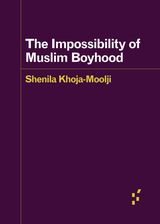 The Impossibility of Muslim Boyhood
Shenila Khoja-Moolji
University of Minnesota Press, 2024 How the construction of Muslim boys as proto-terrorists is integral to the story of American racial capitalism
How do we understand an incident where a five-year-old Muslim boy arrives at Dulles airport and is preemptively detained as a “threat”? To answer that question, Shenila Khoja-Moolji examines American public culture, arguing that Muslim boyhood has been invented as a threat within an ideology that seeks to predict future terrorism. Muslim boyhood bridges actual past terrorism and possible future events, justifying preemptive enclosure, surveillance, and punishment. Even in the occasional reframing of individual Muslim boys as innocent, Khoja-Moolji identifies a pattern of commodity antiracism, through which elites buy public goodwill but leave intact the collective anti-Muslim notion that fuels an expanding carceral and security state. Framing Muslim boyhood as a heuristic device, she turns to a discussion of Hindutva ideology in India to show how Muslim boyhood may be resituated in global contexts.
Impossible Appetites
James Fetler
University of Iowa Press, 1980
The collection of nine stories which won the 1980 Iowa Short Fiction Award is woven in a pattern so subtle that reading it is like writing your own nine-part novel. The author allows brief glimpses into the tormented journals of Joseph Quaile, a man of acute compassions and consuming hungers, then juxtaposes them with the fiction Quaile writes to scourge his demons and come to terms with himself and the people he loves. This is a dispassionate intelligence in passionate pursuit of freedom and reconciliation.
 Impossible Citizens: Dubai's Indian Diaspora
Neha Vora
Duke University Press, 2013 Indian communities have existed in the Gulf emirate of Dubai for more than a century. Since the 1970s, workers from South Asia have flooded into the emirate, enabling Dubai's huge construction boom. They now compose its largest noncitizen population. Though many migrant families are middle-class and second-, third-, or even fourth-generation residents, Indians cannot become legal citizens of the United Arab Emirates. Instead, they are all classified as temporary guest workers. In Impossible Citizens, Neha Vora draws on her ethnographic research in Dubai's Indian-dominated downtown to explore how Indians live suspended in a state of permanent temporariness. While their legal status defines them as perpetual outsiders, Indians are integral to the Emirati nation-state and its economy. At the same time, Indians—even those who have established thriving diasporic neighborhoods in the emirate—disavow any interest in formally belonging to Dubai and instead consider India their home. Vora shows how these multiple and conflicting logics of citizenship and belonging contribute to new understandings of contemporary citizenship, migration, and national identity, ones that differ from liberal democratic models and that highlight how Indians, rather than Emiratis, are the quintessential—yet impossible—citizens of Dubai.
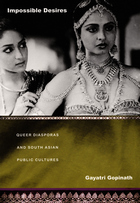 Impossible Desires: Queer Diasporas and South Asian Public Cultures
Gayatri Gopinath
Duke University Press, 2005 By bringing queer theory to bear on ideas of diaspora, Gayatri Gopinath produces both a more compelling queer theory and a more nuanced understanding of diaspora. Focusing on queer female diasporic subjectivity, Gopinath develops a theory of diaspora apart from the logic of blood, authenticity, and patrilineal descent that she argues invariably forms the core of conventional formulations. She examines South Asian diasporic literature, film, and music in order to suggest alternative ways of conceptualizing community and collectivity across disparate geographic locations. Her agile readings challenge nationalist ideologies by bringing to light that which has been rendered illegible or impossible within diaspora: the impure, inauthentic, and nonreproductive. Gopinath juxtaposes diverse texts to indicate the range of oppositional practices, subjectivities, and visions of collectivity that fall outside not only mainstream narratives of diaspora, colonialism, and nationalism but also most projects of liberal feminism and gay and lesbian politics and theory. She considers British Asian music of the 1990s alongside alternative media and cultural practices. Among the fictional works she discusses are V. S. Naipaul’s classic novel A House for Mr. Biswas, Ismat Chughtai’s short story “The Quilt,” Monica Ali’s Brick Lane, Shyam Selvadurai’s Funny Boy, and Shani Mootoo’s Cereus Blooms at Night. Analyzing films including Deepa Mehta’s controversial Fire and Mira Nair’s Monsoon Wedding, she pays particular attention to how South Asian diasporic feminist filmmakers have reworked Bollywood’s strategies of queer representation and to what is lost or gained in this process of translation. Gopinath’s readings are dazzling, and her theoretical framework transformative and far-reaching.
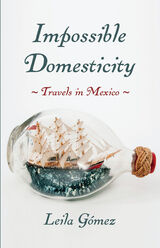 Impossible Domesticity: Travelers in Mexico
Leila Gomez
University of Pittsburgh Press, 2021 Travelers from Europe, North, and South America often perceive Mexico as a mythical place onto which they project their own cultures’ desires, fears, and anxieties. Gómez argues that Mexico’s role in these narratives was not passive and that the environment, peoples, ruins, political revolutions, and economy of Mexico were fundamental to the configuration of modern Western art and science. This project studies the images of Mexico and the ways they were contested by travelers of different national origins and trained in varied disciplines from the nineteenth to the twenty-first century. It starts with Alexander von Humboldt, the German naturalist whose fame sprang from his trip to Mexico and Latin America, and ends with Roberto Bolaño, the Chilean novelist whose work defines Mexico as an “oasis of horror.” In between, there are archaeologists, photographers, war correspondents, educators, writers, and artists for whom the trip to Mexico represented a rite of passage, a turning point in their intellectual biographies, their scientific disciplines, and their artistic practices.
 The Impossible Indian: Gandhi and the Temptation of Violence
Faisal Devji
Harvard University Press, 2012 The Impossible Indian offers a rare, fresh view of Gandhi as a hard-hitting political thinker willing to countenance the greatest violence in pursuit of a global vision that went far beyond a nationalist agenda. Revising the conventional view of the Mahatma as an isolated Indian moralist detached from the mainstream of twentieth-century politics, Faisal Devji offers a provocative new genealogy of Gandhian thought, one that is not rooted in a clichéd alternative history of spiritual India but arises from a tradition of conquest and violence in the battlefields of 1857.
Focusing on his unsentimental engagement with the hard facts of imperial domination, Fascism, and civil war, Devji recasts Gandhi as a man at the center of modern history. Rejecting Western notions of the rights of man, rights which can only be bestowed by a state, Gandhi turned instead to the idea of dharma, or ethical duty, as the true source of the self’s sovereignty, independent of the state. Devji demonstrates that Gandhi’s dealings with violence, guided by his idea of ethical duty, were more radical than those of contemporary revolutionists.
To make sense of this seemingly incongruous relationship with violence, Devji returns to Gandhi’s writings and explores his engagement with issues beyond India’s struggle for home rule. Devji reintroduces Gandhi to a global audience in search of leadership at a time of extraordinary strife as a thinker who understood how life’s quotidian reality could be revolutionized to extraordinary effect.
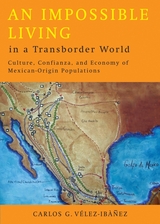 An Impossible Living in a Transborder World: Culture, Confianza, and Economy of Mexican-Origin Populations
Carlos G. Vélez-Ibáñez
University of Arizona Press, 2010 They are known as cundinas or tandas in Mexico, and for many people these local savings-and-loan operations play an indispensable role in the struggle to succeed in today’s transborder economy. With this extensively researched book, Carlos Vélez-Ibáñez updates and expands upon his major 1983 study of rotating savings and credit associations (ROSCAs), incorporating new data that reflect the explosion of Mexican-origin populations in the United States. Much more than a study of one economic phenomenon though, the book examines the way in which these practices are part of greater transnational economies and how these populations engage in—and suffer through—the twenty-first century global economy.
Central to the ROSCA is the cultural concept of mutual trust, or confianza. This is the cultural glue that holds the reciprocal relationship together. As Vélez-Ibáñez explains, confianza “shapes the expectations for relationships within broad networks of interpersonal links, in which intimacies, favors, goods, services, emotion, power, or information are exchanged.” In a border region where migration, class movement, economic changes, and institutional inaccessibility produce a great deal of uncertainty, Mexican-origin populations rely on confianza and ROSCAs to maintain a sense of security in daily life. How do transborder people adapt these common practices to meet the demands of a global economy? That is precisely what Vélez-Ibáñez investigates.
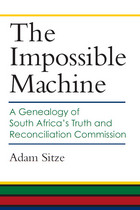 The Impossible Machine: A Genealogy of South Africa's Truth and Reconciliation Commission
Adam Sitze
University of Michigan Press, 2016 Adam Sitze meticulously traces the origins of South Africa’s Truth and Reconciliation Commission back to two well-established instruments of colonial and imperial governance: the jurisprudence of indemnity and the commission of inquiry. This genealogy provides a fresh, though counterintuitive, understanding of the TRC’s legal, political, and cultural importance. The TRC’s genius, Sitze contends, is not the substitution of “forgiving” restorative justice for “strict” legal justice but rather the innovative adaptation of colonial law, sovereignty, and government. However, this approach also contains a potential liability: if the TRC’s origins are forgotten, the very enterprise intended to overturn the jurisprudence of colonial rule may perpetuate it. In sum, Sitze proposes a provocative new means by which South Africa’s Truth and Reconciliation Commission should be understood and evaluated.
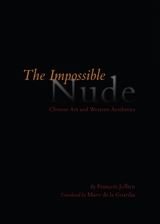 The Impossible Nude
François Jullien
University of Chicago Press, 2007 The undraped human form is ubiquitous in Western art and even appears in the art of India and Japan. Only in China, François Jullien argues, is the nude completely absent. In this enthralling extended essay, he explores the different conceptions of the human body that underlie this provocative disparity.
Contrasting nakedness (which implies a diminished state) with nudity (which represents a complete presence), Jullien explores the traditional European vision of the nude as a fixed point of fusion where form joins truth. He then shows that the absence of the nude in Chinese art evinces an understanding of the human body as changeable and transitory. Viewed in light of each other, these differing concepts allow for a new way of thinking about form, the ideal, and beauty, enabling us to delve deeper into the relationship between art and the ideas that lie at its roots. Beautifully illustrated and gracefully translated into English for the first time, The Impossible Nude will fascinate anyone interested in art history, Chinese art, or aesthetics.
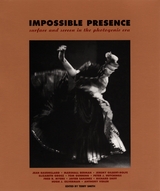 Impossible Presence: Surface and Screen in the Photogenic Era
Edited by Terry Smith
University of Chicago Press, 2001 Impossible Presence brings together new work in film studies, critical theory, art history, and anthropology for a multifaceted exploration of the continuing proliferation of visual images in the modern era. It also asks what this proliferation—and the changing technologies that support it—mean for the ways in which images are read today and how they communicate with viewers and spectators.
Framed by Terry Smith's introduction, the essays focus on two kinds of strangeness involved in experiencing visual images in the modern era. The first, explored in the book's first half, involves the appearance of oddities or phantasmagoria in early photographs and cinema. The second type of strangeness involves art from marginalized groups and indigenous peoples, and the communicative formations that result from the trafficking of images between people from vastly different cultures. With a stellar list of contributors, Impossible Presence offers a wide-ranging look at the fate of the visual image in modernity, modern art, and popular culture.
Contributors:
Jean Baudrillard
Marshall Berman
Jeremy Gilbert-Rolfe
Elizabeth Grosz
Tom Gunning
Peter Hutchings
Fred R. Myers
Javier Sanjines
Richard Shiff
Hugh J. Silverman
Terry Smith
 Impossible Purities: Blackness, Femininity, and Victorian Culture
Jennifer DeVere Brody
Duke University Press, 1998 Using black feminist theory and African American studies to read Victorian culture, Impossible Purities looks at the construction of “Englishness” as white, masculine, and pure and “Americanness” as black, feminine, and impure. Brody’s readings of Victorian novels, plays, paintings, and science fiction reveal the impossibility of purity and the inevitability of hybridity in representations of ethnicity, sexuality, gender, and race. She amasses a considerable amount of evidence to show that Victorian culture was bound inextricably to various forms and figures of blackness.
Opening with a reading of Daniel Defoe’s “A True-Born Englishman,” which posits the mixed origins of English identity, Brody goes on to analyze mulattas typified by Rhoda Swartz in William Thackeray’s Vanity Fair, whose mixed-race status reveals the “unseemly origins of English imperial power.” Examining Victorian stage productions from blackface minstrel shows to performances of The Octoroon and Uncle Tom’s Cabin, she explains how such productions depended upon feminized, “black” figures in order to reproduce Englishmen as masculine white subjects. She also discusses H.G. Wells’s The Island of Dr. Moreau in the context of debates about the “new woman,” slavery, and fears of the monstrous degeneration of English gentleman. Impossible Purities concludes with a discussion of Bram Stoker’s novella, “The Lair of the White Worm,” which brings together the book’s concerns with changing racial representations on both sides of the Atlantic.
This book will be of interest to scholars in Victorian studies, literary theory, African American studies, and cultural criticism.
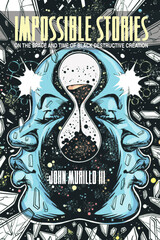 Impossible Stories: On the Space and Time of Black Destructive Creation
John Murillo III
Ohio State University Press, 2021 In Impossible Stories, John Murillo offers bold new readings of recent and canonical Black creative works within an Afro-pessimistic framework to excavate how time, space, and blackness intersect—or, rather, crash. Building on Michelle Wright’s ideas about dislocation from time and space as constitutive to being Black in America, as well as on W. E. B. DuBois’s theories of temporalization, he reconsiders the connections between physical phenomena and principles, literature, history, and the fragmented nature of Black time and space. Taking as his lens the fragment—fragmented bodies, fragments of memories, fragments of texts—Murillo theorizes new directions for Black identity and cultural production. Combining a critical engagement of physics and metaphysics with innovative readings of Gayl Jones’s Corregidora, Octavia Butler’s Kindred, Toni Morrison’s Beloved, Kiese Laymon’s Long Division, Dionne Brand’s A Map to the Door of No Return, and Paul Beatty’s The Sellout, he offers new ways to think about anti-Black racism and practice Black creativity. Ultimately, in his equally creative and analytical responses to depictions of Black people left out of history and barred from spaces, Murillo argues that through Afro-pessimism, Black people can fi ght the anti-Black cosmos.
 Impossible Things
Miller Oberman
Duke University Press, 2024 Offering an intimate account of intergenerational grief, Miller Oberman’s new collection of poetry, Impossible Things, explores his experiences as both a transgender child and father. Oberman weaves in passages from his own deceased father’s unpublished memoir to engage with the mysterious drowning of his eldest brother, Joshua, at age two, a tragedy that cast a shadow over his childhood. He depicts his own youth and parenthood in the context of his father’s trauma, employing queer and trans theory and experimental poetic forms to challenge and expand discourse around fatherhood and masculinity. Oberman moves beyond an attempt to solve the mystery of Joshua’s death and interrogates how much we can ever know about our forebears or understand their impacts on our lives. Impossible Things offers a necessary intervention into the well-worn terrain of fatherhood/boyhood memoir and functions as a living elegy, communicating with the past, the dead, and the unknowable while speaking to the possibilities for healing intergenerational trauma.
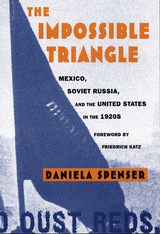 The Impossible Triangle: Mexico, Soviet Russia, and the United States in the 1920s
Daniela Spenser
Duke University Press, 1999 During the 1920s, Mexico was caught in a diplomatic struggle between the ideologies of two strong states. In The Impossible Triangle Daniela Spenser explores the tangled relationship between Russia and Mexico in the years following their own dramatic revolutions, as well as the role played by the United States during this turbulent period. Bringing together Mexican, Soviet, and North American (as well as British) perspectives, Spenser shows how the convergence of each country’s domestic and foreign policies precluded them from a harmonious triangular relationship. Based on documents from the archives of several nations—including reports by former Mexican diplomats in Moscow that have never before been studied—the book analyzes the Mexican government’s motivation for establishing relations with the Soviet Union in the face of continued imperialist pressure and harsh opposition from the United States. After explaining how Mexico established diplomatic ties with the Soviet Union in 1924 in an attempt to broaden the spectrum of its alliances after several years of uneven relations with the United States, Spenser reveals the troubled nature of the relationship that ensued. Soviet policy toward Mexico was characterized by a series of profound contradictions, varying from neglect to strong involvement in Mexican politics and the belief that Mexico could become a center of world revolution. Working to resolve and explain these contradictions, Spenser explores how, despite U.S. objections to Mexico’s relations with the Soviet Union, Mexico continued its association with the Soviets until the United States adopted the Good Neighbor Policy and softened its stance toward Mexico’s revolutionary program after 1927. With a foreword by Friedrich Katz and illustrated by illuminating photographs, The Impossible Triangle contributes to an understanding of the international dimension of the Mexican revolution. It will interest students and scholars of history, revolutionary theory, political science, diplomacy, and international relations.
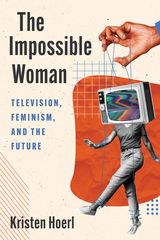 The Impossible Woman: Television, Feminism, and the Future
Kristen Hoerl
Rutgers University Press, 2026 Although it may seem like the proliferation of strong women on television is a feminist achievement, a deeper look into their stories tells us otherwise. The Impossible Woman examines a variety of scripted US television series across multiple genres to show how the cultural value of television’s extraordinarily talented female characters often rests upon their ability to endure—but not overcome—sexism. Looking at Parks and Recreation, The Unbreakable Kimmy Schmidt, The Marvelous Mrs. Maisel, The Queen’s Gambit, Game of Thrones, and Queen of the South, Hoerl argues that these series contribute to sexist realism, or the cultural assumption that there is no alternative to patriarchy. Situating impossible women’s struggles in the context of contemporary feminist politics, Hoerl explains how the problems facing television’s strongest women illustrate mainstream feminism’s paradoxical dependence upon on cultural misogyny, neoliberal individualism, and racism. The Impossible Woman encourages readers to seek out alternative stories that might help them envision more just feminist futures.
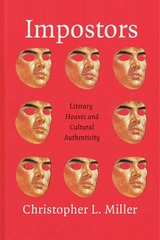 Impostors: Literary Hoaxes and Cultural Authenticity
Christopher L. Miller
University of Chicago Press, 2018 Writing a new page in the surprisingly long history of literary deceit, Impostors examines a series of literary hoaxes, deceptions that involved flagrant acts of cultural appropriation. This book looks at authors who posed as people they were not, in order to claim a different ethnic, class, or other identity. These writers were, in other words, literary usurpers and appropriators who trafficked in what Christopher L. Miller terms the “intercultural hoax.”
In the United States, such hoaxes are familiar. Forrest Carter’s The Education of Little Tree and JT LeRoy’s Sarah are two infamous examples. Miller’s contribution is to study hoaxes beyond our borders, employing a comparative framework and bringing French and African identity hoaxes into dialogue with some of their better-known American counterparts. In France, multiculturalism is generally eschewed in favor of universalism, and there should thus be no identities (in the American sense) to steal. However, as Miller demonstrates, this too is a ruse: French universalism can only go so far and do so much. There is plenty of otherness to appropriate. This French and Francophone tradition of imposture has never received the study it deserves. Taking a novel approach to this understudied tradition, Impostors examines hoaxes in both countries, finding similar practices of deception and questions of harm.
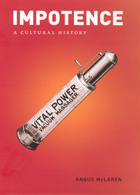 Impotence: A Cultural History
Angus McLaren
University of Chicago Press, 2007 As anyone who has watched television in recent years can attest, we live in the age of Viagra. From Bob Dole to Mike Ditka to late-night comedians, our culture has been engaged in one long, frank, and very public talk about impotence—and our newfound pharmaceutical solutions. But as Angus McLaren shows us in Impotence, the first cultural history of the subject, the failure of men to rise to the occasion has been a recurrent topic since the dawn of human culture.
Drawing on a dazzling range of sources from across centuries, McLaren demonstrates how male sexuality was constructed around the idea of potency, from times past when it was essential for the purpose of siring children, to today, when successful sex is viewed as a component of a healthy emotional life. Along the way, Impotence enlightens and fascinates with tales of sexual failure and its remedies—for example, had Ditka lived in ancient Mesopotamia, he might have recited spells while eating roots and plants rather than pills—and explanations, which over the years have included witchcraft, shell-shock, masturbation, feminism, and the Oedipal complex. McLaren also explores the surprising political and social effects of impotence, from the revolutionary unrest fueled by Louis XVI’s failure to consummate his marriage to the boost given the fledgling American republic by George Washington’s failure to found a dynasty. Each age, McLaren shows, turns impotence to its own purposes, using it to help define what is normal and healthy for men, their relationships, and society.
From marraige manuals to metrosexuals, from Renaissance Italy to Hollywood movies, Impotence is a serious but highly entertaining examination of a problem that humanity has simultaneously regarded as life’s greatest tragedy and its greatest joke.
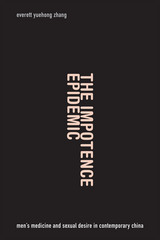 The Impotence Epidemic: Men's Medicine and Sexual Desire in Contemporary China
Everett Yuehong Zhang
Duke University Press, 2015 Since the 1990s China has seen a dramatic increase in the number of men seeking treatment for impotence. Everett Yuehong Zhang argues in The Impotence Epidemic that this trend represents changing public attitudes about sexuality in an increasingly globalized China. In this ethnography he shifts discussions of impotence as a purely neurovascular phenomenon to a social one. Zhang contextualizes impotence within the social changes brought by recent economic reform and through the production of various desires in post-Maoist China. Based on interviews with 350 men and their partners from Beijing and Chengdu, and concerned with de-mystifying and de-stigmatizing impotence, Zhang suggests that the impotence epidemic represents not just trauma and suffering, but also a contagion of individualized desire and an affirmation for living a full life. For Zhang, studying male impotence in China is one way to comprehend the unique experience of Chinese modernity.
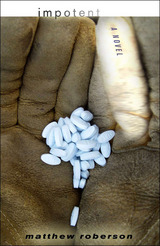 Impotent: A Novel
Matthew Roberson
University of Alabama Press, 2009 Impotent is a collection of moving stories about a time when "it is easier to get a refill on a prescription than approval for therapy" and individuals are reduced to letters on a medical chart. In revealing vignettes, Matthew Roberson clinically catalogs the hopes, dreams, and failures of people identified only through form-like abbreviations (C— for co-dependent, I— for Insured). In these "case studies," Roberson captures his subjects' lives poignantly by supplementing their diagnoses with unconventional footnotes, lists, and medicinal warnings. Each vignette exposes a different facet of our medicated society, humanizing a multitude of conditions: depression, anxiety, obsessive-compulsive disorder, impotence, and dementia. In a world of domestic ennui, deadpan voices struggle to transcend numbness while simultaneously trying to manage the pain of living. Impotent is both important social commentary and engrossing fiction.
Impounded People: Japanese-Americans in the Relocation Centers
Edward H. Spicer, Asael T. Hansen, Katherine Luomala, and Marvin K. Opler
University of Arizona Press, 1969 This important final report of the War Relocation Authority, written in 1946 now released in book form, describes the growth and changes in the community life and how attitudes of Japanese-American relocatees and WRA administrators evolved, adjusted, and affected one another on political, social, and psychological levels.
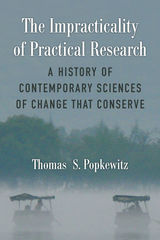 The Impracticality of Practical Research: A History of Contemporary Sciences of Change That Conserve
Thomas S. Popkewitz
University of Michigan Press, 2020 There is an alluring desire that research should lead us to find the practical knowledge that enables people to live a good life in a just and equitable society. This desire haunted the 19th century emergence of the social sciences as a discipline, then became more pronounced in the postwar mobilizations of research. Today that desire lives on in the international assessments of national schools and in the structure of professional education, both of which influence government modernization of schools and also provide for people’s well-being. American policy thus reflects research in which reforms are verified by “scientific, empirical evidences” about “what works” in experiments, and “will work” therefore in society.
The book explores the idea that practical and useful knowledge changes over time, and shows how this knowledge has been (re)visioned in contemporary research on educational reform, instructional improvement, and professionalization. The study of science draws on a range of social and cultural theories and historical studies to understand the politics of science, as well as scientific knowledge that is concerned with social and educational change. Research hopes to change social conditions to create a better life, and to shape people whose conduct embodies these valued characteristics—the good citizen, parent, or worker. Yet this hope continually articulates the dangers that threaten this future. Thomas Popkewitz explores how the research to correct social wrongs is paradoxically entangled with the inscription of differences that ultimately hamper the efforts to include.
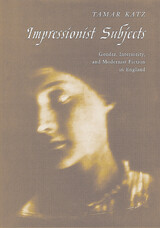 Impressionist Subjects: Gender, Interiority, and Modernist Fiction in England
Tamar Katz
University of Illinois Press, 2000 Exploring the intersection of ideas about woman, subjectivity, and literary authority, Impressionist Subjects reveals the female subject as crucial in framing contradictions central to modernism, particularly the tension between modernism's claim to timeless art and its critique of historical conditions. Against the backdrop of the New Woman movement of the 1890s, Tamar Katz establishes literary impressionism as integral to modernist form and to the modernist project of investigating the nature and function of subjectivity. Focusing on a duality common to impressionism and contemporary ideas of feminine subjectivity, Katz shows how the New Woman reconciled the paradox of a subject at once immersed in the world and securely enclosed in a mysterious interiority. Book chapters feature discussion of modernists including Walter Pater, George Egerton, Sarah Grand, Henry James, Joseph Conrad, Ford Madox Ford, Dorothy Richardson, and Virginia Woolf. Sophisticated and tightly argued, Impressionist Subjects is a substantial contribution to the reassessment and expansion of the modernist fiction canon.
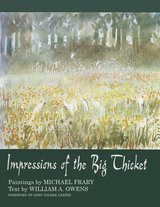 Impressions of the Big Thicket
Michael Frary
University of Texas Press, 1973 Before the establishment of the Big Thicket Nature Preserve, the Big Thicket of Texas became a symbol of nature's last stand against encroaching civilization. Here, in a mingling of ecological zones, come together plants, animals, and birds—many of them rare—the flora and fauna of north and south, east and west. Northern maples and beeches stand not too great a distance from cypresses and Southern magnolias. American hollies grow large and orchids bloom among Northern ferns. Mesquite and tumbleweed, plants of the Western desert, survive where the annual rainfall averages sixty inches. On a major flyway, the Big Thicket is a stopping place for many birds in passage as well as home to a wide variety. Beavers build their dams there, and an occasional coyote yips in the night. Because of its great beauty and rich natural resources, use of the Big Thicket was the object of a forty-year struggle involving financiers, politicians, conservationists, and countless Thicket lovers. Each group viewed the Thicket from a different perspective and foresaw its future in different terms. This book records the impressions of two Thicket lovers. Michael Frary's paintings and drawings of woods and water, of birds in flight and strange plants growing close to the moist earth are pictures of a place, a time, a mood caught today—and not the same if left until tomorrow. The qualities of gentleness and violence are constant, but often hidden—there to be brought out by human need or human greed. William Owens writes of the people who have lived their lives in the Big Thicket, who have stirred its stillness with whoop and holler across the waters, who have taken in its stillness and explosive beauty until they themselves are made up of gentleness and violence. Together the impressions show what the Big Thicket was and is. What it will be—that is the chief concern of the book.
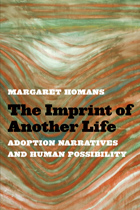 The Imprint of Another Life: Adoption Narratives and Human Possibility
Margaret Homans
University of Michigan Press, 2015 The Imprint of Another Life: Adoption Narratives and Human Possibilityaddresses a series of questions about common beliefs about adoption. Underlying these beliefs is the assumption that human qualities are innate and intrinsic, an assumption often held by adoptees and their families, sometimes at great emotional cost. This book explores representations of adoption—transracial, transnational, and domestic same-race adoption—that reimagine human possibility by questioning this assumption and conceiving of alternatives. Literary scholar Margaret Homans examines fiction making’s special relationship to themes of adoption, an “as if” form of family making, fabricated or fictional instead of biological or “real.” Adoption has tended to generate stories rather than uncover bedrock truths. Adoptive families are made, not born; in the words of novelist Jeanette Winterson, “adopted children are self-invented because we have to be.” In attempting to recover their lost histories and identities, adoptees create new stories about themselves. While some believe that adoptees cannot be whole unless they reconnect with their origins, others believe that privileging biology reaffirms hierarchies (such as those of race) that harm societies and individuals. Adoption is lived and represented through an irresolvable tension between belief in the innate nature of human traits and belief in their constructedness, contingency, and changeability. The book shows some of the ways in which literary creation, and a concept of adoption as a form of creativity, manages this tension. The texts examined include fiction (e.g., classic novels such as Silas Marner, What Maisie Knew, and Beloved); memoirs by adoptees, adoptive parents, and birthmothers; drama, documentary films, advice manuals, social science writing; and published interviews with adoptees, parents, and birth parents. Along the way the book tracks the quests of adoptees who, whether or not they meet their original families, must construct their own stories rather than finding them; follows transnational adoptees as they return, hopes held high, to Korea and China; looks over the shoulders of a generation of girls adopted from China as they watch Disney’s iconic Mulan, with its alluring story of destiny written on the skin; and listens to birthmothers as they struggle to tell painful secrets held for decades. This book engages in debates within adoption studies, women’s and gender studies, transnational studies, and ethnic studies; it will appeal to literary scholars and critics, including specialists in memoir or narrative theory, and to general readers interested in adoption and in race.
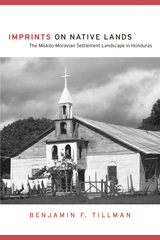 Imprints on Native Lands: The Miskito-Moravian Settlement Landscape in Honduras
Benjamin F. Tillman
University of Arizona Press, 2011 More than one hundred fifty years ago, Moravian missionaries first landed along a so-called isolated stretch of Honduras’s Mosquito Coast bordering the western Caribbean Sea. The missionaries were sent, with the strong encouragement of German political leaders and in the context of German attempts at colonization, to “spread the word” of Protestantism in Central America. Upon their arrival, the missionaries employed a three-pronged approach consisting of proselytizing, medical treatment, and education to convert the majority of the indigenous population.
Much like the Spanish and English attempts before them, German colonizing efforts in the region never completely took hold. Still, as Benjamin Tillman shows, for the region’s indigenous inhabitants, the Miskito people, the arrival of the Moravian missionaries marked the beginning of an important cultural interface.
Imprints on Native Lands documents Moravian contributions to the Miskito settlement landscape in sixty four villages of eastern Honduras through field observations of material culture, interviews with village residents, and research in primary sources in the Moravian Church archives. Tillman employs the resulting data to map a hierarchy of Moravian centers, illustrating spatially varying degrees of Moravian influence on the Miskito settlement landscape.
Tillman reinforces Miskito claims to ancestral lands by identifying and mapping their created ethnic landscape, as well as supporting earlier efforts at land-use mapping in the region. This book has broad implications, providing a methodology that will be of help to those with an interest in geography, anthropology, or Latin American studies, and to anyone interested in documenting and strengthening indigenous land claims.
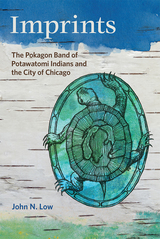 Imprints: The Pokagon Band of Potawatomi Indians and the City of Chicago
John N. Low
Michigan State University Press, 2016 The Pokagon Band of Potawatomi Indians has been a part of Chicago since its founding. In very public expressions of indigeneity, they have refused to hide in plain sight or assimilate. Instead, throughout the city’s history, the Pokagon Potawatomi Indians have openly and aggressively expressed their refusal to be marginalized or forgotten—and in doing so, they have contributed to the fabric and history of the city.
Imprints: The Pokagon Band of Potawatomi Indians and the City of Chicago examines the ways some Pokagon Potawatomi tribal members have maintained a distinct Native identity, their rejection of assimilation into the mainstream, and their desire for inclusion in the larger contemporary society without forfeiting their “Indianness.” Mindful that contact is never a one-way street, Low also examines the ways in which experiences in Chicago have influenced the Pokagon Potawatomi. Imprints continues the recent scholarship on the urban Indian experience before as well as after World War II.
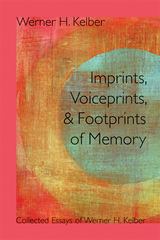 Imprints, Voiceprints, and Footprints of Memory
Werner H. Kelber
SBL Press, 2013 Jesus and his followers defined their allegiances and expressed their identities in a communications culture that manifested itself in voice and chirographic practices, in oral-scribal interfaces, and in performative activities rooted in memory. In the sixteen essays gathered in Imprints, Voiceprints, and Footprints of Memory, Werner Kelber explores the verbal arts of early Christian word processing operative in a media world that was separated by two millennia from our contemporary media history. The title articulates the fact that the ancient culture of voiced texts, hand-copying, and remembering is chiefly accessible to us in print format and predominantly assimilated from print perspectives. The oral-scribal-memorial-performative paradigm developed in these essays challenges the reigning historical-critical model in biblical scholarship. Notions of tradition, the fixation on the single original saying, the dominant methodology of form criticism, and the heroic labors of the Quest—stalwart features of the historical, documentary paradigm—are all subject to a critical review. A number of essays reach beyond New Testament texts, ranging from the pre-Socratic Gorgias through medieval manuscript culture on to print’s triumphant apotheosis in Gutenberg’s Vulgate, product of the high tech of the fifteenth century, all the way to conflicting commemorations of Auschwitz—taking tentative steps toward a history of media technologies, culture, and cognition of the Christian tradition in the West.
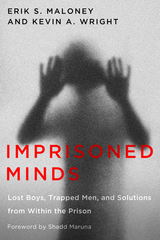 Imprisoned Minds: Lost Boys, Trapped Men, and Solutions from Within the Prison
Erik S. Maloney
Rutgers University Press, 2025 In Imprisoned Minds, Erik Maloney tells the stories of men in prison that few people ever hear. Six gripping, first-person narratives of incarcerated men form his imprisoned mind concept: the men’s unimaginable childhood trauma and neglect set them on a pathway for prison or death. Maloney interviews his fellow prisoners with candor and savviness. He can do this because he is in prison alongside them—incarcerated for life at the age of twenty-one. Joined by a correctional scholar, Maloney presents a unique and informed perspective that blends lived experience with academic knowledge. A trauma-informed corrections can empower men to acknowledge and repair the harms of their past to regain control over their minds and their futures. Maloney has broken free from the mindset—and others can, too. Imprisoned Minds reminds us of the humanity of the nearly two million people behind bars in the United States and encourages solutions from within that can break the cycle of intergenerational incarceration.
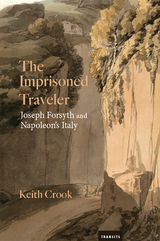 The Imprisoned Traveler: Joseph Forsyth and Napoleon's Italy
Keith Crook
Bucknell University Press, 2020 The Imprisoned Traveler is a fascinating portrait of a unique book, its context, and its elusive author. Joseph Forsyth, traveling through an Italy plundered by Napoleon, was unjustly imprisoned in 1803 by the French as an enemy alien. Out of his arduous eleven-year “detention” came his only book, Remarks on Antiquities, Arts, and Letters during an Excursion in Italy (1813). Written as an (unsuccessful) appeal for release, praised by Forsyth’s contemporaries for its originality and fine taste, it is now recognized as a classic of Romantic period travel writing. Keith Crook, in this authoritative study, evokes the peculiar miseries that Forsyth endured in French prisons, reveals the significance of Forsyth’s encounters with scientists, poets, scholars, and ordinary Italians, and analyzes his judgments on Italian artworks. He uncovers how Forsyth’s allusiveness functions as a method of covert protest against Napoleon and reproduces the hitherto unpublished correspondence between the imprisoned Forsyth and his brother.
Published by Bucknell University Press. Distributed worldwide by Rutgers University Press.
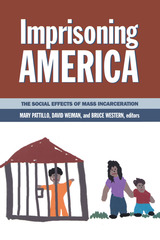 Imprisoning America: The Social Effects of Mass Incarceration
Mary Pattillo
Russell Sage Foundation, 2004 Over the last thirty years, the U.S. penal population increased from around 300,000 to more than two million, with more than half a million prisoners returning to their home communities each year. What are the social costs to the communities from which this vast incarcerated population comes? And what happens to these communities when former prisoners return as free men and women in need of social and economic support? In Imprisoning America, an interdisciplinary group of leading researchers in economics, criminal justice, psychology, sociology, and social work goes beyond a narrow focus on crime to examine the connections between incarceration and family formation, labor markets, political participation, and community well-being. The book opens with a consideration of the impact of incarceration on families. Using a national survey of young parents, Bruce Western and colleagues show the enduring corrosive effects of incarceration on marriage and cohabitation, even after a prison sentence has been served. Kathryn Edin, Timothy Nelson, and Rechelle Parnal use in-depth life histories of low-income men in Philadelphia and Charleston, to study how incarceration not only damages but sometimes strengthens relations between fathers and their children. Imprisoning America then turns to how mass incarceration affects local communities and society at large. Christopher Uggen and Jeff Manza use survey data and interviews with thirty former felons to explore the political ramifications of disenfranchising inmates and former felons. Harry Holzer, Stephen Raphael, and Michael Stoll examine how poor labor market opportunities for former prisoners are shaped by employers' (sometimes unreliable) background checks. Jeremy Travis concludes that corrections policy must extend beyond incarceration to help former prisoners reconnect with their families, communities, and the labor market. He recommends greater collaboration between prison officials and officials in child and family welfare services, educational and job training programs, and mental and public health agencies. Imprisoning America vividly illustrates that the experience of incarceration itself—and not just the criminal involvement of inmates—negatively affects diverse aspects of social membership. By contributing to the social exclusion of an already marginalized population, mass incarceration may actually increase crime rates, and threaten the public safety it was designed to secure. A rigorous portrayal of the pitfalls of getting tough on crime, Imprisoning America highlights the pressing need for new policies to support ex-prisoners and the families and communities to which they return.
Imprisonment in America: Choosing the Future
Michael Sherman and Gordon J. Hawkins
University of Chicago Press, 1983 "For a few decades American prisons were the wonder of the world. [However] early hopes that a prison regime could be a powerful means of reforming most convicts have been abandoned, and prisons are seen even by some of those who think we need more of them as savage repositories, to be shunned or veiled rather than admired. This sad history is drawn with great insight and learning in [this] important new book about prisons and punishment in America by Michael Sherman and Gordon Hawkins. . . . The views of these professionals must be taken seriously."—Graham Hughes, New York Review of Books
"This is a serious and enlightened and concerned attempt to fuse liberal and conservative attitudes and values to achieve a breakthrough in American penal policy."—Congressional Staff Journal
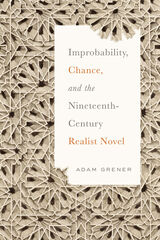 Improbability, Chance, and the Nineteenth-Century Realist Novel
Adam Grener
Ohio State University Press, 2020 In Improbability, Chance, and the Nineteenth-Century Realist Novel, Adam Grener advances a new approach to evaluating realism in fiction by arguing that nineteenth-century literary realism shifted attention to the historical and social dimensions of probability in the period’s literature. In an era in which probability was increasingly defined by statistical concepts of aggregation and abstraction, the realist writers discussed here turned to chance and improbability to address representational problems of contingency, difference, and scale.
Contemporary thinking about probability came to recognize the variability and even randomness of the world while also discovering how patterns and order reemerge at scale. Reading chance as a tension between randomness and order, Grener shows how novels by Jane Austen, Sir Walter Scott, Charles Dickens, Anthony Trollope, and Thomas Hardy resist the demands of probabilistic representation and develop strategies for capturing cultural particularity and historical transformation. These authors served their visions of realism by tactically embracing improbability in the form of coincidences, fatalism, supernaturalism, and luck. Understanding this strategy helps us to appreciate how realist novels work to historicize the social worlds and experiences they represent and asks us to rethink the very foundation of realism.
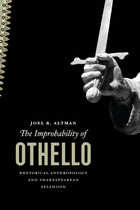 The Improbability of Othello: Rhetorical Anthropology and Shakespearean Selfhood
Joel B. Altman
University of Chicago Press, 2010 Shakespeare’s dramatis personae exist in a world of supposition, struggling to connect knowledge that cannot be had, judgments that must be made, and actions that need to be taken. For them, probability—what they and others might be persuaded to believe—governs human affairs, not certainty. Yet negotiating the space of probability is fraught with difficulty. Here, Joel B. Altman explores the problematics of probability and the psychology of persuasion in Renaissance rhetoric and Shakespeare’s theater. Focusing on the Tragedy of Othello, Altman investigates Shakespeare’s representation of the self as a specific realization of tensions pervading the rhetorical culture in which he was educated and practiced his craft. In Altman’s account, Shakespeare also restrains and energizes his audiences’ probabilizing capacities, alternately playing the skeptical critic and dramaturgic trickster. A monumental work of scholarship by one of America’s most respected scholars of Renaissance literature, The Improbability of Othello contributes fresh ideas to our understanding of Shakespeare’s conception of the self, his shaping of audience response, and the relationship of actors to his texts.
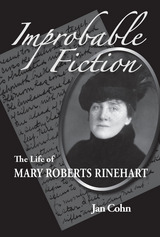 Improbable Fiction: The Life of Mary Roberts Rinehart
Jan Cohn
University of Pittsburgh Press, 2006
The mystery stories and other popular fiction of Mary Roberts Rinehart (1876–1958) brought her wealth and fame, but she was much more than a writer. She was a well-known American, respected and loved during a time when few women achieved national influence.
Her early life was conventional enough. Trained as a nurse, she met and married a physician, with whom she had three sons. She was living the stereotypical life of a young matron in Allegheny (now part of Pittsburgh), when her husband’s investments evaporated during a stock market crash. She began writing as a means to supplement the family income.
Rinehart became a prolific writer. In addition to her mysteries, she wrote serious fiction, plays, poems, magazine articles, and editorials. Her regular contributions to the <I>Saturday Evening Post</I> were immensely popular and helped the magazine mold middle-class taste and manners.
In this fascinating account of a woman ahead of her time, Cohn illuminates the tensions that pervaded Rinehart’s life. Rinehart’s commercial success conflicted with her domestic roles of wife and mother; she often endured periods of illness and depression but also pursued adventure, including a job as the first woman war correspondent at the Belgian front during World War I. Throughout, Cohn presents Rinehart as a woman of many complexities whose zest for life always prevailed.
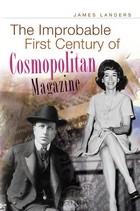 The Improbable First Century of Cosmopolitan Magazine
James Landers
University of Missouri Press, 2010 Today, monthly issues of Cosmopolitan magazine scream out to readers from checkout counters and newsstands. With bright covers and bold, sexy headlines, this famous periodical targets young, single women aspiring to become the quintessential “Cosmo girl.” Cosmopolitan is known for its vivacious character and frank, explicit attitude toward sex, yet because of its reputation, many people don’t realize that the magazine has undergone many incarnations before its current one, including family literary magazine and muckraking investigative journal, and all are presented in The Improbable First Century of Cosmopolitan Magazine. The book boasts one particularly impressive contributor: Helen Gurley Brown herself, who rarely grants interviews but spoke and corresponded with James Landers to aid in his research. When launched in 1886, Cosmopolitan was a family literary magazine that published quality fiction, children’s stories, and homemaking tips. In 1889 it was rescued from bankruptcy by wealthy entrepreneur John Brisben Walker, who introduced illustrations and attracted writers such as Mark Twain, Willa Cather, and H. G. Wells. Then, when newspaper magnate William Randolph Hearst purchased Cosmopolitan in 1905, he turned it into a purveyor of exposé journalism to aid his personal political pursuits. But when Hearst abandoned those ambitions, he changed the magazine in the 1920s back to a fiction periodical featuring leading writers such as Theodore Dreiser, Sinclair Lewis, and William Somerset Maugham. His approach garnered success by the 1930s, but poor editing sunk Cosmo’s readership as decades went on. By the mid-1960s executives considered letting Cosmopolitan die, but Helen Gurley Brown, an ambitious and savvy businesswoman, submitted a plan for a dramatic editorial makeover. Gurley Brown took the helm and saved Cosmopolitan by publishing articles about topics other women’s magazines avoided. Twenty years later, when the magazine ended its first century, Cosmopolitan was the profit center of the Hearst Corporation and a culturally significant force in young women’s lives. The Improbable First Century of Cosmopolitan Magazine explores how Cosmopolitan survived three near-death experiences to become one of the most dynamic and successful magazines of the twentieth century. Landers uses a wealth of primary source materials to place this important magazine in the context of history and depict how it became the cultural touchstone it is today. This book will be of interest not only to modern Cosmo aficionadas but also to journalism students, news historians, and anyone interested in publishing.
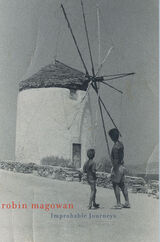 Improbable Journeys
Robin Magowan
Northwestern University Press, 2002 All writers risk their identities, some with each sentence. But abroad, writing about a life that can't help but seem elusive, the charlatan in oneself may feel all too exposed. Limited to the surface, to the most fortuitous of impressions, how can a foreign pair of eyes hope to pen anything that can vie with something an insider, born there, carrying that landscape in his bones, might write?
For more than four decades, poet Robin Magowan has journeyed in search of ecstatic spiritual experiences. Hitchhiking and walking, by bus or boat or when necessary by horse, he has explored lands as exotic as Nepal and New Guinea, as classic as Italy or France, and as forgotten as Persia and pre-Castro Cuba. All the while he has submerged himself, whether in the mysteries of Haitian voodoo or the simples pleasures of Burgundian peasant life. Known for the beauty, wit, and expressive power of his prose, Magowan's writing vibrates with the intensity of an outsider who crawls into the skin of a country--and emerges transformed.
 Improbable Libraries: A Visual Journey to the World's Most Unusual Libraries
Alex Johnson
University of Chicago Press, 2015 How do you use your local library? Does it arrive at your door on the back of an elephant? Can it float down the river to you? Or does it occupy a phone booth by the side of the road?
Public libraries are a cornerstone of modern civilization, yet like the books in them, libraries face an uncertain future in an increasingly digital world. Undaunted, librarians around the globe are thinking up astonishing ways of reaching those in reading need, whether by bike in Chicago, boat in Laos, or donkey in Colombia. Improbable Libraries showcases a wide range of unforgettable, never-before-seen images and interviews with librarians who are overcoming geographic, economic, and political difficulties to bring the written word to an eager audience. Alex Johnson charts the changing face of library architecture, as temporary pop-ups rub shoulders with monumental brick-and-mortar structures, and many libraries expand their mission to function as true community centers. To take just one example: the open-air Garden Library in Tel Aviv, located in a park near the city’s main bus station, supports asylum seekers and migrant workers with a stock of 3,500 volumes in sixteen different languages.
Beautifully illustrated with two hundred and fifty color photographs, Improbable Libraries offers a breathtaking tour of the places that bring us together and provide education, entertainment, culture, and so much more. From the rise of the egalitarian Little Free Library movement to the growth in luxury hotel libraries, the communal book revolution means you’ll never be far from the perfect next read.
 The Improbable Life of the Arkansas Democrat: An Oral History
Jerry McConnell
University of Arkansas Press, 2016 The Improbable Life of the Arkansas Democrat is based on more than one hundred interviews with employees of the Democrat, including editors, reporters, feature writers, cartoonists, circulation managers, business managers, salespeople, typesetters and others, from the 1930s through the early 1990s, when the Democrat took over the more prominent Arkansas Gazette after an aggressive newspaper war. This new addition to Arkansas journalism history provides vivid details about what it was like to work at the Democrat. August Engel, who led the paper with focused devotion for forty-two years, was famous for his thrift, creating austere conditions that included no air conditioning in the newsroom and sub-par wages. In spite of these drawbacks, the paper was still home to many dedicated journalism professionals endeavoring to do good work. Readers who remember the ultimate acrimony between the two papers may be surprised to learn that for many years the Democrat and the Gazette owners operated under a tacit agreement of civility. The papers didn’t raid each other’s staff, for example, and when a fire broke out in the Gazette pressroom, Democrat management offered to loan the use of its press. Staffers recall that when the Gazette struggled with an advertising boycott and reduced circulation during the Little Rock Central High crisis because of its perceived progressive editorial stance, which infuriated many Arkansans, the Democrat did less than it might have to capitalize. The eventual newspaper war that combined the two rivals saw the end of any semblance of civility when the Democrat hired an aggressive and infamous managing editor named John Robert Starr. Through these firsthand stories of those who lived it, The Improbable Life of the Arkansas Democrat tells the story of how the second-place paper overtook the oldest newspaper west of the Mississippi, forever changing not only Arkansas journalism but also Arkansas history.
 Improbable Patriot: The Secret History of Monsieur de Beaumarchais, the French Playwright Who Saved the American Revolution
Harlow Giles Unger
Brandeis University Press, 2026 The compelling story of a little-known figure in the American Revolution, now available in paperback for the first time, with a new foreword by Iris de Rode.
In 1776, the playwright and inventor Pierre-Augustin Caron de Beaumarchais (1732–99) conceived an audacious plan to send aid to the American rebels. What’s more, he convinced King Louis XVI to bankroll the project and single-handedly carried it out. By war’s end, he had supplied Washington’s army with most of its weapons and powder, though he was never paid or acknowledged by the United States. To some, he was a dashing hero, a towering intellect who saved the American Revolution. To others, he was a pure rogue, a double-dealing adventurer who stopped at nothing to advance his fame and fortune. In fact, he was both, and more: an advisor to kings, an arms dealer, and an author of some of the most enduring works of the stage, including The Marriage of Figaro and The Barber of Seville. Now in paperback, Improbable Patriot introduces readers to an unrecognized power player in the Revolutionary War.
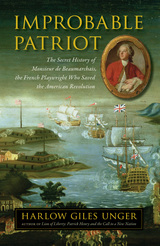 Improbable Patriot: The Secret History of Monsieur de Beaumarchais, the French Playwright Who Saved the American Revolution
Harlow Giles Unger
University Press of New England, 2011 Pierre-Augustin Caron de Beaumarchais was an eighteenth-century French inventor, famed playwright, and upstart near-aristocrat in the court of King Louis XVI. In 1776, he conceived an audacious plan to send aid to the American rebels. What’s more, he convinced the king to bankroll the project, and singlehandedly carried it out. By war’s end, he had supplied Washington’s army with most of its weapons and powder, though he was never paid or acknowledged by the United States. To some, he was a dashing hero—a towering intellect who saved the American Revolution. To others, he was pure rogue—a double-dealing adventurer who stopped at nothing to advance his fame and fortune. In fact, he was both, and more: an advisor to kings, an arms dealer, and author of some of the most enduring works of the stage, including The Marriage of Figaro and The Barber of Seville.
The Improbable Swervings of Atoms
Christopher Bursk
University of Pittsburgh Press, 2005
Winner of the 2004 Donald Hall Prize in Poetry
The Improbable Swervings of Atoms follows the comedic, often painful, physical and emotional travails of a young boy growing up in 1950s America. He watches the McCarthy hearings, conquers the Congo, assassinates the president, has his head stuffed into a toilet, drops his uniform on the fifty-yard line, and tries to make sense of Lucretius’s De Rerum Natura.
The poems engage history in a very intimate way, revealing how a boy, as he matures, attempts to understand the world around him, his own physical development, the people in his life, and what it means to live in a country and time where it is impossible to disengage oneself from world events—where, in fact, the quest for identity is an act that requires one to rewrite history in personal terms.
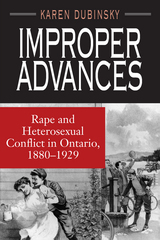 Improper Advances: Rape and Heterosexual Conflict in Ontario, 1880-1929
Karen Dubinsky
University of Chicago Press, 1993 Why do men rape women? This is a question for which there are many political, psychological, and sociological answers, but few historical ones. Improper Advances is one of the first books to explore the history of sexual violence in any country. A study of women, men, and sexual crime in rural and northern Ontario, it expands the terms of current debates about sexuality and sexual violence.
Karen Dubinsky relies on criminal case files, a revealing but largely untapped source for social historians, to retell individual stories of sexual danger—crimes such as rape, abortion, seduction, murder, and infanticide. Her research supports many feminist analyses of sexual violence: that crimes are expressions of power, that courts are prejudiced by the victim's background, and that most assaults occur within the victims' homes and communities.
Dubinsky distinguishes herself from most feminist scholars, however, by refusing to view women solely as victims and sex as a tool of oppression. She finds that these women actively sought and took pleasure in sexuality, but they distinguished between wanted and unwanted sexual encounters and attempted to punish coercive sex despite obstacles in the court system and the community.
Confronting a number of key theoretical and historiographic controversies, including recent debates over sexuality in feminist theory and politics, she challenges current thinking on the history of women, gender, and sexuality.
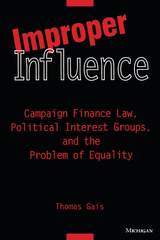 Improper Influence: Campaign Finance Law, Political Interest Groups, and the Problem of Equality
Thomas Gais
University of Michigan Press, 1998 Why is there still so much dissatisfaction with the role of special interest groups in financing American election campaigns, even though no aspect of interest group politics has been so thoroughly regu-lated and constrained? This book argues that part of the answer lies in the laws themselves, which prevent many hard-to-organize citizen groups from forming effective political action committees (PACs), while actually helping business groups organize PACs.
Thomas L. Gais points out that many laws that regulate group involvement in elections ignore the real difficulties of political mobilization, and he concludes that PACs and the campaign finance laws reflect a fundamental discrepancy between grassroots ideals and the ways in which broadly based groups actually get organized.
". . . . of fundamental scholarly and practical importance. The implications for 'reform' are controversial, flatly contradicting other recent reform proposals . . . . I fully expect that Improper Influence will be one of the most significant books on campaign finance to be published in the 1990s." --Michael Munger, Public Choice
"It is rare to find a book that affords a truly fresh perspective on the role of special interest groups in the financing of U.S. elections. It is also uncommon to find a theoretically rigorous essay confronting a topic usually grounded in empirical terms. . . . Improper Influence scores high on both counts and deserves close attention from students of collective action, campaign finance law, and the U.S. political process more generally." --American Political Science Review
Thomas L. Gais is Senior Fellow, The Nelson A. Rockefeller Institute of Government, State University of New York.
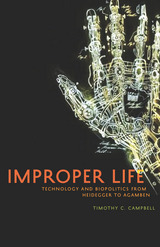 Improper Life: Technology and Biopolitics from Heidegger to Agamben
Timothy C. Campbell
University of Minnesota Press, 2011 Has biopolitics actually become thanatopolitics, a field of study obsessed with death? Is there something about the nature of biopolitical thought today that makes it impossible to deploy affirmatively? If this is true, what can life-minded thinkers put forward as the merits of biopolitical reflection? These questions drive Improper Life, Timothy C. Campbell’s dexterous inquiry-as-intervention. Campbell argues that a “crypto-thanatopolitics” can be teased out of Heidegger’s critique of technology and that some of the leading scholars of biopolitics—including Michel Foucault, Giorgio Agamben, and Peter Sloterdijk—have been substantively influenced by Heidegger’s thought, particularly his reading of proper and improper writing. In fact, Campbell shows how all of these philosophers have pointed toward a tragic, thanatopolitical destination as somehow an inevitable result of technology. But in Improper Life he articulates a corrective biopolitics that can begin with rereadings of Foucault (especially his late work regarding the care and technologies of the self), Freud (notably his writings on the drives and negation), and Gilles Deleuze (particularly in the relation of attention to aesthetics). Throughout Improper Life, Campbell insists that biopolitics can become more positive and productively asserts an affirmative technē not thought through thanatos but rather practiced through bíos.
 Improper Names: Collective Pseudonyms from the Luddites to Anonymous
Marco Deseriis
University of Minnesota Press, 2015 Improper Names offers a genealogy and theory of the “improper name,” which author Marco Deseriis defines as the adoption of the same pseudonym by organized collectives, affinity groups, and individual authors. Although such names are often invented to pursue a specific social or political agenda, they are soon appropriated for different and sometimes diverging purposes. This book examines the tension arising from struggles for control of a pseudonym’s symbolic power. Deseriis provides five fascinating and widely varying case studies. Ned Ludd was the legendary and eponymous leader of the English Luddites, textile workers who threatened the destruction of industrial machinery and then advanced a variety of economic and political demands. Alan Smithee—an alias coined by Hollywood film directors in 1969 in order to disown films that were recut by producers—became a contested signature and was therefore no longer effective to signal prevarication to Hollywood insiders. Monty Cantsin was an “open pop star” created by U.S. and Canadian artists in the late 1970s to critique bourgeois notions of authorship, but its communal character was compromised by excessive identification with individual users of the name. The Italian media activists calling themselves Luther Blissett, aware of the Cantsin experience, implemented measures to prevent individuals from assuming the alias, which was used to author media pranks, sell apocryphal manuscripts to publishers, fabricate artists and artworks, and author best-selling novels. The longest chapter here is devoted to the contemporary “hacktivist” group known as Anonymous, which protests censorship and restricted access to information and information technologies. After delving into a rich philosophical debate on community among those who have nothing in common, the book concludes with a reflection on how the politics of improper names affects present-day anticapitalist social movements such as Occupy and 15-M.
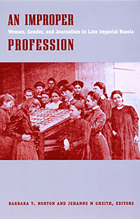 An Improper Profession: Women, Gender, and Journalism in Late Imperial Russia
Barbara T. Norton and Jehanne M Gheith, eds.
Duke University Press, 2001 Journalism has long been a major factor in defining the opinions of Russia’s literate classes. Although women participated in nearly every aspect of the journalistic process during the nineteenth and early twentieth centuries, female editors, publishers, and writers have been consistently omitted from the history of journalism in Imperial Russia. An Improper Profession offers a more complete and accurate picture of this history by examining the work of these under-appreciated professionals and showing how their involvement helped to formulate public opinion. In this collection, contributors explore how early women journalists contributed to changing cultural understandings of women’s roles, as well as how class and gender politics meshed in the work of particular individuals. They also examine how female journalists adapted to—or challenged—censorship as political structures in Russia shifted. Over the course of this volume, contributors discuss the attitudes of female Russian journalists toward socialism, Russian nationalism, anti-Semitism, women’s rights, and suffrage. Covering the period from the early 1800s to 1917, this collection includes essays that draw from archival as well as published materials and that range from biography to literary and historical analysis of journalistic diaries. By disrupting conventional ideas about journalism and gender in late Imperial Russia, An Improper Profession should be of vital interest to scholars of women’s history, journalism, and Russian history. Contributors. Linda Harriet Edmondson, June Pachuta Farris, Jehanne M Gheith, Adele Lindenmeyr, Carolyn Marks, Barbara T. Norton, Miranda Beaven Remnek, Christine Ruane, Rochelle Ruthchild, Mary Zirin
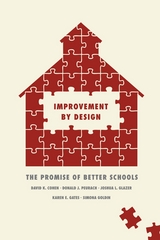 Improvement by Design: The Promise of Better Schools
David K. Cohen, Donald J. Peurach, Joshua L. Glazer, Karen E. Gates, and Simona Goldin
University of Chicago Press, 2013 One of the great challenges now facing education reformers in the United States is how to devise a consistent and intelligent framework for instruction that will work across the nation’s notoriously fragmented and politically conflicted school systems. Various programs have tried to do that, but only a few have succeeded. Improvement by Design looks at three different programs, seeking to understand why two of them—America’s Choice and Success for All—worked, and why the third—Accelerated Schools Project—did not.
The authors identify four critical puzzles that the successful programs were able to solve: design, implementation, improvement, and sustainability. Pinpointing the specific solutions that clearly improved instruction, they identify the key elements that all successful reform programs share. Offering urgently needed guidance for state and local school systems as they attempt to respond to future reform proposals, Improvement by Design gets America one step closer to truly successful education systems.
Improving Decisionmaking in a Turbulent World: Strategic Rethink
Charles P. Ries
RAND Corporation, 2016 Every president needs a decisionmaking system that harnesses the full capabilities and accumulated wisdom of the U.S. government and the nation’s many stakeholders. This Perspective analyzes a range of management challenges in the national security system and presents recommendations for strengthening U.S. decisionmaking and oversight of policy implementation.
Improving Dementia Long-Term Care: A Policy Blueprint
Regina A. Shih
RAND Corporation, 2014 In 2010, 15 percent of Americans older than age 70 had dementia. By 2050, the number of new dementia cases among those 65 and older is expected to double. This blueprint outlines policy options to help decisionmakers improve dementia long-term services and supports (LTSS) by promoting earlier detection, improving access to LTSS, promoting person- and caregiver-centered care, supporting caregivers, and reducing dementia LTSS costs.
 Improving Governance: A New Logic for Empirical Research
Laurence E. Lynn Jr., Carolyn J. Heinrich, and Carolyn J. Hill
Georgetown University Press, 2001 Policymakers and public managers around the world have become preoccupied with the question of how their goals can be achieved in a way that rebuilds public confidence in government. Yet because public policies and programs increasingly are being administered through a complicated web of jurisdictions, agencies, and public-private partnerships, evaluating their effectiveness is more difficult than in the past. Though social scientists possess insightful theories and powerful methods for conducting empirical research on governance and public management, their work is too often fragmented and irrelevant to the specific tasks faced by legislators, administrators, and managers. Proposing a framework for research based on the premise that any particular governance arrangement is embedded in a wider social, fiscal, and political context, Laurence E. Lynn Jr., Carolyn J. Heinrich, and Carolyn J. Hill argue that theory-based empirical research, when well conceived and executed, can be a primary source of fundamental, durable knowledge about governance and policy management. Focusing on complex human services such as public assistance, child protection, and public education, they construct an integrative, multilevel "logic of governance," that can help researchers increase the sophistication, power, and relevance of their work.
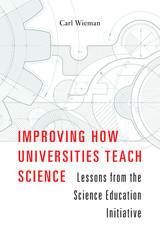 Improving How Universities Teach Science: Lessons from the Science Education Initiative
Carl Wieman
Harvard University Press, 2017 Too many universities remain wedded to outmoded ways of teaching science in spite of extensive research showing that there are much more effective methods. Too few departments ask whether what happens in their lecture halls is effective at helping students to learn and how they can encourage their faculty to teach better. But real change is possible, and Carl Wieman shows us how it can be brought about.
Improving How Universities Teach Science draws on Wieman’s unparalleled experience to provide a blueprint for educators seeking sustainable improvements in science teaching. Wieman created the Science Education Initiative (SEI), a program implemented across thirteen science departments at the universities of Colorado and British Columbia, to support the widespread adoption of the best research-based approaches to science teaching. The program’s data show that in the most successful departments 90 percent of faculty adopted better methods. Wieman identifies what factors helped and hindered the adoption of good teaching methods. He also gives detailed, effective, and tested strategies for departments and institutions to measure and improve the quality of their teaching while limiting the demands on faculty time.
Among all of the commentary addressing shortcomings in higher education, Wieman’s lessons on improving teaching and learning stand out. His analysis and solutions are not limited to just one lecture hall or course but deal with changing entire departments and universities. For those who want to improve how universities teach science to the next generation, Wieman’s work is a critical first step.
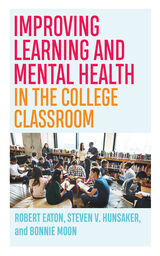 Improving Learning and Mental Health in the College Classroom
Robert Eaton
West Virginia University Press, 2023 How teachers can help combat higher education’s mental health crisis.
Mental health challenges on college campuses were a huge problem before COVID-19, and now they are even more pronounced. But while much has been written about higher education’s mental health crisis, very little research focuses on the role played by those on campus whose influence on student well-being may well be greatest: teachers. Drawing from interviews with students and the scholarship of teaching and learning, this book helps correct the oversight, examining how faculty can—instead of adding to their own significant workloads or duplicating counselors’ efforts—combat student stress through adjustments to the work they already do as teachers. Improving Learning and Mental Health in the College Classroom provides practical tips that reduce unnecessary discouragement. It demonstrates how small improvements in teaching can have great impacts in the lives of students with mental health challenges, while simultaneously boosting learning for all students.
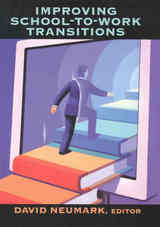 Improving School-to-Work Transitions
David Neumark
Russell Sage Foundation, 2007 As anxieties about America's economic competitiveness mounted in the 1980s, so too did concerns that the nation's schools were not adequately preparing young people for the modern workplace. Spurred by widespread joblessness and job instability among young adults, the federal government launched ambitious educational reforms in the 1990s to promote career development activities for students. In recent years, however, the federal government has shifted its focus to test-based reforms like No Child Left Behind that emphasize purely academic subjects. At this critical juncture in education reform, Improving School-To-Work Transitions, edited by David Neumark, weighs the successes and failures of the '90s-era school-to-work initiatives, and assesses how high schools, colleges, and government can help youths make a smoother transition into stable, well-paying employment. Drawing on evidence from national longitudinal studies, surveys, interviews, and case studies, the contributors to Improving School-To-Work Transitions offer thought-provoking perspectives on a variety of aspects of the school-to-work problem. Deborah Reed, Christopher Jepsen, and Laura Hill emphasize the importance of focusing school-to-work programs on the diverse needs of different demographic groups, particularly immigrants, who represent a growing proportion of the youth population. David Neumark and Donna Rothstein investigate the impact of school-to-work programs on the "forgotten half," students at the greatest risk of not attending college. Using data from the 1997 National Longitudinal Study of Youth, they find that participation by these students in programs like job shadowing, mentoring, and summer internships raise employment and college attendance rates among men and earnings among women. In a study of nine high schools with National Academy Foundation career academies, Terry Orr and her fellow researchers find that career academy participants are more engaged in school and are more likely to attend a four-year college than their peers. Nan Maxwell studies the skills demanded in entry-level jobs and finds that many supposedly "low-skilled" jobs actually demand extensive skills in reading, writing, and math, as well as the "new basic skills" of communication and problem-solving. Maxwell recommends that school districts collaborate with researchers to identify which skills are most in demand in their local labor markets. At a time when test-based educational reforms are making career development programs increasingly vulnerable, it is worth examining the possibilities and challenges of integrating career-related learning into the school environment. Written for educators, policymakers, researchers, and anyone concerned about how schools are shaping the economic opportunities of young people, Improving School-To-Work Transitions provides an authoritative guide to a crucial issue in education reform.
 Improving Science Education: International Perspectives
Edited by Barry J. Fraser and Herbert J. Walberg
University of Chicago Press, 1995 Specialists from Australia, Canada, Europe, the United Kingdom, and the United States present a broad range of perspectives for improving science education in primary and secondary schools.
This volume offers educators and researchers a glimpse at what peers from around the world have done to help science students achieve high levels of success. The introduction is a concise account of worldwide reform movements, from modernizations in the 1950s that dramatically improved the teaching of chemistry and physics to such changes in the 1980s as the emphasis on the learning-to-learn approach and the trend toward using social issues as a vehicle for teaching science.
The nine essays survey topics that include teaching inquiry skills and other techniques to foster a joy of science; creating an understanding of real-world applications of science; managing course instruction with computers; encouraging teachers to adopt new styles of teaching; cross-national comparisons of science achievement; and the differences between boys and girls in attitude, learning, and degree of participation.
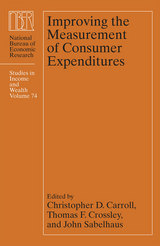 Improving the Measurement of Consumer Expenditures
Edited by Christopher D. Carroll, Thomas F. Crossley, and John Sabelhaus
University of Chicago Press, 2015 Robust and reliable measures of consumer expenditures are essential for analyzing aggregate economic activity and for measuring differences in household circumstances. Many countries, including the United States, are embarking on ambitious projects to redesign surveys of consumer expenditures, with the goal of better capturing economic heterogeneity. This is an appropriate time to examine the way consumer expenditures are currently measured, and the challenges and opportunities that alternative approaches might present.
Improving the Measurement of Consumer Expenditures begins with a comprehensive review of current methodologies for collecting consumer expenditure data. Subsequent chapters highlight the range of different objectives that expenditure surveys may satisfy, compare the data available from consumer expenditure surveys with that available from other sources, and describe how the United States’s current survey practices compare with those in other nations.
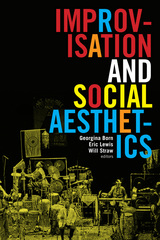 Improvisation and Social Aesthetics
Georgina Born, Eric Lewis, and Will Straw, editors
Duke University Press, 2017 Addressing a wide range of improvised art and music forms—from jazz and cinema to dance and literature—this volume's contributors locate improvisation as a key site of mediation between the social and the aesthetic. As a catalyst for social experiment and political practice, improvisation aids in the creation, contestation, and codification of social realities and identities. Among other topics, the contributors discuss the social aesthetics of the Association for the Advancement of Creative Musicians, the Feminist Improvising Group, and contemporary Malian music, as well as the virtual sociality of interactive computer music, the significance of "uncreative" improvisation, responses to French New Wave cinema, and the work of figures ranging from bell hooks and Billy Strayhorn to Kenneth Goldsmith. Across its diverse chapters, Improvisation and Social Aesthetics argues that ensemble improvisation is not inherently egalitarian or emancipatory, but offers a potential site for the cultivation of new forms of social relations. It sets out a new conceptualization of the aesthetic as immanently social and political, proposing a new paradigm of improvisation studies that will have reverberations throughout the humanities. Contributors. Lisa Barg, Georgina Born, David Brackett, Nicholas Cook, Marion Froger, Susan Kozel, Eric Lewis, George E. Lewis, Ingrid Monson, Tracey Nicholls, Winfried Siemerling, Will Straw, Zoë Svendsen, Darren Wershler
Improvisation for the Theater: A Handbook of Teaching and Directing Techniques
Viola Spolin
Northwestern University Press, 1999 The thoroughly revised third edition of the bible of improvisational theater.
Viola Spolin's improvisational techniques changed the very nature and practice of modern theater. The first two editions of Improvisation for the Theater sold more than 100,000 copies and inspired actors, directors, teachers, and writers in theater, television, film. These techniques have also influenced the fields of education, mental health, social work, and psychology. The revised edition features: - 30 new exercises, including introductions (Slow/Fast/Normal; Extended Sound; Mirror Speech; Unrelated Conversation)
- More than 200 updated classic exercises
- new section of traditional theater games for warm-up use
- “Paul Sills' Sayings of Viola Spolin”
- New glossary of side-coaching phrases, with definitions of their meaning and value
- Alphabetical list of all games and exercises
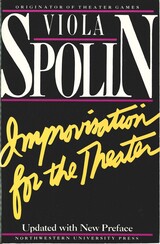 Improvisation for the Theater: A Handbook of Teaching and Directing Techniques
Viola Spolin
Northwestern University Press, 1983 In Force, Drive, Desire, Rudolf Bernet develops a philosophical foundation of psychoanalysis focusing on human drives. Rather than simply drawing up a list of Freud’s borrowings from Schopenhauer and Nietzsche, or Lacan’s from Hegel and Sartre, Bernet orchestrates a dialogue between philosophy and psychoanalysis that goes far beyond what these eminent psychoanalysts knew about philosophy. By relating the writings of Freud, Lacan, and other psychoanalysts to those of Aristotle, Leibniz, Schopenhauer, Nietzsche, Husserl, Heidegger, and, more tacitly, Bergson and Deleuze, Bernet brings to light how psychoanalysis both prolongs and breaks with the history of Western metaphysics and philosophy of nature.
Rereading the long history of metaphysics (or at least a few of its key moments) in light of psychoanalytic inquiries into the nature and function of drive and desire also allows for a rewriting of the history of philosophy. Specifically, it allows Bernet to bring to light a different history of metaphysics, one centered less on Aristotelian substance (ousia) and more on the concept of dunamis—a power or potentiality for a realization toward which it strives with all its might. Relating human drives to metaphysical forces also bears fruit for a renewed philosophy of life and subjectivity.
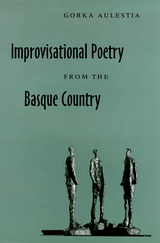 Improvisational Poetry from the Basque Country
Gorka Aulestia
University of Nevada Press, 1995 Foreword by William A. Douglass Translated by Lisa Corcostegui and Linda White.Improvisational Poetry from the Basque Country introduces the Basque bertsolari to the English-speaking world and provides an understanding of an interesting cultural phenomenon—the artist in Basque society who is capable of improvising verse on any subject spontaneously and setting it to music. The tradition is at least several centuries old and runs the gamut from amateurish efforts to periodic national championship competitions. These competitions draw thousands of listeners and pack theaters while many other thousands tune their radios to the broadcasts of the performances. Aulestia takes a scholarly and in-depth look at the art of the bertsolari. In a fascinating text, the author examines the history of a tradition that is truly unique and completely Basque. He introduces and analyzes the performing styles of great bertsolariak, including Xabier Amuriza and Jon Azpillaga. From the bertsolari’s roots in the old Basque Country to the social phenomenon it is today, Aulestia’s look at the improvisational oral literature of the Basques is an essential addition to their written history.
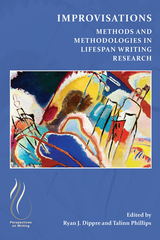 Improvisations: Methods and Methodologies in Lifespan Writing Research
Ryan J. Dippre
University Press of Colorado, 2025 Improvisations provides readers with insights and options as they develop new lifespan writing research projects or seek to re-orient existing projects to incorporate a lifespan lens. In Part 1 of this edited collection, contributors consider research methodologies that have been adapted to the particular demands of lifespan writing research, with each methodology given two chapters: one that outlines the process of taking up the methodology, and another that provides a detailed example of the methodology in action. In Part 2, contributors suggest new methodologies for lifespan writing research and highlight challenges that this line of inquiry presents as an ethical and socially conscious research agenda. These chapters, representing both established experts and new voices in writing, literacy, and education research, will be of use to graduate students and novice researchers, accomplished researchers pivoting to this area of study for the first time, and others who want to learn more about lifespan writing research.
Improvisations on a Missing String
Nazik Saba Yared
University of Arkansas Press, 1997 Nazik Saba Yared’s novel, Improvisations on a Missing String, tells the story of Saada Rayyis, who, after a mastectomy and prior to another operation which she may not survive, considers the course of her life with the purpose of understanding not only where she has been, but also where she is going. In her attempt to cope with complex feelings of alienation and insecurity, she struggles against traditional expectations in order to secure a sense of belonging and fulfillment—but always on her own terms. From her childhood in Palestine, through her university studies in Cairo, and finally as a teacher in Beirut, we follow the development of this independent woman as she comes to terms with her feelings about family, lovers, politics, art, and finally her own aspirations for belonging.
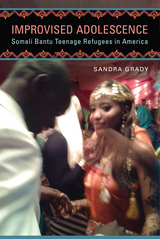 Improvised Adolescence: Somali Bantu Teenage Refugees in America
Sandra Grady
University of Wisconsin Press, 2015 Changing from child to young adult is difficult everywhere. But to experience childhood in continuous flight from conflict, then move into adolescence as a refugee in a radically different culture, is a more than usually complicated transition for teens and for their parents, communities, teachers, and social workers.
Improvised Adolescence explores how teenagers from southern Somalia, who spent much of their childhood in East African refugee camps, are adapting to resettlement in the American Midwest. The collapse of the Somali state in 1991, and subsequent chaos in the Horn of Africa, disrupted the lives of these young people educationally, culturally, and developmentally. Folklorist Sandra Grady has intermittently observed the lifeworld of these teens—their homes, their entertainment choices, their interaction with classmates and teachers at school, and their plans for the future—for more than seven years to understand the cultural tools they’ve used in their journey from this disrupted childhood. They negotiate two sets of cultural expectations: in the resettled Somali Bantu community, traditional rites of passage continue to mark the change from child to adult; in the surrounding U.S. culture, an unfamiliar in-between category—“adolescent”—delays adulthood. Offering analysis that is both engaging and theoretically grounded, Grady tracks the emergence in this immigrant community of an improvised adolescence.
Best books for public & secondary school libraries from university presses, American Library Association
 Improvised Cities: Architecture, Urbanization, and Innovation in Peru
Helen Gyger
University of Pittsburgh Press, 2018 Beginning in the 1950s, an explosion in rural-urban migration dramatically increased the population of cities throughout Peru, leading to an acute housing shortage and the proliferation of self-built shelters clustered in barriadas, or squatter settlements. Improvised Cities examines the history of aided self-help housing, or technical assistance to self-builders, which took on a variety of forms in Peru from 1954 to 1986. While the postwar period saw a number of trial projects in aided self-help housing throughout the developing world, Peru was the site of significant experiments in this field and pioneering in its efforts to enact a large-scale policy of land tenure regularization in improvised, unauthorized cities.
Gyger focuses on three interrelated themes: the circumstances that made Peru a fertile site for innovation in low-cost housing under a succession of very different political regimes; the influences on, and movements within, architectural culture that prompted architects to consider self-help housing as an alternative mode of practice; and the context in which international development agencies came to embrace these projects as part of their larger goals during the Cold War and beyond.
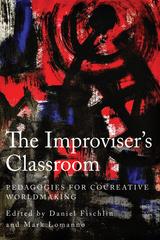 The Improviser's Classroom: Pedagogies for Cocreative Worldmaking
Edited by Daniel Fischlin and Mark Lomanno
Temple University Press, 2024 An adept improviser can find ways forward amid impasse, agency amid oppression, and community amid division. The editors and contributors to The Improviser’s Classroom present an array of critical approaches intended to reimagine pedagogy through the prisms of activism, reciprocity, and communal care.
Demonstrating how improvisation can inform scenes of teaching and learning, this volume also outlines how improvisatory techniques offer powerful, if not vital, tools for producing connection, creativity, accompaniment, reciprocity, meaningful revelation, and lifelong curiosity.
The Improviser's Classroom champions activist pedagogies and the public work essential for creating communities bound together by reciprocal care and equity.
Contributors: Sibongile Bhebhe, Judit Csobod, Michael Dessen, jashen edwards, Kate Galloway, Tomie Hahn, Petro Janse van Vuuren, Lauren Michelle Levesque, George Lipsitz, Rich Marsella, Tracy McMullen, Hafez Modirzadeh, Ed Sarath, Joe Sorbara, Jesse Stewart, Ellen Waterman, Carey West, and the editors
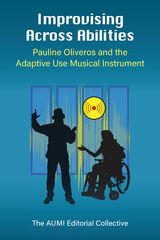 Improvising Across Abilities: Pauline Oliveros and the Adaptive Use Musical Instrument
The AUMI Editorial Collective
University of Michigan Press, 2024 Improvising Across Abilities: Pauline Oliveros and the Adaptive Use Musical Instrument (AUMI) brings together scholars, musicians, and family members of people with disabilities to collectively recount years of personal experiences, research, and perspectives on the societal and community impact of inclusive musical improvisation. One of the lesser-known projects of composer, improviser, and humanitarian, Pauline Oliveros (1932–2016), the AUMI was designed as a liberating and affordable alternative to the constraints of instruments created only for normative bodies, thus opening a doorway for people of all ages, genders, abilities, races, and socioeconomic backgrounds to access artistic practice with others. More than a book about AUMI, this book is an invitation to readers to use AUMI in their own communities.
This book, which contains wisdom from many who have been affected by their work with the instrument and the people who use it, is a representation of how music and extemporized performance have touched the lives and minds of scholars and families alike. Not only has AUMI provided the opportunity to grow in listening to others who may speak differently (or not at all), but it has been used as an avenue for a diverse set of people to build friendships with others whom they may have never otherwise even glanced at in the street. By providing a space for every person who comes across AUMI to perform, listen, improvise, and collaborate, the continuing development of this instrument contributes to a world in which every person is heard, welcomed, and celebrated.
Improvising Cinema
Gilles Mouëllic
Amsterdam University Press, 2014 This spirited volume explores the history and diversity of improvisation in the cinema, including works by Jean Renoir, Jean-Luc Godard, and Nobuhiro Suwa. Gilles Mouëllic examines improvisational practices that can be specifically attributed to the cinema and argues in favors of their powers as instigators of unprecedented forms of expression. Improvising Cinema reflects both on the permanence of attempting improvisation and the relationship between technology and aesthetics. Mouëllic concludes preservation becomes even more invaluable in the case of improvisation, as the creative act exists only within the brief time span of the performance.
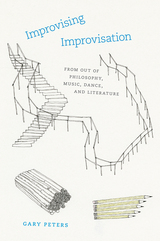 Improvising Improvisation: From Out of Philosophy, Music, Dance, and Literature
Gary Peters
University of Chicago Press, 2017 There is an ever-increasing number of books on improvisation, ones that richly recount experiences in the heat of the creative moment, theorize on the essence of improvisation, and offer convincing arguments for improvisation’s impact across a wide range of human activity. This book is nothing like that. In a provocative and at times moving experiment, Gary Peters takes a different approach, turning the philosophy of improvisation upside-down and inside-out.
Guided by Kant, Hegel, Heidegger, and especially Deleuze—and exploring a range of artists from Hendrix to Borges—Peters illuminates new fundamentals about what, as an experience, improvisation truly is. As he shows, improvisation isn’t so much a genre, idiom, style, or technique—it’s a predicament we are thrown into, one we find ourselves in. The predicament, he shows, is a complex entwinement of choice and decision. The performativity of choice during improvisation may happen “in the moment,” but it is already determined by an a priori mode of decision. In this way, improvisation happens both within and around the actual moment, negotiating a simultaneous past, present, and future. Examining these and other often ignored dimensions of spontaneous creativity, Peters proposes a consistently challenging and rigorously argued new perspective on improvisation across an extraordinary range of disciplines.
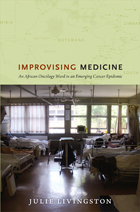 Improvising Medicine: An African Oncology Ward in an Emerging Cancer Epidemic
Julie Livingston
Duke University Press, 2012 In Improvising Medicine, Julie Livingston tells the story of Botswana's only dedicated cancer ward, located in its capital city of Gaborone. This affecting ethnography follows patients, their relatives, and ward staff as a cancer epidemic emerged in Botswana. The epidemic is part of an ongoing surge in cancers across the global south; the stories of Botswana's oncology ward dramatize the human stakes and intellectual and institutional challenges of an epidemic that will shape the future of global health. They convey the contingencies of high-tech medicine in a hospital where vital machines are often broken, drugs go in and out of stock, and bed-space is always at a premium. They also reveal cancer as something that happens between people. Serious illness, care, pain, disfigurement, and even death emerge as deeply social experiences. Livingston describes the cancer ward in terms of the bureaucracy, vulnerability, power, biomedical science, mortality, and hope that shape contemporary experience in southern Africa. Her ethnography is a profound reflection on the social orchestration of hope and futility in an African hospital, the politics and economics of healthcare in Africa, and palliation and disfigurement across the global south.
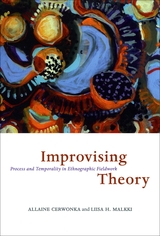 Improvising Theory: Process and Temporality in Ethnographic Fieldwork
Allaine Cerwonka and Liisa H. Malkki
University of Chicago Press, 2007 Scholars have long recognized that ethnographic method is bound up with the construction of theory in ways that are difficult to teach. The reason, Allaine Cerwonka and Liisa H. Malkki argue, is that ethnographic theorization is essentially improvisatory in nature, conducted in real time and in necessarily unpredictable social situations. In a unique account of, and critical reflection on, the process of theoretical improvisation in ethnographic research, they demonstrate how both objects of analysis, and our ways of knowing and explaining them, are created and discovered in the give and take of real life, in all its unpredictability and immediacy.
Improvising Theory centers on the year-long correspondence between Cerwonka, then a graduate student in political science conducting research in Australia, and her anthropologist mentor, Malkki. Through regular e-mail exchanges, Malkki attempted to teach Cerwonka, then new to the discipline, the basic tools and subtle intuition needed for anthropological fieldwork. The result is a strikingly original dissection of the processual ethics and politics of method in ethnography.
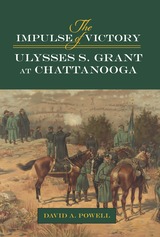 The Impulse of Victory: Ulysses S. Grant at Chattanooga
David A. Powell
Southern Illinois University Press, 2020 How Grant secured a Tennessee victory and a promotion Union soldiers in the Army of the Cumberland, who were trapped and facing starvation or surrender in the fall of 1863, saw the arrival of Major General Ulysses S. Grant in Tennessee as an impetus to reverse the tides of war. David A. Powell’s sophisticated strategic and operational analysis of Grant’s command decisions and actions shows how his determined leadership relieved the siege and shattered the enemy, resulting in the creation of a new strategic base of Union operations and Grant’s elevation to commander of all the Federal armies the following year. Powell’s detailed exploration of the Union Army of the Cumberland’s six-week-long campaign for Chattanooga is complemented by his careful attention to the personal issues Grant faced at the time and his relationships with his superiors and subordinates. Though unfamiliar with the tactical situation, the army, and its officers, Grant delivered another resounding victory. His success, explains Powell, was due to his tactical flexibility, communication with his superiors, perseverance despite setbacks, and dogged determination to win the campaign. Through attention to postwar accounts, Powell reconciles the differences between what happened and the participants’ memories of the events. He focuses throughout on Grant’s controversial decisions, showing how they were made and their impact on the campaign. As Powell shows, Grant’s choices demonstrate how he managed to be a thoughtful, deliberate commander despite the fog of war.
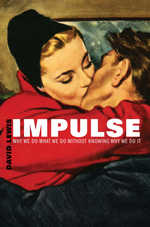 Impulse: Why We Do What We Do Without Knowing Why We Do It
David Lewis
Harvard University Press, 2013 “It seemed like a good idea at the time” has been the limp excuse of many a person whose actions later became cause for regret. Although we see ourselves as rational beings, we are far more likely to act according to impulse than logic. Nor is this always a bad thing, David Lewis suggests. Impulse explores all the mystifying things people do despite knowing better, from blurting out indiscretions to falling for totally incompatible romantic partners. Informed by the latest research in neuropsychology, this eye-opening account explains why snap decisions so often govern—and occasionally enrich—our lives.
Lewis investigates two kinds of thinking that occur in the brain: one slow and reflective, the other fast but prone to error. In ways we cannot control, our mental tracks switch from the first type to the second, resulting in impulsive actions. This happens in that instant when the eyes of lovers meet, when the hand reaches for a must-have product that the pocketbook can’t afford, when “I really shouldn’t” have another drink becomes “Oh why not?” In these moments, our rational awareness takes a back seat.
While we inevitably lose self-control on occasion, Lewis says, this can also be desirable, leading to experiences we cherish but would certainly miss if we were always logical. Less about the ideal reasoning we fail to use than the flawed reasoning we manage to get by with, Impulse proves there is more to a healthy mental life than being as coolly calculating as possible.
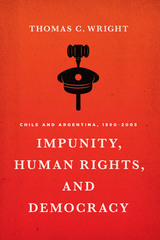 Impunity, Human Rights, and Democracy: Chile and Argentina, 1990-2005
By Thomas C. Wright
University of Texas Press, 2014 Universal human rights standards were adopted in 1948, but in the 1970s and 1980s, violent dictatorships in Argentina and Chile flagrantly defied the new protocols. Chilean general Augusto Pinochet and the Argentine military employed state terrorism in their quest to eradicate Marxism and other forms of “subversion.” Pinochet constructed an iron shield of impunity for himself and the military in Chile, while in Argentina, military pressure resulted in laws preventing prosecution for past human rights violations. When democracy was reestablished in both countries by 1990, justice for crimes against humanity seemed beyond reach. Thomas C. Wright examines how persistent advocacy by domestic and international human rights groups, evolving legal environments, unanticipated events that impacted public opinion, and eventual changes in military leadership led to a situation unique in the world—the stripping of impunity not only from a select number of commanders of the repression but from all those involved in state terrorism in Chile and Argentina. This has resulted in trials conducted by national courts, without United Nations or executive branch direction, in which hundreds of former repressors have been convicted and many more are indicted or undergoing trial. Impunity, Human Rights, and Democracy draws on extensive research, including interviews, to trace the erosion and collapse of the former repressors’ impunity—a triumph for human rights advocates that has begun to inspire authorities in other Latin American countries, including Peru, Uruguay, Brazil, and Guatemala, to investigate past human rights violations and prosecute their perpetrators.
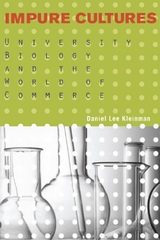 Impure Cultures: University Biology and the World of Commerce
Daniel Lee Kleinman
University of Wisconsin Press, 2003 How are the worlds of university biology and commerce blurring? Many university leaders see the amalgamation of academic and commercial cultures as crucial to the future vitality of higher education in the United States. In Impure Cultures, Daniel Lee Kleinman questions the effect of this blending on the character of academic science.
Using data he gathered as an ethnographic observer in a plant pathology lab at the University of Wisconsin–Madison, Kleinman examines the infinite and inescapable influence of the commercial world on biology in academia today. Contrary to much of the existing literature and common policy practices, he argues that the direct and explicit relations between university scientists and industrial concerns are not the gravest threat to academic research. Rather, Kleinman points to the less direct, but more deeply-rooted effects of commercial factors on the practice of university biology. He shows that to truly understand research done at universities today, it is first necessary to explore the systematic, pervasive, and indirect effects of the commercial world on contemporary academic practice.
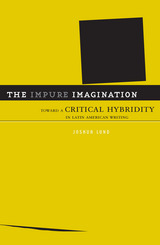 The Impure Imagination: Toward A Critical Hybridity In Latin American Writing
Joshua Lund
University of Minnesota Press, 2006 “Hybridity” is a term that has been applied to Latin American politics, literature, and intellectual life for more than a century. During the past two decades, it has figured in—and been transfigured by—the work of prominent postcolonialist writers and thinkers throughout the Americas.
In this pathbreaking work, Joshua Lund offers a thoughtful critique of hybridity by reading contemporary theories of cultural mixing against their historical precursors. The Impure Imagination is the first book to systematically analyze today’s dominant theories in relation to earlier, narrative manifestations of hybridity in Latin American writing, with a particular focus on Mexico and Brazil.
Generally understood as the impurification of standard or canonized forms, hybridity has historically been embraced as a basic marker of Latin American regional identity and as a strategy of resistance to cultural imperialism. Lund contends that Latin American theories and narratives of hybridity have been, and continue to be, underwritten by a structure of colonial power. Here he provides an informed critique and cogent investigation of this connection, its cultural effects, and its political implications. Using the emergence of hybridity as an analytical frame for thinking about culture in the Americas, Lund examines the contributions of influential thinkers, including Néstor García Canclini, Homi Bhabha, Jacques Derrida, Giorgio Agamben, Jorge Luis Borges, Antonio Candido, and many others.
Distinguished by its philosophical grounding and underpinned with case studies, The Impure Imagination employs postcolonial theory and theories of race as it explores Latin American history and culture. The result is an original and interrogative study of hybridity that exposes surprising—and unsettling—similarities with nationalistic discourses.
Joshua Lund is assistant professor of Spanish at the University of Pittsburgh. His essays have appeared in A Contracorriente, Race & Class, Cultural Critique, and the Journal of Latin American Cultural Studies.
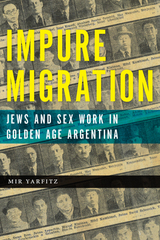 Impure Migration: Jews and Sex Work in Golden Age Argentina
Mir Yarfitz
Rutgers University Press, 2019 Impure Migration investigates the period from the 1890s until the 1930s, when prostitution was a legal institution in Argentina and the international community knew its capital city Buenos Aires as the center of the sex industry. At the same time, pogroms and anti-Semitic discrimination left thousands of Eastern European Jewish people displaced, without the resources required to immigrate. For many Jewish women, participation in prostitution was one of very few ways they could escape the limited options in their home countries, and Jewish men facilitate their transit and the organization of their work and social lives. Instead of marginalizing this story or reading it as a degrading chapter in Latin American Jewish history, Impure Migration interrogates a complicated social landscape to reveal that sex work is in fact a critical part of the histories of migration, labor, race, and sexuality.
Impurity and Purification in Early Judaism and the Jesus Tradition
Thomas Kazen
SBL Press, 2021 This collection of essays by Thomas Kazen focuses on issues of purity and purification in early Judaism and the Jesus tradition. During the late Second Temple period, Jewish purity practices became more prominent than before and underwent substantial developments. These essays advance the ongoing conversation and debate about a number of key issues in the field, such as the relationship between ritual and morality, the role and function of metaphor, and the use of evolutionary and embodied perspectives. Kazen's research stands in constant dialogue with the major currents and main figures in purity research, including both historical (origin, development, practice) and cognitive (evolutionary, emotional, conceptual) approaches.
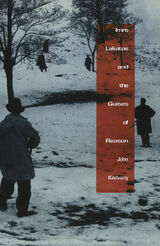 Imre Lakatos and the Guises of Reason
John Kadvany
Duke University Press, 2001 The Hungarian émigré Imre Lakatos (1922–1974) earned a worldwide reputation through the influential philosophy of science debates involving Thomas Kuhn, Paul Feyerabend, and Sir Karl Popper. In Imre Lakatos and the Guises of Reason John Kadvany shows that embedded in Lakatos’s English-language work is a remarkable historical philosophy rooted in his Hungarian past. Below the surface of his life as an Anglo-American philosopher of science and mathematics, Lakatos covertly introduced novel transformations of Hegelian and Marxist ideas about historiography, skepticism, criticism, and rationality.
Lakatos escaped Hungary following the failed 1956 Revolution. Before then, he had been an influential Communist intellectual and was imprisoned for years by the Stalinist regime. He also wrote a lost doctoral thesis in the philosophy of science and participated in what was criminal behavior in all but a legal sense. Kadvany argues that this intellectual and political past animates Lakatos’s English-language philosophy, and that, whether intended or not, Lakatos integrated a penetrating vision of Hegelian ideas with rigorous analysis of mathematical proofs and controversial histories of science.
Including new applications of Lakatos’s ideas to the histories of mathematical logic and economics and providing lucid exegesis of many of Hegel’s basic ideas, Imre Lakatos and the Guises of Reason is an exciting reconstruction of ideas and episodes from the history of philosophy, science, mathematics, and modern political history.
 IN & OZ: A Novel
Steve Tomasula
University of Chicago Press, 2012 Steve Tomasula is a novelist like no other; his experiments in narrative and design have won him a loyal following. Exemplifying Tomasula’s style, IN & OZ is a heady, avant-garde book, rooted in convincing characters even as it simultaneously subverts the genre of novel and moves it forward.
IN & OZ is a novel of art, love, and auto mechanics. The story follows five different characters—an auto designer, photographer, musical composer, poet/sculptor, and mechanic—who live in two very different places: IN, a back-alley here and now; and OZ, which reflects the desire for somewhere better. The men and women who populate Tomasula’s landscape desperately hope to fill a void in their lives through a variety of media: music, language, dirt, light, and automobiles. As the plot moves forward, the story of the residents of INand that of their counterparts in OZconverge. A fanciful allegory that tackles class relations, art, commerce, and language, IN & OZ is a tale of the human condition that is as visually compelling as it is moving.
A novel not only for fiction lovers, but also for artists of all stripes, IN & OZ creates a fantasy that illumines our own world as it lucidly builds its own.
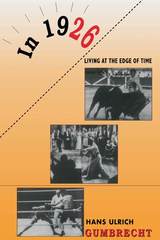 In 1926: Living on the Edge of Time
Hans Ulrich Gumbrecht
Harvard University Press, 1997 Travel back to the year 1926 and into the rush of experiences that made people feel they were living on the edge of time. Touch a world where speed seemed the very essence of life. It is a year for which we have no expectations. It was not 1066 or 1588 or 1945, yet it was the year A. A. Milne published Winnie-the-Pooh and Alfred Hitchcock released his first successful film, The Lodger. A set of modern masters was at work--Jorge Luis Borges, Babe Ruth, Leni Riefenstahl, Ernest Hemingway, Josephine Baker, Greta Garbo, Franz Kafka, Gertrude Stein, Martin Heidegger--while factory workers, secretaries, engineers, architects, and Argentine cattle-ranchers were performing their daily tasks.
Hans Ulrich Gumbrecht opens up the space-time continuum by exploring the realities of the day such as bars, boxing, movie palaces, elevators, automobiles, airplanes, hair gel, bullfighting, film stardom, dance crazes, and the surprise reappearance of King Tut after a three-thousand-year absence. From the vantage points of Berlin, Buenos Aires, and New York, Gumbrecht ranges widely through the worlds of Spain, Italy, France, and Latin America. The reader is allowed multiple itineraries, following various routes from one topic to another and ultimately becoming immersed in the activities, entertainments, and thought patterns of the citizens of 1926.
We learn what it is to be an "ugly American" in Paris by experiencing the first mass influx of American tourists into Europe. We visit assembly lines which turned men into machines. We relive a celebrated boxing match and see how Jack Dempsey was beaten yet walked away with the hearts of the fans. We hear the voice of Adolf Hitler condemning tight pants on young men. Gumbrecht conveys these fragments of history as a living network of new sensibilities, evoking in us the excitement of another era.
In a Beautiful Country
Kevin Prufer
Four Way Books, 2011 In a Beautiful Country examines America’s suburbs and exurbs where “The thrown newspaper fails / to reach the steps.” Taking place beside hospital beds and amid outlet malls, within earshot of military bases and in the light of horror movies, these poems mourn the loss of parents, friends, and our sense of our nation. Turning to ballad-like rhythms, Prufer critiques romanticized visions of art while asserting its central role in citizenship and empire.
 In a Cabin, in the Woods
Michael Krüger
Seagull Books, 2024 A personal perspective on the challenges of living through a global pandemic.
When the COVID-19 pandemic hit, Michael Krüger was suffering from severe shingles and just beginning treatment for leukemia. Because his immune system was so compromised that even a cough would have knocked him flat, he had to stay away from people. He retired to a wooden house near Lake Starnberg in Germany, and from there he dispatched his poetic messages. Krüger’s meditations from quarantine were printed for many months in the magazine of the Süddeutsche Zeitung and met with an enthusiastic response. In a Cabin, in the Woods collects fifty tableaux of nature, images of the immediate surroundings of a restricted life that also look beyond the horizon. At the same time, these poems look inward to explore transience, illness, and death. Humorous and melancholy, these are studies of the world made with the tiniest compass—meditations on nature and the nature of self that touch us all.
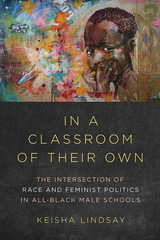 In a Classroom of Their Own: The Intersection of Race and Feminist Politics in All-Black Male Schools
Keisha Lindsay
University of Illinois Press, 2018 Many advocates of all-black male schools (ABMSs) argue that these institutions counter black boys’ racist emasculation in white, “overly” female classrooms. This argument challenges racism and perpetuates antifeminism.
Keisha Lindsay explains the complex politics of ABMSs by situating these schools within broader efforts at neoliberal education reform and within specific conversations about both "endangered” black males and a “boy crisis” in education. Lindsay also demonstrates that intersectionality, long considered feminist, is in fact a politically fluid framework. As such, it represents a potent tool for advancing many political agendas, including those of ABMSs supporters who champion antiracist education for black boys while obscuring black girls’ own race and gender-based oppression in school. Finally, Lindsay theorizes a particular means by which black men and other groups can form antiracist and feminist coalitions even when they make claims about their experiences that threaten bridge building. The way forward, Lindsay shows, allows disadvantaged groups to navigate the racial and gendered politics that divide them in pursuit of productive—and progressive—solutions.
Far-thinking and boldly argued, In a Classroom of Their Own explores the dilemmas faced by professionals and parents in search of equitable schooling for all students—black boys and otherwise.
 In a Closet Hidden: The Life and Work of Mary E. Wilkins Freeman
Leah Blatt Glasser
University of Massachusetts Press, 1996 The first literary biography of a much-neglected American writer, this book explores the multiple tensions at the core of Mary E. Wilkins Freeman's life and work. A prolific short story writer and novelist, Freeman (1852-1930) developed a reputation as a local colorist who depicted the peculiarities of her native New England. Yet as Leah Blatt Glasser shows, Freeman was one of the first American authors to write extensively about the relationships women form outside of marriage and motherhood, the role of work in women's lives, the complexity of women's sexuality, and the interior lives of women who rebel rather than conform to patriarchal strictures.
In a Closet Hidden traces Freeman's evolution as a writer, showing how her own inner conflicts repeatedly found expression in her art. As Glasser demonstrates, Freeman's work examined the competing claims of creativity and convention, self-fulfillment and self-sacrifice, spinsterhood and marriage, lesbianism and heterosexuality.
 In a Dark Time
Robert Jay Lifton
Harvard University Press, 1984 In a Dark Time is an anthology for the nuclear age, created by two professional psychologists who have ordered their material so that the successive selections reflect and comment on one another, compelling the reader to think about the insanity of war. This book draws on thoughts and writings from more than two millennia: poets from Sappho to Robert Lowell, dreamers from Saint John the Divine to Martin Luther King, Jr., statesmen from Seneca to Winston Churchill, soldiers, churchmen, writers, leaders. Along with them are mingled the voices of people who have faced appalling danger in their own lifetimes--an American schoolchild, a Hiroshima grocer, a plague survivor, a Turkish dissident. Human beings appear at their best and at their worst: as savage warriors, as helpless victims, as dupes of "Nukespeak" and warlike propaganda, and finally as individuals with the courage to say no.
In a Dark Time will shock, warn, and ultimately inspire those many people who share the perception that humankind now stands on the brink of self-annihilation but who believe, with Theodore Roethke, that "in a dark time, the eye begins to see."
 In a Desert Garden: Love and Death among the Insects
John Alcock
University of Arizona Press, 1999 When John Alcock replaced the Bermuda grass in his suburban Arizona lawn with gravel, cacti, and fairy dusters, he was doing more than creating desert landscaping. He seeded his property with flowers to entice certain insects and even added a few cowpies to attract termites, creating a personal laboratory for ecological studies. His observations of life in his own front yard provided him with the fieldnotes for this unusual book. In a Desert Garden draws readers into the strange and fascinating world of plants and animals native to Arizona's Sonoran Desert.
As Alcock studies the plants in his yard, he shares thoughts on planting, weeding, and pruning that any gardener will appreciate. And when commenting on the mating rituals of spiders and beetles or marveling at the camouflage of grasshoppers and caterpillars, he uses humor and insight to detail the lives of the insects that live in his patch of desert. Celebrating the virtues of even aphids and mosquitoes, Alcock draws the reader into the intricacies of desert life to reveal the complex interactions found in this unique ecosystem. In a Desert Garden combines meticulous science with contemplations of nature and reminds us that a world of wonder lies just outside our own doors.
 In a Different Voice: Psychological Theory and Women’s Development
Carol Gilligan
Harvard University Press, 1993 This is the little book that started a revolution, making women’s voices heard, in their own right and with their own integrity, for virtually the first time in social scientific theorizing about women. Its impact was immediate and continues to this day, in the academic world and beyond. Translated into sixteen languages, with more than 700,000 copies sold around the world, In a Different Voice has inspired new research, new educational initiatives, and political debate—and helped many women and men to see themselves and each other in a different light.
Carol Gilligan believes that psychology has persistently and systematically misunderstood women—their motives, their moral commitments, the course of their psychological growth, and their special view of what is important in life. Here she sets out to correct psychology’s misperceptions and refocus its view of female personality. The result is truly a tour de force, which may well reshape much of what psychology now has to say about female experience.
 In a Different Voice: Psychological Theory and Women’s Development
Carol Gilligan
Harvard University Press, 2016 This is the little book that started a revolution, making women’s voices heard, in their own right and with their own integrity, for virtually the first time in social scientific theorizing about women. Its impact was immediate and continues to this day, in the academic world and beyond. Translated into sixteen languages, with more than 700,000 copies sold around the world, In a Different Voice has inspired new research, new educational initiatives, and political debate—and helped many women and men to see themselves and each other in a different light.
Carol Gilligan believes that psychology has persistently and systematically misunderstood women—their motives, their moral commitments, the course of their psychological growth, and their special view of what is important in life. Here she sets out to correct psychology’s misperceptions and refocus its view of female personality. The result is truly a tour de force, which may well reshape much of what psychology now has to say about female experience.
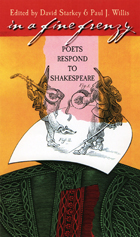 In a Fine Frenzy: Poets Respond to Shakespeare
Starkey, David
University of Iowa Press, 2005 Showcasing poems by more than ninety contemporary American poets, In a Fine Frenzyreveals what Shakespeare’s poetic children have made of their inheritance. Particularly interested in Viola, Miranda, Prospero, Desdemona, Iago, Lear, Cordelia, Hamlet, Horatio, and Ophelia, the poets respond to the sonnets, the comedies, the tragedies, the romances, and, to a lesser degree, Shakespeare the man. In so doing they reveal the aspects of his work most currently captivating to modern writers. Those who cherish Shakespeare’s mercurial wit will delight in the rapid shifts, from grief to hilarity, so characteristic of the bard himself. Comic poems about tragedies follow decidedly somber poems about comedies. Single poems contain multiple emotional twists and turns. Some pay homage; most interact directly with the original Shakespearean text. Collectively, they corroborate Ben Jonson's assertion that Shakespeare is “not of an age, but for all time.”
In a Hundred Graves: A Basque Portrait
Robert Laxalt
University of Nevada Press, 2016 The Basques of Europe are legendary for the curtain of privacy they have always drawn around their world, shielding it from visitors from the outside. As a result, accounts of the inner workings of Basque village life are almost nonexistent. In this unique book, author Robert Laxalt has managed to penetrate the deep reserve of Basque village folk. Shepherds, troubadours, merchants, and smugglers, caught up in the panorama of daily life, parade before the reader. They are portrayed against a backdrop of green rugged mountains and stone buildings, typical of the Basque provinces in France and Spain. Laxalt, an American born of Basque parents, unveils the Basque character with warmth, wry humor, and above all, honesty.
 In a Maelstrom: The History of Russian-Jewish Prose, 1860–1940
Zsuzsa Hetényi
Central European University Press, 2008 The first concise history of Russian-Jewish literary prose, this book discusses Russian-Jewish literarature in four periods, analyzing the turning points (1881–82, 1897, 1917) and proposing that the selected epoch (1860–1940) represents a special strand that was unfairly left out of both Russian and Jewish national literatures. Based on theoretical sources on the subject, the book establishes the criteria of dual cultural affiliation, and in a survey of Russian-Jewish literature presents the pitfalls of assimilation and discusses different forms of anti-Semitism. After showing the oeuvre of 18 representative authors as a whole, the book analyzes a number of characteristic novels and short stories in terms of contemporary literary studies. Many texts discussed have not been reprinted since their first publication. The material offers indispensable information not only for comparative and literary studies but for multicultural, historical, ethnographic, Judaist, religious and linguistic investigations as well.
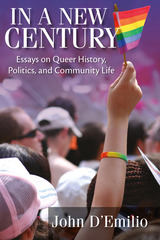 In a New Century: Essays on Queer History, Politics, and Community Life
John D’Emilio
University of Wisconsin Press, 2014 For gay, lesbian, bisexual, and transgender people in the United States, the twenty-first century has brought dramatic changes: the end of sodomy laws, the elimination of “Don’t Ask, Don’t Tell,” a move toward recognition of same-sex marriage, Gay-Straight Alliances in thousands of high schools, and an explosion of visibility in the media and popular culture. All of this would have been unimaginable to those living just a few decades ago. Yet, at the same time, the American political system has grown ever more conservative, and increasing economic inequality has been a defining feature of the new century.
A pioneering scholar of gay history, John D’Emilio reflects in this wide-ranging collection of essays upon the social, cultural, and political changes provoked by LGBT activism. He offers provocative questions and historical analyses: What can we learn from a life-long activist like Bayard Rustin, who questioned the wisdom of “identity politics”? Was Richard Nixon a “gay liberationist”? How can knowing local stories—like those of Chicago in the 1950s, 1960s, and 1970s—help build stronger communities and enrich traditions of activism? Might the focus on achieving actually be evidence of growing conservatism in LGBT communities?
In a New Century provides a dynamic, thoughtful, and important resource for identifying changes that have occurred in the United States since 1960, taking stock of the work that still needs to be done, and issuing an urgent call to action for getting there.
Best Books for General Audiences, selected by the American Association of School Librarians
Best Special Interest Books, selected by the Public Library Reviewers
 In a Patch of Fireweed: A Biologist’s Life in the Field
Bernd Heinrich
Harvard University Press, 1991 Why would a grown man chase hornets with a thermometer, paint whirligig beetles bright red, or track elephants through the night to fill trash bags with their prodigious droppings? Some might say—to advance science. Bernd Heinrich says—because it’s fun.
Heinrich, author of the much acclaimed Bumblebee Economics, has been playing in the wilds of one continent or another all his life. In the process, he has become one of the world’s foremost physiological ecologists. With In a Patch of Fireweed, he will undoubtedly become one of our foremost writers of popular science.
Part autobiography, part case study in the ways of field biology, In a Patch of Fireweed is an endlessly fascinating account of a scientist’s life and work. For the author, it is an opportunity to report not just his results but the curiosity, humor, error, passion, and competitiveness that feed into the process of discovery. For the reader, it is simply a delight, a rare chance to share the perceptions of an unusual mind fully in tune with the inner workings of nature. Before his years of research in the woodlands and deserts of North America, the New Guinea highlands, and the plains of East Africa, Heinrich had a sense of the wild that few people in this century can know. He tells the whole story, from his refugee childhood hidden in a German forest, eating mice fried in boar fat, to his ongoing research in the woods surrounding his cabin in Maine.
 In a Perfect Ocean: The State Of Fisheries And Ecosystems In The North Atlantic Ocean
Daniel Pauly and Jay Maclean
Island Press, 2002 Recent decades have been marked by the decline or collapse of one fishery after another around the world, from swordfish in the North Atlantic to orange roughy in the South Pacific. While the effects of a collapse on local economies and fishing-dependent communities have generated much discussion, little attention has been paid to its impacts on the overall health of the ocean's ecosystems. In a Perfect Ocean: The State of Fisheries and Ecosystems in the North Atlantic Ocean presents the first empirical assessment of the status of ecosystems in the North Atlantic ocean. Drawing on a wide range of studies including original research conducted for this volume, the authors analyze 14 large marine ecosystems to provide an indisputable picture of an ocean whose ecology has been dramatically altered, resulting in a phenomenon described by the authors as "fishing down the food web." The book: - provides a snapshot of the past health of the North Atlantic and compares it to its present status
- presents a rigorous scientific assessment based on the key criteria of fisheries catches, biomass, and trophic level
- considers the factors that have led to the current situation
- describes the policy options available for halting the decline
- offers recommendations for restoring the North Atlantic
An original and powerful series of maps and charts illustrate where the effects of overfishing are the most pronounced and highlight the interactions among various factors contributing to the overall decline of the North Atlantic's ecosystems. This is the first in a series of assessments by the world's leading marine scientists, entitled "The State of the World's Oceans." In a Perfect Ocean: The State of Fisheries and Ecosystems in the North Atlantic Ocean is a landmark study, the first of its kind to make a comprehensive, ecosystem-based assessment of the North Atlantic Ocean, and will be essential reading for policymakers at the state, national, and international level concerned with fisheries management, as well for scientists, researchers, and activists concerned with marine issues or fishing and the fisheries industry.
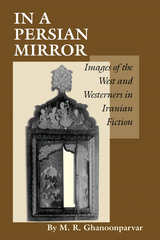 In a Persian Mirror: Images of the West and Westerners in Iranian Fiction
By M. R. Ghanoonparvar
University of Texas Press, 1993 The extreme anti-Western actions and attitudes of Iranians in the 1980s astonished and dismayed the West, which has characterized the Iranian positions as irrational and inexplicable. In this groundbreaking study of images of the West in Iranian literature, however, M. R. Ghanoonparvar reveals that these attitudes did not develop suddenly or inexplicably but rather evolved over more than two centuries of Persian-Western contact. Notable among the authors whose works Ghanoonparvar discusses are Sadeq Hedayat, M. A. Jamalzadeh, Hushang Golshiri, Gholamhoseyn Sa'edi, Simin Daneshvar, Moniru Ravanipur, Sadeq Chubak, and Jalal Al-e Ahmad. This survey significantly illuminates the sources of Iranian attitudes toward the West and offers many surprising discoveries for Western readers, not least of which is the fact that Iranians have often found Westerners to be as enigmatic and incomprehensible as we have believed them to be.
 In a Pickle: A Family Farm Story
Jerry Apps
University of Wisconsin Press, 2008 The year is 1955. Andy Meyer, a young farmer, manages the pickle factory in Link Lake, a rural town where the farms are small, the conversation is meandering, and the feeling is distinctly Midwestern. Workers sort, weigh, and dump cucumbers into huge vats where the pickles cure, providing a livelihood to local farmers. But the H. H. Harlow Pickle Company has appeared in town, using heavy-handed tactics to force family farmers to either farm the Harlow way or lose their biggest customer—and, possibly, their land. Andy, himself the owner of a half-acre pickle patch, works part-time for the Harlow Company, a conflict that places him between the family farm and the big corporation. As he sees how Harlow begins to change the rural community and the lives of its people, Andy must make personal, ethical, and life-changing decisions.
Best Books for General Audiences, selected by the American Association of School Librarians, and Outstanding Book, selected by the Public Library Association
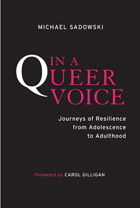 In a Queer Voice: Journeys of Resilience from Adolescence to Adulthood
Michael Sadowski
Temple University Press, 2013 Adolescence is a difficult time, but it can be particularly stressful for lesbian, gay, bisexual, transgender, and queer-identifying youth. In order to avoid harassment and rejection, many LGBTQ teens hide their identities from their families, peers, and even themselves.
Educator Michael Sadowski deftly brings the voices of LGBTQ youth out into the open in his poignant and important book, In a Queer Voice. Drawing on two waves of interviews conducted six years apart, Sadowski chronicles how queer youth, who were often “silenced” in school and elsewhere, now can approach adulthood with a strong, queer voice.
In a Queer Voice continues the critical conversation about LGBTQ youth issues—from bullying and suicide to other risks involving drug and alcohol abuse—by focusing on the factors that help young people develop positive, self-affirming identities. Using the participants’ heartfelt, impassioned voices, we hear what schools, families, and communities can do to help LGBTQ youth become resilient, confident adults.
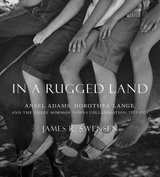 In a Rugged Land: Ansel Adams, Dorothea Lange, and the Three Mormon Towns Collaboration, 1953–1954
James Swensen
University of Utah Press, 2018 Though photographers Dorothea Lange and Ansel Adams were contemporaries and longtime friends, most of their work portrays contrasting subject matter. Lange’s artistic photodocumentation set a new aesthetic standard for social commentary; Adams lit up nature’s wonders with an unfailing eye and preeminent technical skill. That they joined together to photograph Mormons in Utah in the early 1950s for Life magazine may come as a surprise. In a Rugged Land examines the history and content of the two photographers’ forgotten collaboration Three Mormon Towns. Looking at Adams’s and Lange’s photographs, extant letters, and personal memories, the book provides a window into an important moment in their careers and seeks to understand why a project that once held such promise ended in disillusionment and is now little more than a footnote in their illustrative biographies. Swensen’s in-depth research and interpretation help make sense of what they did and place them alongside others who were also exploring the particular qualities of the Mormon village at that time. Winner of the Joan Paterson Kerr Book Award for best illustrated book on the history of the American West from the Western History Association. Winner of the Best Book Award from the Utah State Historical Society. Winner of the 15 Bytes Book Award for Art Book. Honorable mention for Best Book from the Mormon History Association. Interview with Tom Williams at Access Utah
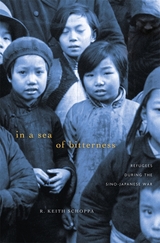 In a Sea of Bitterness: Refugees during the Sino-Japanese War
R. Keith Schoppa
Harvard University Press, 2011 The Japanese invasion of Shanghai in 1937 led some thirty million Chinese to flee their homes in terror, and live—in the words of artist and writer Feng Zikai—“in a sea of bitterness” as refugees. Keith Schoppa paints a comprehensive picture of the refugee experience in one province—Zhejiang, on the central Chinese coast—where the Japanese launched major early offensives as well as notorious later campaigns. He recounts stories of both heroes and villains, of choices poorly made amid war’s bewildering violence, of risks bravely taken despite an almost palpable quaking fear.
As they traveled south into China’s interior, refugees stepped backward in time, sometimes as far as the nineteenth century, their journeys revealing the superficiality of China’s modernization. Memoirs and oral histories allow Schoppa to follow the footsteps of the young and old, elite and non-elite, as they fled through unfamiliar terrain and coped with unimaginable physical and psychological difficulties. Within the context of Chinese culture, being forced to leave home was profoundly threatening to one’s sense of identity. Not just people but whole institutions also fled from Japanese occupation, and Schoppa considers schools, governments, and businesses as refugees with narratives of their own.
Local governments responded variously to Japanese attacks, from enacting scorched-earth policies to offering rewards for the capture of plague-infected rats in the aftermath of germ warfare. While at times these official procedures improved the situation for refugees, more often—as Schoppa describes in moving detail—they only deepened the tragedy.
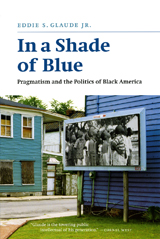 In a Shade of Blue: Pragmatism and the Politics of Black America
Eddie S. Glaude Jr.
University of Chicago Press, 2007 In this provocative book, Eddie S. Glaude Jr., one of our nation’s rising young African American intellectuals, makes an impassioned plea for black America to address its social problems by recourse to experience and with an eye set on the promise and potential of the future, rather than the fixed ideas and categories of the past. Central to Glaude’s mission is a rehabilitation of philosopher John Dewey, whose ideas, he argues, can be fruitfully applied to a renewal of African American politics.
According to Glaude, Dewey’s pragmatism, when attentive to the darker dimensions of life—or what we often speak of as the blues—can address many of the conceptual problems that plague contemporary African American discourse. How blacks think about themselves, how they imagine their own history, and how they conceive of their own actions can be rendered in ways that escape bad ways of thinking that assume a tendentious political unity among African Americans simply because they are black. Drawing deeply on black religious thought and literature, In a Shade of Blue seeks to dislodge such crude and simplistic thinking and replace it with a deeper understanding of and appreciation for black life in all its variety and intricacy. Glaude argues that only when black political leaders acknowledge such complexity can the real-life sufferings of many African Americans be remedied, an argument echoed in the recent rhetoric and optimism of the Barack Obama presidential campaign.
In a Shade of Blue is a remarkable work of political commentary and to follow its trajectory is to learn how African Americans arrived at this critical moment in their cultural and political history and to envision where they might head in the twenty-first century. “Eddie Glaude is the towering public intellectual of his generation.”—Cornel West
“Eddie Glaude is poised to become the leading intellectual voice of our generation, raising questions that make us reexamine the assumptions we hold by expanding our inventory of ideas.”—Tavis Smiley
 In a Village Far from Home: My Years among the Cora Indians of the Sierra Madre
Catherine Palmer Finerty
University of Arizona Press, 2000 What do most career women do after a successful run on Madison Avenue? Catherine Finerty watched her friends settle into the country-club life. She opted instead for Mexico. When the 60-year-old widow loaded up her car and headed south, what she found at the end of the road was far from what she expected. Finerty settled into a comfortable house just outside of Guadalajara and, although not a Catholic, she soon immersed herself in Franciscan volunteer work. It wasn't long before she found herself visiting small settlements hidden in the tropical mountains of western Mexico, and it was in Jesús María—so isolated that one could only get there by mule or small plane—that she found her new calling: the village nurse. With its bugs and heat, no phones or running water, the tiny town was hardly a place to enjoy one's retirement years, but Finerty was quickly charmed by the community of Cora Indians and mestizos. Armed with modest supplies, a couple of textbooks, and common sense, she found herself delivering first aid, advising on public health, and administering injections. And in a place where people still believed in the power of shamans, providing health care sometimes required giving in to the magical belief that a hypodermic needle could cure anything. Finerty's account of her eight years in Jesús María is both a compelling story of nursing under adverse conditions and a loving portrait of a people and their ways. She shares the joys and sorrows of this isolated world: religious festivals and rites of passage; the tragedy of illness and death in a place where people still rely on one another as much as medicine; a flash flood that causes such havoc that even less-than-pious village men attend Mass daily. And she introduces a cast of characters not unlike those in a novel: Padre Domingo and his airborne medical practice; the local bishop, who frowns on Finerty's slacks; Chela, a mestiza from whom she rents her modest two-room house (complete with scorpions); and the young Cora Indian woman Chuy, from whom she gains insight into her new neighbors. Blending memoir and travel writing, In a Village Far from Home takes readers deep into the Sierra Madre to reveal its true treasure: the soul of a people.
 In a Wounded Land: Conservation, Extraction, and Human Well-Being in Coastal Tanzania
Vinay R. Kamat
University of Arizona Press, 2024 Global efforts to conserve nature and prevent biodiversity loss have intensified in response to planetary-scale challenges—nowhere more so than in coastal regions. Accordingly, international conservation organizations have increased their efforts to promote marine protected areas as one of the interventions to prevent biodiversity loss in global hotspots.
Focusing on the human element of marine conservation and the extractive industry in Tanzania, this volume illuminates what happens when impoverished people living in underdeveloped regions of Africa are suddenly subjected to state-directed conservation and natural resource extraction projects, implemented in their landscapes of subsistence. In a Wounded Land draws on ethnographically rich case studies and vignettes collected over a ten-year period in several coastal villages on Tanzania’s southeastern border with Mozambique. In seven chapters, the book demonstrates how state power, processes of displacement and dispossession, forms of local resistance and acquiescence, environmental and social justice, and human well-being become interconnected.
Written in lucid, accessible language, this is the first book that reveals the social implications of the co-presence of a marine park and a gas project at a time when internationally funded conservation initiatives and extraction projects among rural African populations are engendering rapid social transformation.
In Africa's Forest and Jungle: Six Years Among the Yorubas
Richard Henry Stone, edited by Betty Finklea Florey
University of Alabama Press, 2009 In Africa's Forest and Jungle is the memoir of Richard Henry Stone, a Civil War era Southern Baptist missionary, who served in what is now Nigeria during the late 1850s and again during the first years of the American Civil War. Stone published this work in 1899, when it became clear that age would prevent him from returning to Africa.
Stone served in Africa with his wife and successfully learned the Yoruba language. He was an intelligent, self-reflective, and reliable observer, making his works important sources of information on Yoruba society before the intervention of European colonialism. In Africa's Forest and Jungle is a rare account of West African culture, made all the more complete by the additional journal entries, letters, and photographs collected in this edition.
In American Waters: The Sea in American Painting
Daniel Finamore
University of Arkansas Press, 2021 In American Waters is the catalog of an exhibition co-organized by Crystal Bridges Museum of American Art in Bentonville, Arkansas, and Peabody Essex Museum in Salem, Massachusetts. The exhibition and this associated catalog invite visitors to discover the sea as an expansive way to reflect on American culture and environment, learn how coastal and maritime symbols moved inland across the United States, and question what it means to be “in American waters.” Work by Georgia O’Keeffe, Amy Sherald, Kay WalkingStick, Norman Rockwell, Hale Woodruff, Paul Cadmus, Thomas Hart Benton, Jacob Lawrence, Valerie Hegarty, Stuart Davis, and many others is included, along with essays from scholars, critics, and the curators.
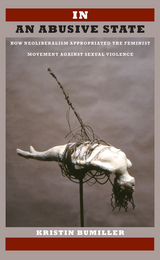 In an Abusive State: How Neoliberalism Appropriated the Feminist Movement against Sexual Violence
Kristin Bumiller
Duke University Press, 2008 In an Abusive State puts forth a powerful argument: that the feminist campaign to stop sexual violence has entered into a problematic alliance with the neoliberal state. Kristin Bumiller chronicles the evolution of this alliance by examining the history of the anti-violence campaign, the production of cultural images about sexual violence, professional discourses on intimate violence, and the everyday lives of battered women. She also scrutinizes the rhetoric of high-profile rape trials and the expansion of feminist concerns about sexual violence into the international human-rights arena. In the process, Bumiller reveals how the feminist fight against sexual violence has been shaped over recent decades by dramatic shifts in welfare policies, incarceration rates, and the surveillance role of social-service bureaucracies. Drawing on archival research, individual case studies, testimonies of rape victims, and interviews with battered women, Bumiller raises fundamental concerns about the construction of sexual violence as a social problem. She describes how placing the issue of sexual violence on the public agenda has polarized gender- and race-based interests. She contends that as the social welfare state has intensified regulation and control, the availability of services for battered women and rape victims has become increasingly linked to their status as victims and their ability to recognize their problems in medical and psychological terms. Bumiller suggests that to counteract these tendencies, sexual violence should primarily be addressed in the context of communities and in terms of its links to social disadvantage. In an Abusive State is an impassioned call for feminists to reflect on how the co-optation of their movement by the neoliberal state creates the potential to inadvertently harm impoverished women and support punitive and racially based crime control efforts.
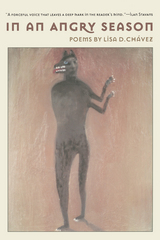 In an Angry Season
Lisa D. Chávez
University of Arizona Press, 2001 A white woman navigates her fear and uncertainty to learn the ways of the people she called savages, until she begins to dream “in Dakota, syllables sliding / on my tongue like tender pieces of meat.” An African man, on display as a cannibal at the World’s Columbian Exposition in 1893, sees into the future: “humiliations heaped up / as on overfilled plates . . . / . . . a country that casually / consumes its own.” A woman holds the gray-blue barrel of a gun in her mouth, “the taste familiar / as her own blood.” With an unexcelled command of narrative verse, Lisa Chávez tells the stories of American lives across more than a century. Whether retelling nineteenth-century captivity narratives or depicting contemporary American women confronting addiction and despair, Chávez investigates issues of identity and self-definition in the face of an often harsh and unremitting history. Her story-poems explore the ways in which people have been made captive—whether to racism or national policy, to bad marriages or alcoholism, to poverty or emotion—from the Inuit woman birthing a son among strangers to the wife now deranged by desire for another man: “He’s the smoky slow-burn of chipotle on the tongue. My golden idol. My gospel revival. He’s hashish sweet and languorous—my body’s one desire.” In the end, Chávez shows us a New World of promise in which an alchemist’s assistant summons stories from stones by calling their names with “clicks of her tongue, / syllables of silver, turquoise, and jade,” and a Native woman discovers her true power in an Alaskan bar. Passionate and political, In an Angry Season is a work of startling depth and breadth—an American history in poetry—that asks us what it means to be civilized.
In an Invisible Glass Case Which Is Also a Frame
Julia Guez
Four Way Books, 2019 A close look at the rigors of our current cultural moment, In an Invisible Glass Case Which Is Also a Frame offers readers a way to navigate vital questions: what does it mean to be “secure”? How do we make art amid complexity? In Guez’s debut, readers will witness realities of income inequality, climate change, and the opioid epidemic alongside a series of reliable antidotes: art, music, humor, and love. “Have we made it across the vast plain of night?” asks one poem. No, not quite. There is more night, but there is singing, too. Rich in its sophisticated engagement of a “still life” series, dilemmas large and small, political and personal, are treated with generosity, curiosity, and a precise investigation of the heart.
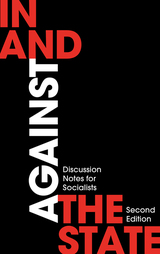 In and Against the State
London Edinburgh Weekend Return Group
Pluto Press, 2021 Originally published as a pamphlet in 1979 and again by Pluto in 1980, In and Against the State brought together questions of working-class struggle and state power, exploring how revolutionary socialists might reconcile working in the public sector with their radical politics. Informed by autonomist political ideas and practices that were central to the protests of 1968, the book’s authors spoke to a generation of activists wrestling with the question of where to place their energies.
Forty years have passed, yet the questions it posed are still to be answered. As the eclipse of Corbynism and the onslaught of the global pandemic have demonstrated with brutal clarity, a renewed socialist strategy is needed more urgently than ever.
This edition includes a new introduction by Seth Wheeler and an interview with John McDonnell that reflect on the continuing relevance of In and Against the State and the questions it raises.
In and Of the Mediterranean: Medieval and Early Modern Iberian Studies
Michelle M. Hamilton
Vanderbilt University Press, 2014 The Iberian Peninsula has always been an integral part of the Mediterranean world, from the age of Tartessos and the Phoenicians to our own era and the Union for the Mediterranean. The cutting-edge essays in this volume examine what it means for medieval and early modern Iberia and its people to be considered as part of the Mediterranean.
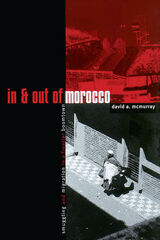 In And Out Of Morocco: Smuggling and Migration in a Frontier Boomtown
David Mcmurray
University of Minnesota Press, 2001 A revealing inquiry into how global culture is lived locally. Every summer for almost forty years, tens of thousands of Moroccan emigrants from as far away as Norway and Germany descend on the duty-free smugglers’ cove/migrant frontier boomtown of Nador, Morocco. David McMurray investigates the local effects of the multiple linkages between Nador and international commodity circuits, and analyzes the profound effect on everyday life of the free flow of bodies, ideas, and commodities into and out of the region. Combining immigration and population statistics with street-level ethnography, In and Out of Morocco covers a wide range of topics, including the origin and nature of immigrant nostalgia, the historical evolution of the music of migration in the region, and the influence of migrant wealth on social distinctions in Nador. Groundbreaking in its attention to the performative aspects of life in a smuggling border zone, the book also analyzes the way in which both migration and smuggling have affected local structures of feeling by contributing to the spread of hyperconsumption. The result is a rare and revealing inquiry into how the global culture is lived locally.
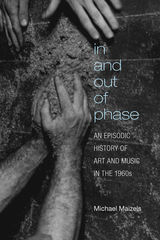 In and Out of Phase: An Episodic History of Art and Music in the 1960s
Michael Maizels
University of Michigan Press, 2020 Experimental artists and musicians thrived in New York, Los Angeles, and other creative hotspots in the 1960s, and those who would become major figures in the visual arts often worked closely with those who became the most recognized composers and performers of late-twentieth-century music. Yet, surprisingly little attention has been given to these connections, especially considering that such collaborations helped to shape subsequent histories of both fields.
In and Out of Phase is the first sustained look at the creative interactions between artists and musicians of this era, looking at four pairs of creators who used process-oriented ideas and techniques in their music and art: Dan Flavin and La Monte Young; Sol LeWitt and Milton Babbitt; Richard Serra and Steve Reich; and Bruce Nauman and Meredith Monk. Maizels uncovers not just the social and intellectual connections between these two groups of creators, but illuminates how the focus on repetitive actions, pattern and process, and an emphasis on “surface” created mutual influence—and stylistic change—between music and art during this period. The book’s concluding chapter briefly addresses the enduring influence of the innovations of the 1960s on more recent works.
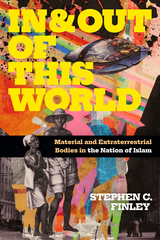 In and Out of This World: Material and Extraterrestrial Bodies in the Nation of Islam
Stephen C. Finley
Duke University Press, 2022 With In and Out of This World Stephen C. Finley examines the religious practices and discourses that have shaped the Nation of Islam (NOI) in America. Drawing on the speeches and writing of figures such as Elijah Muhammad, Malcolm X, Warith Deen Mohammad, and Louis Farrakhan, Finley shows that the NOI and its leaders used multiple religious symbols, rituals, and mythologies meant to recast the meaning of the cosmos and create new transcendent and immanent black bodies whose meaning cannot be reduced to products of racism. Whether examining how the myth of Yakub helped Elijah Muhammad explain the violence directed at black bodies, how Malcolm X made black bodies in the NOI publicly visible, or the ways Farrakhan’s discourses on his experiences with the Mother Wheel UFO organize his interpretation of black bodies, Finley demonstrates that the NOI intended to retrieve, reclaim, and reform black bodies in a context of antiblack violence.
In Another Time
Harold Schindler
Utah State University Press, 1998 An illustrated collection of historical articles originally published in the Salt Lake Tribune from 1993 to 1996, In
Another Time provides both an entertaining introduction to Utah and a distinguished and popular historian's summary views of the state's peculiar history.
Another Time will entertain and inform newcomers seeking an introductory understanding of what has made Utah different, old hands wanting to know more about the rich complexity of the state's past, and anyone who enjoys well-told historical tales.
In Babel's Shadow: Multilingual Literatures, Monolingual States
Brian Lennon
University of Minnesota Press, 2010 Multilingual literature defies simple translation. Beginning with this insight, Brian Lennon examines the resistance multilingual literature offers to book publication itself. In readings of G. V. Desani’s All about H. Hatterr, Anthony Burgess’s A Clockwork Orange, Christine Brooke-Rose’s Between, Eva Hoffman’s Lost in Translation, Emine Sevgi Özdamar’s Mutterzunge, and Orhan Pamuk’s Istanbul, among other works, Lennon shows how nationalized literary print culture inverts the values of a transnational age, reminding us that works of literature are, above all, objects in motion. Looking closely at the limit of both multilingual literary expression and the literary journalism, criticism, and scholarship that comments on multilingual work, In Babel’s Shadow presents a critical reflection on the fate of literature in a world gripped by the crisis of globalization.
 In Bad Faith: The Dynamics of Deception in Mark Twain’s America
Forrest Robinson
Harvard University Press, 1986 Something is not right in the world of Tom Sawyer and Huckleberry Finn. The unease is less evident to Tom, the manipulator, than to the socially marginal Huck. The trouble is most dramatically revealed when Huck, whose “sivilized” Christian conscience is developing, faces the choice between betraying his black friend Jim—which he believes is his moral duty—and letting him escape, as his heart tells him to do.
“Bad faith” is Forrest Robinson's name for the dissonance between what we profess to believe, how we act, and how we interpret our own behavior. There is bad faith in the small hypocrisies of daily living, but Robinson has a much graver issue in mind—namely slavery, which persisted for nearly a century in a Christian republic founded on ideals of freedom, equality, and justice. Huck, living on the fringes of small-town society, recognizes Jim's humanity and understands the desperateness of his plight. Yet Huck is white, a member of the dominant class; he is at once influenced and bewildered by the contradictions of bad faith in the minds of his fully acculturated contemporaries.
Robinson stresses that “bad faith” is more than a theme with Mark Twain; his bleak view of man's social nature (however humorously expressed), his nostalgia, his ambivalence about the South, his complex relationship to his audience, can all be traced back to an awareness of the deceits at the core of his culture—and he is not himself immune. This deeply perceptive book will be of interest to students of American literature and history and to anyone concerned with moral issues.
In Broken Latin: Poems
Annette Spaulding-Convy
University of Arkansas Press, 2012 In Broken Latin explores in a series of deft, witty, sexy, and soulful poems the misunderstood, idealized, and marginalized life of a modern Roman Catholic nun. In these poems, set in the patriarchal institution of the convent, Annette Spaulding-Convy comments on the American woman's struggle for spiritual identity in contemporary culture through the voice of an ex-nun now mother/wife creating a life for herself in the world, while searching for an ethical, spiritual meaning not dependent upon traditional religious dogma.
In Byron's Footsteps
Tessa de Loo
Haus Publishing, 2010 When Tessa de Loo saw Albania for the first time, no foreigners were allowed to enter. Filled with a great curiosity, longing, and a sense of wonderment by this isolated land, de Loo gazed toward the mountains that stood like "the backs of patiently waiting elephants" across the water from Corfu. Inspired by the famous Thomas Phillips portrait of Lord Byron in Albanian national costume, and enthralled by the image of Lord Byron since her teenage years, she sets about exploring not only his physical journey, but attempts to understand his inner one as well. de Loo stole her way in and found a country suffering the hardships of post-communist reality and the constant and sometimes fractious clash between tradition and modernity. In the tradition of Bruce Chatwin, de Loo, the award-winning author of The Twins, has written a fascinating travelogue and a very personal reassessment of the a formative chapter in Lord Byron's short life.
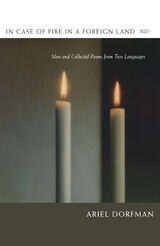 In Case of Fire in a Foreign Land: New and Collected Poems from Two Languages
Ariel Dorfman
Duke University Press, 2002 In the world of Chilean poet Ariel Dorfman, men and women can be forced to choose between leaving their country or dying for it. The living risk losing everything, but what they hold onto—love, faith, hope, truth—might change the world. It is this subversive possibility that speaks through these poems. A succession of voices—exiles, activists, separated lovers, the families of those victimized by political violence—gives an account of ruptured safety. They bear witness to the resilience of the human spirit in the face of personal and social damage in the aftermath of terror. The first bilingual edition of Dorfman’s work, In Case of Fire in a Foreign Land includes ten new poems and a new preface, and brings back into print the classic poems of the celebrated Last Waltz in Santiago. Always an eloquent voice against the ravages of inhumanity, Dorfman’s poems, like his acclaimed novels, continue to be a searing testimony of hope in the midst of despair.
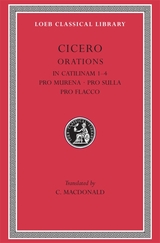 In Catilinam 1–4. Pro Murena. Pro Sulla. Pro Flacco
Cicero
Harvard University Press The statesman at the height of his powers.
Cicero (Marcus Tullius, 106–43 BC), Roman lawyer, orator, politician, and philosopher, of whom we know more than of any other Roman, lived through the stirring era that saw the rise, dictatorship, and death of Julius Caesar in a tottering republic. In his political speeches especially and in his correspondence we see the excitement, tension and intrigue of politics and the part he played in the turmoil of the time. Of about 106 speeches, delivered before the Roman people or the Senate if they were political, before jurors if judicial, fifty-eight survive (a few of them incompletely). In the fourteenth century Petrarch and other Italian humanists discovered manuscripts containing more than 900 letters of which more than 800 were written by Cicero and nearly 100 by others to him. These afford a revelation of the man all the more striking because most were not written for publication. Six rhetorical works survive and another in fragments. Philosophical works include seven extant major compositions and a number of others; and some lost. There is also poetry, some original, some as translations from the Greek.
The Loeb Classical Library edition of Cicero is in twenty-nine volumes.
 In Changing Times: Gay Men and Lesbians Encounter HIV/AIDS
Edited by Martin P. Levine, Peter M. Nardi, and John H. Gagnon
University of Chicago Press, 1997 The HIV/AIDS epidemic has been a major catastrophe for gay communities. In less than two decades, the disease has profoundly changed the lives of gay men and lesbians. Not just a biological and viral agent, HIV has become an opportunistic social invader, reshaping communities and the distribution of wealth, altering the social careers of gay professionals and the patterns of entry into gay and lesbian life, and giving birth to groups like ACT UP and Queer Nation.
The distinguished contributors to this volume discuss the ways HIV/AIDS has changed collective and individual identities, as well as lives, of gay men and lesbians, and how these alterations have changed our perceptions of the epidemic. They cover such topics as the impact of the epidemic on small towns, cultural barriers to AIDS prevention, gay youth and intergenerational relations, and the roles of lesbians in AIDS organizations. This collection provides compelling insights into the new communities among gay men and lesbians and the new kinds of identities and relationships that are emerging from the social and cultural ferment engendered by HIV/AIDS.
Contributors include Barry D. Adam, Lourdes Arguelles, Rafael Miguel Diaz, John H. Gagnon, Gilbert Herdt, Gregory M. Herek, Nan D. Hunter, Peter M. Nardi, John L. Peterson, Anne Rivero, Gayle S. Rubin, Beth E. Schneider, and Nancy E. Stoller.
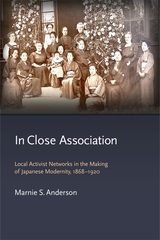 In Close Association: Local Activist Networks in the Making of Japanese Modernity, 1868–1920
Marnie S. Anderson
Harvard University Press, 2022 In Close Association is the first English-language study of the local networks of women and men who built modern Japan in the Meiji period (1868–1912). Marnie Anderson uncovers in vivid detail how a colorful group of Okayama-based activists founded institutions, engaged in the Freedom and People’s Rights Movement, promoted social reform, and advocated “civilization and enlightenment” while forging pathbreaking conceptions of self and society. Alongside them were Western Protestant missionaries, making this story at once a local history and a transnational one.
Placing gender analysis at its core, the book offers fresh perspectives on what women did beyond domestic boundaries, while showing men’s lives, too, were embedded in home and kin. Writing “history on the diagonal,” Anderson documents the gradual differentiation of public activity by gender in the late nineteenth and early twentieth centuries. Meiji-era associations became increasingly sex-specific, though networks remained heterosocial until the twentieth century.
Anderson attends to how the archival record shapes what historians can know about individual lives. She argues for the interdependence of women and men and the importance of highlighting connections between people to explain historical change. Above all, the study sheds new light on how local personalities together transformed Japan.
In Clouds of Glory: American Airmen Who Flew with the British during the Great War
James J. Hudson
University of Arkansas Press, 1999 Of the several hundred Americans who joined the Royal Air Force during the First World War, twenty-eight became aces by shooting down five or more aircraft. Unfortunately, those American aces who flew only with the British are little known by the American public. In Clouds of Glory tells the story of these fliers in the first air war, young men who risked their lives and citizenship to help the British fight off the German squadrons. An exhaustively researched study, In Clouds of Glory restores these American heroes to the place in history they had so bravely earned.
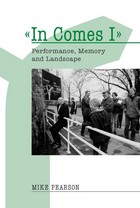 In Comes I: Performance, Memory and Landscape
Mike Pearson
University of Exeter Press, 2006
In Comes I explores performance and land, biography and locality, memory and place. The book reflects on performances past and present, taking the form of a series of excursions into the agricultural landscape of eastern England, and drawing from archaeology, geomorphology, folklore, and local and family history.
Mike Pearson, a leading theatre artist and solo-performer, returns to the landscape of his childhood – off the beaten track in Lincolnshire – and uses it as a mnemonic to reflect widely upon performance theory and practice. Rather than focusing on author, period and genre as is conventional in the study of drama, the book takes region as its optic, acknowledging the affective ties between people and place.
Offering new approaches to the study of performance, Pearson integrates intensely personal narrative with analytical reflection, juxtaposing anecdote with theoretical insight, dramatic text with interdisciplinary perception. The performances, ranging from folk drama to contemporary site-specific work, are seen in the light of their relationship to their cultural and physical environment.
 In Command of France: French Foreign Policy and Military Planning, 1933-1940
Robert J. Young
Harvard University Press, 1978 No other attempt to explain French civil and military leadership during the 1930s has been so gracefully written, so firmly based on archival material, or so sensitive to French conditions and purposes as In Command of France. It combines a detailed survey of French foreign policy during the Nazi period with a careful examination of France's corresponding military planning and preparation. France was under control, the author argues, and credits the civilian and military command with more vision, more determination, more competence than hitherto recognized.
Young introduces the reader to some of the leading personalities of the day--Laval, Bonnet, Weygand, Pétain, Gamelin, Delbos, Cot, Daladier--soldiers and statesmen whose names have come close to fading from our view. He outlines the problems and alternatives that confronted them in the Nazi years--strikes, lockouts, unemployment, inflating prices, devalued currency--and finds that they failed not because of an absence of policy or incompetence but because the problems they faced were insuperable.
In Common Cause: The “Conservative” Frances Trollope and the “Radical” Frances Wright
Susan S. Kissel
University of Wisconsin Press, 1993 Nineteenth century writers and reformers Frances Trollope and Frances Wright have always been viewed as ideological opposites. In Common Cause: The "Conservative" Frances Trollope and the "Radical" Frances Wright looks at their political commonalities rather than their differences. It traces the way in which these two women have been stereotyped and denigrated for over 100 years. It considers the many contributions of both women to the most significant political movements of their times: anti-slavery; women's rights; and industrial reform.
 In Concert: Performing Musical Persona
Phillip Auslander
University of Michigan Press, 2021 The conventional way of understanding what musicians do as performers is to treat them as producers of sound; some even argue that it is unnecessary to see musicians in performance as long as one can hear them. But musical performance, counters Philip Auslander, is also a social interaction between musicians and their audiences, appealing as much to the eye as to the ear. In Concert: Performing Musical Persona he addresses not only the visual means by which musicians engage their audiences through costume and physical gesture, but also spectacular aspects of performance such as light shows. Although musicians do not usually enact fictional characters on stage, they nevertheless present themselves to audiences in ways specific to the performance situation. Auslander’s term to denote the musician’s presence before the audience is musical persona. While presence of a musical persona may be most obvious within rock and pop music, the book’s analysis extends to classical music, jazz, blues, country, electronic music, laptop performance, and music made with experimental digital interfaces. The eclectic group of performers discussed include the Beatles, Miles Davis, Keith Urban, Lady Gaga, Nicki Minaj, Frank Zappa, B. B. King, Jefferson Airplane, Virgil Fox, Keith Jarrett, Glenn Gould, and Laurie Anderson.
 In Contagion's Wake: Black Writers and the Development of Modern Outbreak Narratives
Kelly L. Bezio
University of Massachusetts Press, 2026 An examination of early American literature that highlights how racial divides exacerbated—and were exacerbated by—the spread of infection
In April of 1721, the HMS Seahorse arrived in Boston from the West Indies, causing a smallpox epidemic that would plague the city for the next year. Of its 12,000 inhabitants, nearly fifty percent were infected, and 900 people died. Like the coronavirus pandemic that began in 2020, the outbreak also brought to the surface deep divides in the social fabric of colonial New England and laid the groundwork for racialized political inequities that we continue to grapple with today.
In Contagion’s Wake examines a range of American outbreak narratives, both historical and fictional, written between the early 1700s and the early 1900s—from the rise of inoculation through the advent of germ theory. Author Kelly L. Bezio argues that during this period, literature about communicable disease was dominated by white authors, such as Cotton Mather and Edgar Allen Poe, who tended to privilege white suffering and survival while obscuring Black suffering and vulnerability. Black authors, however, such as Olaudah Equiano and Frances E.W. Harper, developed variations on plot structures, metaphors, and imagery that drew upon contagion to represent racial injustice and further the cause of Black liberation.
The diverse texts Bezio analyzes vary extensively in genre and geographical location, and in the illnesses that feature in their pages. Significant disorders from the era, including yellow fever, smallpox, consumption, and cholera, make frequent appearances, as do less culturally dominant diseases such as St. Anthony’s Fire. In Contagion’s Wake contends that representations of communicable disease should not be understood only as within their own historical moment; rather, they function more like a DNA code for our present time.
 In Contagion's Wake: Black Writers and the Development of Modern Outbreak Narratives
Kelly L. Bezio
University of Massachusetts Press, 2026 An examination of early American literature that highlights how racial divides exacerbated—and were exacerbated by—the spread of infection
In April of 1721, the HMS Seahorse arrived in Boston from the West Indies, causing a smallpox epidemic that would plague the city for the next year. Of its 12,000 inhabitants, nearly fifty percent were infected, and 900 people died. Like the coronavirus pandemic that began in 2020, the outbreak also brought to the surface deep divides in the social fabric of colonial New England and laid the groundwork for racialized political inequities that we continue to grapple with today.
In Contagion’s Wake examines a range of American outbreak narratives, both historical and fictional, written between the early 1700s and the early 1900s—from the rise of inoculation through the advent of germ theory. Author Kelly L. Bezio argues that during this period, literature about communicable disease was dominated by white authors, such as Cotton Mather and Edgar Allen Poe, who tended to privilege white suffering and survival while obscuring Black suffering and vulnerability. Black authors, however, such as Olaudah Equiano and Frances E.W. Harper, developed variations on plot structures, metaphors, and imagery that drew upon contagion to represent racial injustice and further the cause of Black liberation.
The diverse texts Bezio analyzes vary extensively in genre and geographical location, and in the illnesses that feature in their pages. Significant disorders from the era, including yellow fever, smallpox, consumption, and cholera, make frequent appearances, as do less culturally dominant diseases such as St. Anthony’s Fire. In Contagion’s Wake contends that representations of communicable disease should not be understood only as within their own historical moment; rather, they function more like a DNA code for our present time.
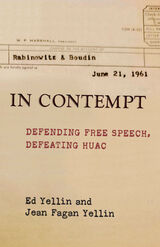 In Contempt: Defending Free Speech, Defeating HUAC
Ed Yellin and Jean Fagan Yellin
University of Michigan Press, 2022 “YOU ARE HEREBY COMMANDED to be and appear before the Committee on Un-American Activities of the House of Representatives of the United States, or a duly appointed subcommittee thereof, on February 10 (Monday), 1958, at ten o’clock a.m. at City Council Chambers, City Hall, Gary, Indiana, then and there to testify touching matters of inquiry committed to said committee, and not to depart without leave of said committee.”
So began a decade of hardship for Ed and Jean Yellin and their three young children as the repressive weight of the U.S. government, caught up in the throes of McCarthyism, crashed down upon their careers, their daily household budget, and their relationships to colleagues, neighbors, and their country. In Contempt is a faithful, factual testament to the enduring quality of patriotic dissent in our evolving democracy—and a loving reconstruction of what it meant to be labeled “unAmerican” for defending the Constitution.
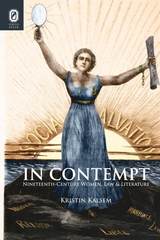 In Contempt: Nineteenth-Century Women, Law, and Literature
Kristin Kalsem
Ohio State University Press, 2012 In Contempt: Nineteenth-Century Women, Law, and Literature, by Kristin Kalsem, explores the legal advocacy performed by nineteenth-century women writers in publications of nonfiction and fiction, as well as in real-life courtrooms and in the legal forum provided by the novel form. The nineteenth century was a period of unprecedented reform in laws affecting married women’s property, child support and custody, lunacy, divorce, birth control, domestic violence, and women in the legal profession. Women’s contributions to these changes in the law, however, have been largely ignored because their work, stories, and perspectives are not recorded in authoritative legal texts; rather, evidence of their arguments and views are recorded in writings of a different kind. This book examines lesser-known works of nonfiction and fiction by legal reformers such as Annie Besant and Georgina Weldon and novelists such as Frances Trollope, Jane Hume Clapperton, George Paston, and Florence Dixie. In Contempt brings to light new connections between Victorian law and literature, not only with its analysis of many “lost” novels but also with its new legal readings of old ones such as Emily Brontë’s Wuthering Heights (1847), George Eliot’s Adam Bede (1859), Lewis Carroll’s Alice’s Adventures in Wonderland (1865), Rider Haggard’s She (1887), and Thomas Hardy’s Jude the Obscure (1895). This study reexamines the cultural and political roles of the novel in light of “new evidence” that many nineteenth-century novels were “lawless”—showing contempt for, rather than policing, the law.
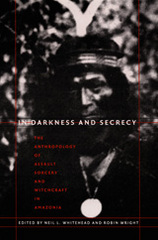 In Darkness and Secrecy: The Anthropology of Assault Sorcery and Witchcraft in Amazonia
Neil L. Whitehead and Robin Wright, eds.
Duke University Press, 2004 In Darkness and Secrecy brings together ethnographic examinations of Amazonian assault sorcery, witchcraft, and injurious magic, or “dark shamanism.” Anthropological reflections on South American shamanism have tended to emphasize shamans’ healing powers and positive influence. This collection challenges that assumption by showing that dark shamans are, in many Amazonian cultures, quite different from shamanic healers and prophets. Assault sorcery, in particular, involves violence resulting in physical harm or even death. While highlighting the distinctiveness of such practices, In Darkness and Secrecy reveals them as no less relevant to the continuation of culture and society than curing and prophecy. The contributors suggest that the persistence of dark shamanism can be understood as a form of engagement with modernity. These essays, by leading anthropologists of South American shamanism, consider assault sorcery as it is practiced in parts of Brazil, Guyana, Venezuela, and Peru. They analyze the social and political dynamics of witchcraft and sorcery and their relation to cosmology, mythology, ritual, and other forms of symbolic violence and aggression in each society studied. They also discuss the relations of witchcraft and sorcery to interethnic contact and the ways that shamanic power may be co-opted by the state. In Darkness and Secrecy includes reflections on the ethical and practical implications of ethnographic investigation of violent cultural practices. Contributors. Dominique Buchillet, Carlos Fausto, Michael Heckenberger, Elsje Lagrou, E. Jean Langdon, George Mentore, Donald Pollock, Fernando Santos-Granero, Pamela J. Stewart, Andrew Strathern, Márnio Teixeira-Pinto, Silvia Vidal, Neil L. Whitehead, Johannes Wilbert, Robin Wright
 In Death's Waiting Room: Living and Dying with Dementia in a Multicultural Society
Anne-Mei The
Amsterdam University Press, 2008
The story behind In Death’s Waiting Room is a penetrating human drama that concerns us all—as our “greatest generation” continues to age, more and more families are contending with the onset of dementia in their elderly parents and grandparents, a trend that will only continue as the global population of senior citizens continues to grow with certain speed. For this remarkable volume, Anne-Marie The carried out two years of hands-on ethnographic research in an Amsterdam nursing home for patients with various forms of dementia. In Death’s Waiting Room reveals what usually remains hidden in these modern-day centers of care: the decision to stop treatment, the poverty and voodoo rituals of the black Caribbean nursing staff looking after predominantly white patients, the difficulties faced—and caused—by relatives, and the tensions and aggressions between residents. This immensely readable and moving volume also shares the touching moments of humor and compassion, while at the same time forcing us to consider our own potential confrontation with dementia, in our own or our parents’ lives. From conversations with underpaid nurses to confrontations with family visitors who insist on prolonging treatment against all odds, this searing book is a truly necessary guide to some of the most wrenching aspects of old age.
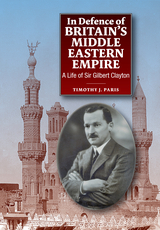 In Defence of Britain's Middle Eastern Empire: A Life of Sir Gilbert Clayton
Timothy J. Paris
Sussex Academic Press, 2022 T E Lawrence (of Arabia) described his war-time chief as "the perfect leader", a man who "worked by influence rather than by loud direction. He was like water, or permeating oil, creeping silently and insistently through everything. It was not possible to say where Clayton was and was not, and how much really belonged to him". This is the first biography of General Sir Gilbert Clayton (1875-1929), Britain's pre-eminent "man-on-the-spot" during the formative years of the modern Middle East. Serving as a soldier, administrator and diplomat in ten different Middle Eastern countries during a 33-year Middle Eastern career, Clayton is best known as the Director of British Intelligence in Cairo during the Great War (1914-16), and as the instigator and sponsor of the Arab Revolt against the Turks. Dedicated to the preservation of Britain's Middle Eastern empire, Clayton came to realize that in the transformed post-war world Britain could ill afford to control all aspects of the emerging nation-states in the region. In his work as adviser to the Egyptian government (1919-22), he advocated internal autonomy for the Egyptians, while asserting Britain's vital imperial interests in the country. As chief administrator in Palestine (1923-5), he sought to reconcile the Arabs to Britain's national home policy for the Jews, and, at the same time, to solidify Britain's position as Mandatory power. In Arabia, Clayton negotiated the first post-war treaties with the emerging power of Ibn Saud, (1925, 1927), but curtailed his designs on the British Mandates in Iraq and Transjordan. And, in Iraq, where Clayton served as High Commissioner (1929), he backed Iraq's independence within the framework of the British Empire.
 In Defence of the Imagination
Helen Gardner
Harvard University Press, 1982 “Learned, lucid, fearless, and funny.”—New Yorker
A spirited indictment of overinterpretation from the grand dame of English literary criticism.
“Minds, like doors and mouths, are made to shut as well as to open,” quips Helen Gardner in her 1979–1980 Charles Eliot Norton Lectures. A vigorous and elegant champion of traditional literary values, Gardner takes aim here at what she sees as a creeping subversion of these values as a “whirl of new doctrines” sweeps through the academy. Deconstruction, the Nouvelle critique, antithetical reading: all these exalt the open-ended interpretations of the theorist and the reader above the work of literature itself. They ask for “a mind so open that it cannot ever be shut on anything.”
In Defence of the Imagination is not, then, a defense of the reader’s right to “import meanings” to the text. Rather it is a defense of the imaginative and intellectual work it takes to understand literature as the author wrote it. It takes imagination to interpret a poem in light of an author’s biography, or to grasp in a deep way the traditions that shaped an individual novel. Still, Gardner believes that the value of literary tradition remains, in an important sense, objective. Giving too much license to readers, whether by assigning only “relevant” contemporary novels to undergraduates or radically reinterpreting Shakespeare’s plays to pander to modern sensibilities, dulls our ability to truly inhabit the literary past and impoverishes our own world in the process.
Pugnacious and charming in equal measure, In Defence of the Imagination ultimately affirms the value of a life devoted to the study of literature. Gardner’s own lucidity, range of reference, and passionate concern for reading are in themselves powerful affirmations of her argument.
In Defense of American Liberties, Second Edition: A History of the ACLU
Samuel Walker
Southern Illinois University Press, 1999 This updated comprehensive history of the American Civil Liberties Union recounts the ACLU's stormy history since its founding in 1920 to fight for free speech and explores its involvement in some of the most famous causes in American history, including the Scopes "monkey trial," the internment of Japanese Americans during World War II, the Cold War anti-Communist witch hunts, and the civil rights movement. The new introduction covers the history of the organization and developments in civil liberties in the 1990s, including the U.S. Supreme Court's declaration of the Communications Decency Act as unconstitutional in ACLU v. Reno.
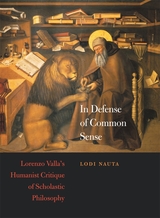 In Defense of Common Sense: Lorenzo Valla's Humanist Critique of Scholastic Philosophy
Lodi Nauta
Harvard University Press, 2009 One of the leading humanists of Quattrocento Italy, Lorenzo Valla (ca. 1406–1457) has been praised as a brilliant debunker of medieval scholastic philosophy. In this book Lodi Nauta seeks a more balanced assessment, presenting us with the first comprehensive analysis of the humanist’s attempt at radical reform of Aristotelian scholasticism.
This study examines Valla’s attack on major tenets of Aristotelian metaphysics, showing how Valla employed common sense and linguistic usage as his guides. It then explicates Valla’s critique of Aristotelian psychology and natural philosophy and discusses his moral and religious views, including Valla’s notorious identification of Christian beatitude with Epicurean pleasure and his daring views on the Trinity. Finally, it takes up Valla’s humanist dialectic, which seeks to transform logic into a practical tool measured by persuasiveness and effectiveness.
Nauta firmly places Valla’s arguments and ideas within the contexts of ancient and medieval philosophical traditions as well as renewed interest in ancient rhetoric in the Renaissance. He also demonstrates the relevance of Valla’s conviction that the philosophical problems of the scholastics are rooted in a misunderstanding of language. Combining philosophical exegesis and historical scholarship, this book offers a new approach to a major Renaissance thinker.
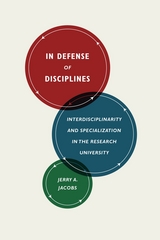 In Defense of Disciplines: Interdisciplinarity and Specialization in the Research University
Jerry A. Jacobs
University of Chicago Press, 2014 Calls for closer connections among disciplines can be heard throughout the world of scholarly research, from major universities to the National Institutes of Health. In Defense of Disciplines presents a fresh and daring analysis of the argument surrounding interdisciplinarity. Challenging the belief that blurring the boundaries between traditional academic fields promotes more integrated research and effective teaching, Jerry Jacobs contends that the promise of interdisciplinarity is illusory and that critiques of established disciplines are often overstated and misplaced.
Drawing on diverse sources of data, Jacobs offers a new theory of liberal arts disciplines such as biology, economics, and history that identifies the organizational sources of their dynamism and breadth. Illustrating his thesis with a wide range of case studies including the diffusion of ideas between fields, the creation of interdisciplinary scholarly journals, and the rise of new fields that spin off from existing ones, Jacobs turns many of the criticisms of disciplines on their heads to mount a powerful defense of the enduring value of liberal arts disciplines. This will become one of the anchors of the case against interdisciplinarity for years to come.
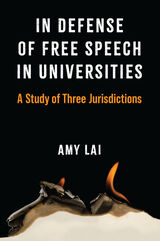 In Defense of Free Speech in Universities: A Study of Three Jurisdictions
Amy Lai
University of Michigan Press, 2023 In this book, Amy Lai examines the current free speech crisis in Western universities. She studies the origin, history, and importance of freedom of speech in the university setting, and addresses the relevance and pitfalls of political correctness and microaggressions on campuses, where laws on harassment, discrimination, and hate speech are already in place, along with other concepts that have gained currency in the free speech debate, including deplatforming, trigger warning, and safe space. Looking at numerous free speech disputes in the United Kingdom, the United States, and Canada, the book argues for the equal application of the free speech principle to all expressions to facilitate respectful debates. All in all, it affirms that the right to free expression is a natural right essential to the pursuit of truth, democratic governance, and self-development, and this right is nowhere more important than in the university.
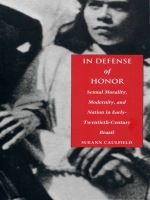 In Defense of Honor: Sexual Morality, Modernity, and Nation in Early-Twentieth-Century Brazil
Sueann Caulfield
Duke University Press, 2000 In this book Sueann Caulfield explores the changing meanings of honor in early-twentieth-century Brazil, a period that saw an extraordinary proliferation of public debates that linked morality, modernity, honor, and national progress. With a close examination of legal theory on sexual offenses and case law in Rio de Janeiro from the end of World War I to the early years of the Estado Novo dictatorship, Caulfield reveals how everyday interpretations of honor influenced official attitudes and even the law itself as Brazil attempted to modernize.
While some Brazilian elites used the issue of sexual purity to boast of their country’s moral superiority, others claimed that the veneration of such concepts as virginity actually frustrated efforts at modernization. Moreover, although individuals of all social classes invoked values they considered “traditional,” such as the confinement of women’s sexuality within marriage, these values were at odds with social practices—such as premarital sex, cohabitation, divorce, and female-headed households—that had been common throughout Brazil’s history. The persistence of these practices, together with post-World War I changes in both official and popular moral ideals, presented formidable obstacles to the Estado Novo’s renewed drive to define and enforce public morality and private family values in the late 1930s.
With sophisticated theoretical underpinnings, In Defense of Honor is written in a clear and lively manner, making it accessible to students and scholars in a variety of disciplines, including Brazilian and Latin American studies, gender studies, and legal history.
 In Defense Of Human Dignity
Kraynak & Tinder
University of Notre Dame Press, 2003 Robert Kraynak and Glenn Tinder contend that the major challenge of our time is to recover a true and authentic understanding of human dignity and to defend it against threats from modern civilization. In Defense of Human Dignity wrestles with the dilemma that contemporary society has developed a heightened sensitivity to the demands of human dignity while creating radically new dangers to humanity in the form of the totalitarian state, modern technology, genetic engineering, the practical ethics movement, and radical environmentalism.
Representing diverse viewpoints, the authors of this volume explore what is meant by "human dignity" and related notions, such as the "sanctity of life." The authors not only defend human dignity - drawing upon principles from Kantian ethics, theories of human rights, the Bible, and Christian theology - they also examine the limitations and problems of misguided conceptions of human dignity.
The inspiration for this volume is the publication twenty years ago of the Covey Lectures by Glenn Tinder under the title Against Fate, in which Tinder argued that the sanctity of every individual is the central moral intuition of the Western tradition. Using Tinder's essay as a starting point, the contributors develop his themes in different directions, producing a stunning collection of essays that focus on the philosophical and religious basis of human dignity while showing the variety of ways it can be understood and defended today.
ROBERT P. KRAYNAK is professor of political science at Colgate University. He is the author of Christian Faith and Modern Democracy, published by the University of Notre Dame Press.
GLENN TINDER is professor emeritus of political science at the University of Massachusetts, Boston. He is the author of Against Fate, published by the University of Notre Dame Press
----------
"…those committed to liberalism need to defend it against its despisers. …In Defense of Human Dignity is an important book that recognizes this challenge. I recommend it for scholars and citizens who are concerned about liberalism's future." --Markets & Morality
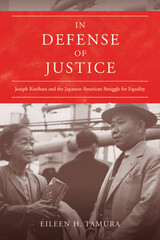 In Defense of Justice: Joseph Kurihara and the Japanese American Struggle for Equality
Eileen H. Tamura
University of Illinois Press, 2013 As a leading dissident in the World War II concentration camps for Japanese Americans, the controversial figure Joseph Yoshisuke Kurihara stands out as an icon of Japanese American resistance. In emotional, often inflammatory speeches, Kurihara attacked the U.S. government for its treatment of innocent citizens and immigrants. Because he articulated what other inmates dared not voice openly, he became a spokesperson for camp inmates. In this astute biography, Kurihara's life provides a window into the history of Japanese Americans during the first half of the twentieth century. Born in Hawai'i to Japanese parents who immigrated to work on the sugar plantations, Kurihara worked throughout his youth and early adult life to make a place for himself as an American: seeking quality education, embracing Christianity, and serving as a soldier in the U.S. Army during World War I. Though he bore the brunt of anti-Japanese hostility in the decades before World War II, he remained adamantly positive about the prospects of his own life in America. The U.S. entry into World War II and the forced removal and incarceration of ethnic Japanese destroyed that perspective and transformed Kurihara. As an inmate at Manzanar in California, Kurihara became one of the leaders of a dissident group within the camp and was implicated in "the Manzanar incident," a serious civil disturbance that erupted on December 6, 1942. In 1945, after three years and seven months of incarceration, he renounced his U.S. citizenship and boarded a ship for Japan, where he had never been before. He never returned to the United States. Kurihara's personal story illuminates the tragedy of the forced removal and incarceration of U.S. citizens among the West Coast Nikkei, even as it dramatizes the heroic resistance to that injustice. Shedding light on the turmoil within the camps as well as the sensitive and formerly unspoken issue of citizenship renunciation among Japanese Americans, In Defense of Justice explores one man's struggles with the complexities of loyalty and resistance.
In Defense of La Raza: The Los Angeles Mexican Consulate and the Mexican Community, 1929 to 1936
Francisco E. Balderrama
University of Arizona Press, 1982 Mexican communities in the United States faced more than unemployment during the Great Depression. Discrimination against Mexican nationals and similar prejudices against Mexican Americans led the communities to seek help from Mexican consulates, which in most cases rose to their defense.
Los Angeles’s consulate was confronted with the country’s largest concentration of Mexican Americans, for whom the consuls often assumed a position of community leadership. Whether helping the unemployed secure repatriation and relief or intervening in labor disputes, consuls uniquely adapted their roles in international diplomacy to the demands of local affairs.
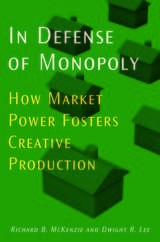 In Defense of Monopoly: How Market Power Fosters Creative Production
Richard B. McKenzie and Dwight R. Lee
University of Michigan Press, 2008 In Defense of Monopoly offers an unconventional but empirically grounded argument in favor of market monopolies. Authors McKenzie and Lee claim that conventional, static models exaggerate the harm done by real-world monopolies, and they show why some degree of monopoly presence is necessary to maximize the improvement of human welfare over time. Inspired by Joseph Schumpeter's suggestion that market imperfections can drive an economy's long-term progress, In Defense of Monopoly defies conventional assumptions to show readers why an economic system's failure to efficiently allocate its resources is actually a necessary precondition for maximizing the system's long-term performance: the perfectly fluid, competitive economy idealized by most economists is decidedly inferior to one characterized by market entry and exit restrictions or costs. An economy is not a board game in which players compete for a limited number of properties, nor is it much like the kind of blackboard games that economists use to develop their monopoly models. As McKenzie and Lee demonstrate, the creation of goods and services in the real world requires not only competition but the prospect of gains beyond a normal competitive rate of return.
|
|

